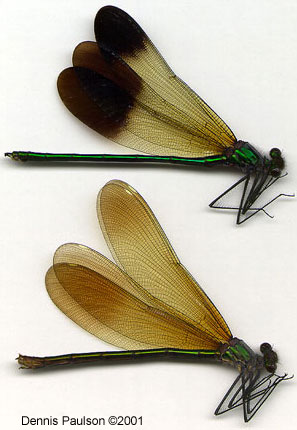
Calopteryx (Agrion) aequibilis
(River Jewelwing)
Order: Odonata
Suborder: Zygoptera
Order Description: Damselflies
Family: Calopterygidae (Agriidae)
Family Description: Jewelwing
Description:
Naiad-This is a long, slender naiad, or immature damselfly, about 1 ― inches (35 - 40 mm) long. It also has very long legs. It is light brown with dark markings.
Adult-This is a large damselfly about 1 ū to 2 ž inches long (45 to 52 mm). The build is robust, especially in the females. The color is an unmistakable iridescent green or blue. The outer third of the wing is black.
Range:
This damselfly is found from southern British Columbia to Nova Scotia and south to New Jersey, Colorado, and Washington. In Idaho it is found at streams and rivers in the lower elevation areas of the state.
Habitat:
This species is found at streams and rivers.
Adult Flight Season:
June 18 to September8
Diet:
Naiad-Naiads eat a wide variety of aquatic insects, including mosquito larvae, mayfly larvae, and other aquatic fly larvae.
Adult-Adults eat a wide variety of small soft-bodied flying insects, such as mosquitoes, mayflies, flies and small moths.
Ecology:
This damselfly is found along large streams and rivers. The naiads live in underwater tree roots and aquatic vegetation.
Reproduction:
The River Jewelwing is the only dragonfly or damselfly species from our area in which the males actually court the females. A male will flutter back and forth in front of a perched female to attract her attention. After mating, the female backs down the stem of an aquatic plant until she is a foot or more underwater, and lays her eggs in the stem of the plant. She then floats or swims to the surface and flies away. The eggs hatch in 18 to 30 days and the naiads take 2 to 3 years to mature.
Conservation:
Populations are widespread, abundant, and secure.
| Global Rank: | G5 |
| State Rank: | S? |
References:
Corbet, P. S. 1999. Dragonflies: Behavior and Ecology of Odonata. Cornell University Press, Ithaca, New York, USA, 829pp.
Logan, E. R. 1967. The Odonata of Idaho. Unpublished M. S. thesis. University of Idaho, Moscow, Idaho, USA, 105 pp.
Needham, J. G. and M. J. Westfall. 1955. Dragonflies of North America. University of California Press, Berkely, California, USA, 615 pp.
Paulson, D. R. 1999. Dragonflies of Washington. Seattle Audubon Society, Seattle, Washington, USA, 32 pp.
Walker, E. M. and P. S. Corbet. 1975. The Odonata of Canada and Alaska, Vol. III. University of Toronto Press, Toronto, Ontario, Canada, 307 pp.
Written by Mark Lung and Stefan Sommer, 2001
Photos by Dennis Paulson, 2001
Design by Ean Harker, 2001.
HTML by Marty Peck, 2001.
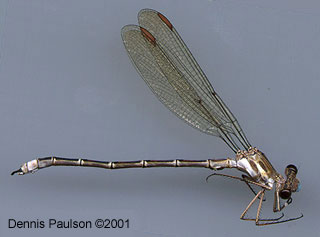
Archilestes californica
(California Spreadwing)
Order: Odonata
Suborder: Zygoptera
Order Description: Damselflies
Family: Lestidae
Family Description: Spreadwing
Description:
Naiad- This is a long naiad 1 to 1 ¼ inches (25 to 30 mm) long. It has the typical slender damselfly shape. The coloration is dark brown with a light stripe down the center of the upper surface of the abdomen.
Adult- This is a large damselfly 1 ¾ to 2 ¼ inches (41 to 55 mm) long. The build is slender with short wings in proportion to the length of the abdomen. The thorax is black with no iridescent green or bronze. This is Idaho's largest Spreadwing.
Range:
This damselfly is found from south-central Washington south to Baja California, Arizona, and New Mexico, and east to western Idaho. In Idaho it is found only in the lower Clearwater River valley.
Habitat:
This species is found at slow streams.
Adult Flight Season:
October 2 to October 16
Diet:
Naiad- A wide variety of aquatic insects, including mosquito larvae, mayfly larvae, and other aquatic fly larvae.
Adult- A wide variety of small soft-bodied flying insects, such as mosquitoes, mayflies, flies and small moths.
Ecology:
The naiads live in pools and backeddies. The adult damselfly perches on vegetation with its wings spread. It's found at slow streams in the warmest areas of our state.
Reproduction:
After males and females mate, the female California Spreadwing oviposits in tandem (with the male attached) in vegetation that overhangs slow streams. The eggs overwinter and hatch in the spring.
Conservation:
Populations are widespread, abundant, and secure.
| Global Rank: | G5 |
| State Rank: | S? |
References:
Corbet, P. S. 1999. Dragonflies: Behavior and Ecology of Odonata. Cornell University Press, Ithaca, New York, USA, 829pp.
Logan, E. R. 1967. The Odonata of Idaho. Unpublished M. S. thesis. University of Idaho, Moscow, Idaho, USA, 105 pp.
Needham, J. G. and M. J. Westfall. 1955. Dragonflies of North America. University of California Press, Berkely, California, USA, 615 pp.
Paulson, D. R. 1999. Dragonflies of Washington. Seattle Audubon Society, Seattle, Washington, USA, 32 pp.
Walker, E. M. and P. S. Corbet. 1975. The Odonata of Canada and Alaska, Vol. III. University of Toronto Press, Toronto, Ontario, Canada, 307 pp.
Written by Mark Lung and Stefan Sommer, 2001
Photos by Dennis Paulson, 2001
Design by Ean Harker, 2001.
HTML by Marty Peck, 2001.
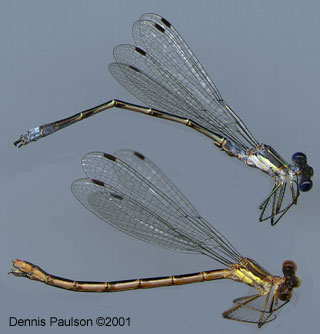
Lestes Disjunctus
(Common Spreadwing)
Order: Odonata
Suborder: Zygoptera
Order Description: Damselflies
Family: Lestidae
Family Description: Spreadwing
Description:
Naiad- This is a long naiad 1 to 1 ž inches (23 to 29 mm) long. It has the typical slender damselfly shape. The color is medium to dark brown.
Adult- This is a large damselfly 1 ž to 1 ū inches (30 to 41 mm) long. The build is slender with short wings in proportion to the length of the abdomen. The thorax is bronze-black with a yellow stripe down the center on the upper surface. In the males, the lower anal appendages are more than half as long as the upper appendages.
Range:
This damselfly has an extensive range. It is found from Alaska across northern Canada to Labrador, and south to Florida and California. In Idaho it is found throughout the state.
Habitat:
This species is found at a wide range of aquatic habitats, but is most numerous in weedy ponds, marshes, and slow streams.
Adult Flight Season:
July 4 to October 17
Diet:
Naiad- Naiads eat a wide variety of aquatic insects, including mosquito larvae, mayfly larvae, and other aquatic fly larvae.
Adult- Adults eat a wide variety of small soft-bodied flying insects, such as mosquitoes, mayflies, flies and small moths.
Ecology:
This species is extremely widespread, and tends to be very abundant in its favored habitats. At the large marsh north of Bear Lake this species swarms in late summer, together with the Spotted Spreadwing (L. congener), and the Lyre-tipped Spreadwing (L. unguiculatus). The naiads are very active, rapacious hunters, which makes them vulnerable to predation by fish. As a result, they are often found in shallow marshes and ponds areas that may dry up in summer, and thus lacks fish. However, this species does occur in permanent bodies of water as well. The naiads have from the time the pond fills up in the spring to when it dries up in the summer to mature and emerge.
Reproduction:
After males and females mate, the female Common Spreadwing flies in tandem to oviposit in vegetation that is growing out of the water. She usually lays her eggs well above the waterline.
Conservation:
Populations are widespread, abundant, and secure.
| Global Rank: | G5 |
| State Rank: | S? |
References:
Corbet, P. S. 1999. Dragonflies: Behavior and Ecology of Odonata. Cornell University Press, Ithaca, New York, USA, 829pp.
Logan, E. R. 1967. The Odonata of Idaho. Unpublished M. S. thesis. University of Idaho, Moscow, Idaho, USA, 105 pp.
Needham, J. G. and M. J. Westfall. 1955. Dragonflies of North America. University of California Press, Berkely, California, USA, 615 pp.
Paulson, D. R. 1999. Dragonflies of Washington. Seattle Audubon Society, Seattle, Washington, USA, 32 pp.
Walker, E. M. and P. S. Corbet. 1975. The Odonata of Canada and Alaska, Vol. III. University of Toronto Press, Toronto, Ontario, Canada, 307 pp.
Written by Mark Lung and Stefan Sommer, 2001
Photos by Dennis Paulson, 2001
Design by Ean Harker, 2001.

Lestes Unguiculatus
(Lyre-tipped Spreadwing)
Order: Odonata
Suborder: Zygoptera
Order Description: Damselflies
Family: Lestidae
Family Description: Spreadwing
Description:
Naiad- This is a long naiad a bit over 1 inch (27 to 28 mm) long. It has the typical slender damselfly shape. The color is medium to dark brown.
Adult- This is a large damselfly 1 ž to 1 ū inches (30 to 41 mm) long. The build is slender with short wings in proportion to the length of the abdomen. Both the males and females are mostly bronzy-green on the upper surface of the thorax and abdomen. The lower pair of anal appendages is "S"shaped with the tips pointing outwards when viewed from above.
Range:
This species is found across North America from southern British Columbia east to Nova Scotia and south to New Jersey, Tennessee, Oklahoma, and California. In Idaho it is found throughout the state.
Habitat:
This damselfly is found at ponds that are exposed to the sun, and it seems to prefer ponds that dry up in the summer. The naiads do well in alkaline water.
Adult Flight Season:
June 30 to August 27
Diet:
Naiad- Naiads eat a wide variety of aquatic insects, including mosquito larvae, mayfly larvae, and other aquatic fly larvae.
Adult- The damselfly eats a wide variety of small soft-bodied flying insects, such as mosquitoes, mayflies, flies and small moths.
Ecology:
This species can be incredibly abundant at large sedge marshes, such as the one north of Bear Lake. The naiads are very active, rapacious hunters, and because of this, are vulnerable to predation by fish. As a result they are generally found in shallow marshes and ponds that may dry up in summer and thus lack fish. The naiads mature and emerge in the short period from the time the pond fills in the spring to when it dries in the summer.
Reproduction:
After males and females mate, the female Lyre-tipped Spreadwing lays eggs well above the waterline on vegetation that grows out of water. Where populations are extremely dense they can actually damage the plants on which they lay their eggs.
Conservation:
Populations are widespread, abundant, and secure.
| Global Rank: | G5 |
| State Rank: | S? |
References:
Corbet, P. S. 1999. Dragonflies: Behavior and Ecology of Odonata. Cornell University Press, Ithaca, New York, USA, 829pp.
Logan, E. R. 1967. The Odonata of Idaho. Unpublished M. S. thesis. University of Idaho, Moscow, Idaho, USA, 105 pp.
Needham, J. G. and M. J. Westfall. 1955. Dragonflies of North America. University of California Press, Berkely, California, USA, 615 pp.
Paulson, D. R. 1999. Dragonflies of Washington. Seattle Audubon Society, Seattle, Washington, USA, 32 pp.
Walker, E. M. and P. S. Corbet. 1975. The Odonata of Canada and Alaska, Vol. III. University of Toronto Press, Toronto, Ontario, Canada, 307 pp.
Written by Mark Lung and Stefan Sommer, 2001
Photos by Dennis Paulson, 2001
Design by Ean Harker, 2001.
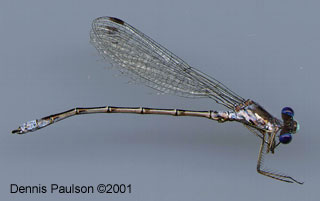
Lestes congener
(Spotted Spreadwing)
Order: Odonata
Suborder: Zygoptera
Order Description: Damselflies
Family: Lestidae
Family Description: Spreadwing
Description:
Naiad- This is a long naiad about 1 inch (22 to 26 mm) long. It has the typical slender damselfly shape. The coloration is medium to dark brown.
Adult- This is a large damselfly 1 ź to 1 ž inches (30 to 41 mm) long. The build is slender with short wings in proportion to the length of the abdomen. The thorax is bronze-black with a yellow stripe down the center on the upper surface. In the males, the lower anal appendages are less than half as long as the upper appendages.
Range:
This damselfly has an extensive range. It is found from British Columbia east to Nova Scotia, and south to New Jersey, New Mexico, and California. In Idaho it is found throughout the state.
Habitat:
This species is found at ponds with shorelines heavily vegetated with cattails, bulrushes or sedges.
Adult Flight Season:
June 26 to October 15
Diet:
Naiad- A wide variety of aquatic insects, including mosquito larvae, mayfly larvae, and other aquatic fly larvae.
Adult- A wide variety of small soft-bodied flying insects, such as mosquitoes, mayflies, flies and small moths.
Ecology:
This species is widespread, and tends to be very abundant in its favored habitats. At the large marsh north of Bear Lake this species swarms in late summer, together with the Common Spreadwing (L. congener), and the Lyre-tipped Spreadwing (L. unguiculatus). The naiads are very active, rapacious hunters, and are thus vulnerable to predation by fish. As a result, they are often found in shallow marshes and ponds that may dry up in summer. However, this species does occur in permanent bodies of water as well.
Reproduction:
After males and females mate, the female Spotted Spreadwing oviposits in tandem in vegetation 1 to 3 inches over the waterline. During mating times they can be very numerous. At one location, the density of Spotted Spreadwing pairs laying their eggs was about 4 per square foot.
Conservation:
Populations are widespread, abundant, and secure.
| Global Rank: | G5 |
| State Rank: | S? |
References:
Corbet, P. S. 1999. Dragonflies: Behavior and Ecology of Odonata. Cornell University Press, Ithaca, New York, USA, 829pp.
Logan, E. R. 1967. The Odonata of Idaho. Unpublished M. S. thesis. University of Idaho, Moscow, Idaho, USA, 105 pp.
Needham, J. G. and M. J. Westfall. 1955. Dragonflies of North America. University of California Press, Berkely, California, USA, 615 pp.
Paulson, D. R. 1999. Dragonflies of Washington. Seattle Audubon Society, Seattle, Washington, USA, 32 pp.
Walker, E. M. and P. S. Corbet. 1975. The Odonata of Canada and Alaska, Vol. III. University of Toronto Press, Toronto, Ontario, Canada, 307 pp.
Written by Mark Lung and Stefan Sommer, 2001
Photos by Dennis Paulson, 2001
Design by Ean Harker, 2001.
HTML by Marty Peck, 2001.
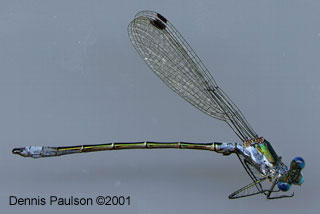
Lestes Dryas
(Emerald Spreadwing)
Order: Odonata
Suborder: Zygoptera
Order Description: Damselflies
Family: Lestidae
Family Description: Spreadwing
Description:
Naiad- This is a long naiad a bit over 1 inch (27 to 28 mm) long. It has the typical slender damselfly shape. The color is medium to dark brown.
Adult- This is a large damselfly 1 ź to 1 ž inches (30 to 41 mm) long. The build is slender with short wings in proportion to the length of the abdomen. This damselfly is a uniform dark iridescent green on the upper surfaces of both the thorax and abdomen.
Range:
This damselfly has an extremely extensive range. It is found around the world, from northern Europe and Asia to Alaska and across northern Canada to Labrador and Nova Scotia, and south to New Jersey and California. In Idaho it is found throughout the state.
Habitat:
This species is found at ponds that are partly shaded, and it seems to prefer ponds that dry up in the summer. The naiads do well in alkaline water.
Adult Flight Season:
June 29 to August 23
Diet:
Naiad- Naiads eat a wide variety of aquatic insects, including mosquito larvae, mayfly larvae, and other aquatic fly larvae.
Adult- Adults eat a wide variety of small soft-bodied flying insects, such as mosquitoes, mayflies, flies and small moths.
Ecology:
This species is extremely widespread, but is rarely as abundant in any given location as other members of this genus. The naiads are very active, rapacious hunters, which makes them vulnerable to predation by fish. As a result, they are often found in shallow marshes and ponds that may dry up in the summer, and thus lack fish. However, they have been observed in permanent bodies of water as well. The naiads mature and emerge in the short period from the time the pond fills in the spring to when it dries in the summer. Emerald Spreadwings emerge earlier than the other members of this genus.
Reproduction:
After males and females mate, the female Emerald Spreadwing oviposits in tandem in emergent vegetation well above the waterline.
Conservation:
Populations are widespread, abundant, and secure.
| Global Rank: | G5 |
| State Rank: | S? |
References:
Corbet, P. S. 1999. Dragonflies: Behavior and Ecology of Odonata. Cornell University Press, Ithaca, New York, USA, 829pp.
Logan, E. R. 1967. The Odonata of Idaho. Unpublished M. S. thesis. University of Idaho, Moscow, Idaho, USA, 105 pp.
Needham, J. G. and M. J. Westfall. 1955. Dragonflies of North America. University of California Press, Berkely, California, USA, 615 pp.
Paulson, D. R. 1999. Dragonflies of Washington. Seattle Audubon Society, Seattle, Washington, USA, 32 pp.
Walker, E. M. and P. S. Corbet. 1975. The Odonata of Canada and Alaska, Vol. III. University of Toronto Press, Toronto, Ontario, Canada, 307 pp.
Written by Mark Lung and Stefan Sommer, 2001
Photos by Dennis Paulson, 2001
Design by Ean Harker, 2001.
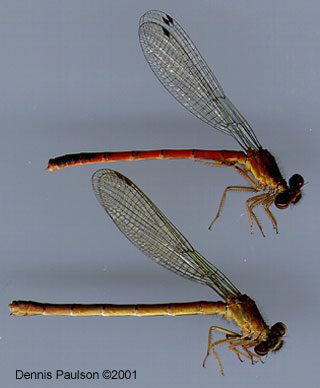
Amphiagrion abbreviatum
(Western Red Damsel)
Order: Odonata
Suborder: Zygoptera
Order Description: Damselflies
Family: Coenagrionidae
Family Description: Damsel
Description:
Naiad-This is a small, somewhat stocky naiad ū inch (19 mm) long. The coloration is light brown with dark brown markings.
Adult-This is a small damselfly 1 to 1 ž inches (26 to 28 mm) long. The build is stocky with short legs and abdomens. The males are the only red damselflies in our area. The thorax is black. The females are variable in color. They may be red and black colored very similarly to the males, or they may be a uniform reddish-brown.
Range:
This species is found from British Columbia east to Saskatchewan and south to Oklahoma, Nevada, and California. In Idaho, it is found throughout the state.
Habitat:
This damselfly is usually found at flooded meadows or shallow ponds with vegetation, such as sedges or grasses, growing out of the water along the shore.
Adult Flight Season:
May 1 to August 24
Diet:
Naiad-Naiads eat a wide variety of aquatic insects, including mosquito larvae, mayfly larvae, and other aquatic fly larvae.
Adult-Adults eat a wide variety of small soft-bodied flying insects, such as mosquitoes, mayflies, flies and small moths. They will also pick small insects such as aphids from plants.
Ecology:
This species is found in a variety of habitats, but is usually associated with grasses or sedges that extend out into the water. The adults stay close to the vegetation and rarely fly out in the open.
Reproduction:
The female Western Red Damsel oviposits either singly or in tandem, usually in floating mats of vegetation.
Conservation:
Populations are widespread, abundant, and secure.
| Global Rank: | G5 |
| State Rank: | S? |
References:
Corbet, P. S. 1999. Dragonflies: Behavior and Ecology of Odonata. Cornell University Press, Ithaca, New York, USA, 829pp.
Logan, E. R. 1967. The Odonata of Idaho. Unpublished M. S. thesis. University of Idaho, Moscow, Idaho, USA, 105 pp.
Needham, J. G. and M. J. Westfall. 1955. Dragonflies of North America. University of California Press, Berkely, California, USA, 615 pp.
Paulson, D. R. 1999. Dragonflies of Washington. Seattle Audubon Society, Seattle, Washington, USA, 32 pp.
Walker, E. M. and P. S. Corbet. 1975. The Odonata of Canada and Alaska, Vol. III. University of Toronto Press, Toronto, Ontario, Canada, 307 pp.
Written by Mark Lung and Stefan Sommer, 2001
Photos by Dennis Paulson, 2001
Design by Ean Harker, 2001.
HTML by Marty Peck, 2001.
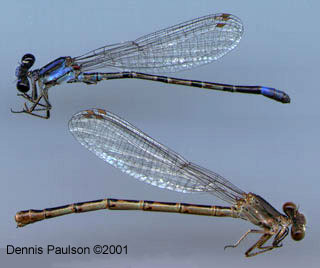
Argia alberta
(Paiute Dancer)
Order: Odonata
Suborder: Zygoptera
Order Description: Damselflies
Family: Coenagrionidae
Family Description: Dancer
Description:
Naiad-This is a small, but robust naiad ū inch (20 to 21 mm) long. The coloration is light brown with dark brown markings.
Adult-This is a small damselfly 1 to 1 ž inches (27 to 32 mm) long. The males are blue on the sides of the thorax and abdomen, and mostly black above. The females are variable in color. They can be blue, or olive, or tan in color, with much less black than the males.
Range:
This species is found from southern Idaho east to South Dakota and south to Kansas, New Mexico, and California. In Idaho it is found in the southern half of the state.
Habitat:
This damselfly is found at streams, and in the northern part of its range at hot springs.
Adult Flight Season:
June 4 to July 5
Diet:
Naiad-Naiads eat a wide variety of aquatic insects, including mosquito larvae, mayfly larvae, and other aquatic fly larvae.
Adult-Adults eat a wide variety of small soft-bodied flying insects, such as mosquitoes, mayflies, flies and small moths. They will also pick small insects such as aphids from plants.
Ecology:
Very little is known about the ecology of this species.
Reproduction:
The males patrol territories at choice breeding locations along small streams. After males and females mate, the male remains attached to the female as she oviposits.
Conservation:
Populations are widespread, abundant, and secure.
| Global Rank: | G5 |
| State Rank: | S? |
References:
Corbet, P. S. 1999. Dragonflies: Behavior and Ecology of Odonata. Cornell University Press, Ithaca, New York, USA, 829pp.
Logan, E. R. 1967. The Odonata of Idaho. Unpublished M. S. thesis. University of Idaho, Moscow, Idaho, USA, 105 pp.
Needham, J. G. and M. J. Westfall. 1955. Dragonflies of North America. University of California Press, Berkely, California, USA, 615 pp.
Paulson, D. R. 1999. Dragonflies of Washington. Seattle Audubon Society, Seattle, Washington, USA, 32 pp.
Walker, E. M. and P. S. Corbet. 1975. The Odonata of Canada and Alaska, Vol. III. University of Toronto Press, Toronto, Ontario, Canada, 307 pp.
Written by Mark Lung and Stefan Sommer, 2001
Photos by Dennis Paulson, 2001
Design by Ean Harker, 2001.
HTML by Marty Peck, 2001.
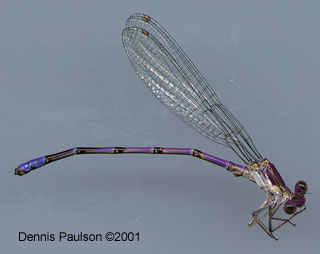
Argia emma
(Emma's Dancer)
Order: Odonata
Suborder: Zygoptera
Order Description: Damselflies
Family: Coenagrionidae
Family Description: Dancer
Description:
Naiad-This is a small, but robust naiad ž inch (20 to 21 mm) long. The coloration is light brown with dark brown markings.
Adult-This is a medium-sized damselfly 1 ź to 1 ˝ inches (33 to 39 mm) long. The males are a bright violet color, and are the only damselflies with this color in our area. The females are variable in color. They can be creamy white to dark brown in color, or olive, or slate blue. They have a pair of black spots on the upper side of segment two.
Range:
This species is found in eastern British Columbia and Alberta south to Nebraska, Nevada, and California. In Idaho it is found throughout the state.
Habitat:
This damselfly is found at streams and rivers, or along lake shores near inlet or outlet streams.
Adult Flight Season:
June 23 to August 12
Diet:
Naiad-Naiads eat a wide variety of aquatic insects, including mosquito larvae, mayfly larvae, and other aquatic fly larvae.
Adult-Adults eat a wide variety of small soft-bodied flying insects, such as mosquitoes, mayflies, flies and small moths. They will also pick small insects such as aphids from plants.
Ecology:
This species is abundant along streams flowing through sagebrush desert. The naiads live under rocks in riffles or under debris in pools.
Reproduction:
After males and females mate, the female Emma's Dancer oviposits in tandem in submerged tree roots in streams. The females crawl backward down the roots until their abdomen is submerged. The male remains attached by grasping behind the female's head with his anal appendages.
Conservation:
Populations are widespread, abundant, and secure.
| Global Rank: | G5 |
| State Rank: | S? |
References:
Corbet, P. S. 1999. Dragonflies: Behavior and Ecology of Odonata. Cornell University Press, Ithaca, New York, USA, 829pp.
Logan, E. R. 1967. The Odonata of Idaho. Unpublished M. S. thesis. University of Idaho, Moscow, Idaho, USA, 105 pp.
Needham, J. G. and M. J. Westfall. 1955. Dragonflies of North America. University of California Press, Berkely, California, USA, 615 pp.
Paulson, D. R. 1999. Dragonflies of Washington. Seattle Audubon Society, Seattle, Washington, USA, 32 pp.
Walker, E. M. and P. S. Corbet. 1975. The Odonata of Canada and Alaska, Vol. III. University of Toronto Press, Toronto, Ontario, Canada, 307 pp.
Written by Mark Lung and Stefan Sommer, 2001
Photos by Dennis Paulson, 2001
Design by Ean Harker, 2001.
HTML by Marty Peck, 2001.
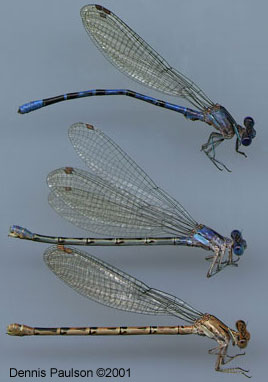
Argia vivida
(Vivid Dancer)
Order: Odonata
Suborder: Zygoptera
Order Description: Damselflies
Family: Coenagrionidae
Family Description: Dancer
Description:
Naiad-This is a small, but stocky naiad about ū inch (17 mm) long. The coloration is mottled dark brown.
Adult-This is a small damselfly 1 ž to 1 ― inches (29 to 35 mm) long. The males at first glance look like Bluets, but they are a vivid electric blue. The dark stripe on the upper thorax becomes a fine line about half the way down. The upper surface of the abdomen is predominately blue, except for segment seven, which is black with a blue spot. Females are tan, and are patterned very similarly to the males.
Range:
This species is found in eastern British Columbia and Alberta south to Texas, New Mexico, and Baja California. In Idaho, it is found throughout the state.
Habitat:
This damselfly is found at spring-fed streams, usually in arid or semi-arid areas.
Adult Flight Season:
April 15 to October 25
Diet:
Naiad-Naiads eat a wide variety of aquatic insects, including mosquito larvae, mayfly larvae, and other aquatic fly larvae.
Adult-Adults eat a wide variety of small soft-bodied flying insects, such as mosquitoes, mayflies, flies and small moths. They will also pick small insects such as aphids from plants.
Ecology:
This species is very closely associated with spring-fed streams, and generally remains close to where it emerged. It probably has the longest flight season of any dragonfly or damselfly in our area.
Reproduction:
The males set up territories at choice breeding sites. After males and females mate, the male remains attached to the female (called "in tandem") as she oviposits in vegetation at spring-fed streams.
Conservation:
Populations are widespread, abundant, and secure.
| Global Rank: | G5 |
| State Rank: | S? |
References:
Corbet, P. S. 1999. Dragonflies: Behavior and Ecology of Odonata. Cornell University Press, Ithaca, New York, USA, 829pp.
Logan, E. R. 1967. The Odonata of Idaho. Unpublished M. S. thesis. University of Idaho, Moscow, Idaho, USA, 105 pp.
Needham, J. G. and M. J. Westfall. 1955. Dragonflies of North America. University of California Press, Berkely, California, USA, 615 pp.
Paulson, D. R. 1999. Dragonflies of Washington. Seattle Audubon Society, Seattle, Washington, USA, 32 pp.
Walker, E. M. and P. S. Corbet. 1975. The Odonata of Canada and Alaska, Vol. III. University of Toronto Press, Toronto, Ontario, Canada, 307 pp.
Written by Mark Lung and Stefan Sommer, 2001
Photos by Dennis Paulson, 2001
Design by Ean Harker, 2001.
HTML by Marty Peck, 2001.
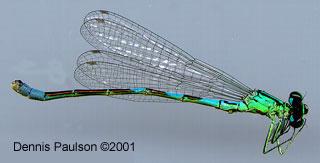
Coenagrion resolutum
(Taiga Bluet)
Order: Odonata
Suborder: Zygoptera
Order Description: Damselflies
Family: Coenagrionidae
Family Description: Bluet
Description:
Naiad-This is a small naiad about one inch (21 to 22 mm) long. It has the typical slender shape of immature damselflies. They range in color from green to light brown.
Adult-This is a small damselfly 1 ¼ to 1 ½ inches (31 to 37 mm) long. The males are predominately blue on the sides of the thorax, and the upper side of the abdomen is predominantly black, with a distinctive "U" shaped marking on the upper surface of the 2nd abdominal segment. The blue is paler than for most Bluets. Females are pale blue or tan, patterned very similarly to the males, except segment two has a diamond-shaped mark.
Range:
This species is found from Alaska east to Hudson Bay and south to northern California and New York. In Idaho it occurs at high elevations in the central and northern parts of the state.
Habitat:
This damselfly occurs at lakes, ponds, marshes and bogs, usually at higher elevations in the United States.
Adult Flight Season:
April 20 to July 23
Diet:
Naiad-Naiads eat a wide variety of aquatic insects, including mosquito larvae, mayfly larvae, and other aquatic fly larvae.
Adult-Adults eat a wide variety of small soft-bodied flying insects, such as mosquitoes, mayflies, flies and small moths. They will also pick small insects such as aphids from plants.
Ecology:
The Taiga Bluet is found at a wide variety of still-water habits at high elevations or northern latitudes. It can probably tolerate a colder climate than any other damselfly in Idaho. Considering the types of places it is found it emerges amazingly early in the spring.
Reproduction:
The males set up territories at choice breeding sites. After males and females mate, the male remains attached to the female (called "in tandem") as she oviposits in standing vegetation in ponds, lakes and marshes.
Conservation:
Populations are widespread, abundant, and secure.
| Global Rank: | G5 |
| State Rank: | S? |
References:
Corbet, P. S. 1999. Dragonflies: Behavior and Ecology of Odonata. Cornell University Press, Ithaca, New York, USA, 829pp.
Logan, E. R. 1967. The Odonata of Idaho. Unpublished M. S. thesis. University of Idaho, Moscow, Idaho, USA, 105 pp.
Needham, J. G. and M. J. Westfall. 1955. Dragonflies of North America. University of California Press, Berkely, California, USA, 615 pp.
Paulson, D. R. 1999. Dragonflies of Washington. Seattle Audubon Society, Seattle, Washington, USA, 32 pp.
Walker, E. M. and P. S. Corbet. 1975. The Odonata of Canada and Alaska, Vol. III. University of Toronto Press, Toronto, Ontario, Canada, 307 pp.
Written by Mark Lung and Stefan Sommer, 2001
Photos by Dennis Paulson, 2001
Design by Ean Harker, 2001.
HTML by Marty Peck, 2001.
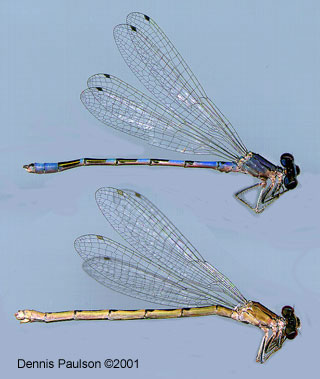
Enallagma anna
(River Bluet)
Order: Odonata
Suborder: Zygoptera
Order Description: Damselflies
Family: Coenagrionidae
Family Description: Bluet
Description:
Naiad-This is a small naiad ū to one inch (19 to 23 mm) long. It has the typical slender shape of immature damselflies. They range in color from green to light brown.
Adult-This is a small damselfly 1 ž to 1 ― inches (31 to 37 mm) long. The males are predominately blue on the sides of the thorax, and the upper side of the abdomen is predominantly blue, with black stripes or dots on the upper surface of most segments. Females are pale blue or tan, patterned very similarly to the males.
Range:
This species is found from Wisconsin west to southern Idaho and Montana, and south to New Mexico and southern California. In Idaho it occurs in the southern half of the state.
Habitat:
This damselfly occurs at nutrient rich streams or rivers with slow to moderate flows.
Adult Flight Season:
June 18 to August 12
Diet:
Naiad-Naiads eat a wide variety of aquatic insects, including mosquito larvae, mayfly larvae, and other aquatic fly larvae.
Adult-Adults eat a wide variety of small soft-bodied flying insects, such as mosquitoes, mayflies, flies and small moths. They will also pick small insects such as aphids from plants.
Ecology:
The River Bluet is usually found in nutrient-rich streams in the sagebrush deserts of the western United States.
Reproduction:
The males set up territories at choice breeding sites. After males and females mate, the male remains attached to the female (called "in tandem") as she oviposits in vegetation in streams and rivers.
Conservation:
Populations are widespread, abundant, and secure.
| Global Rank: | G5 |
| State Rank: | S? |
References:
Corbet, P. S. 1999. Dragonflies: Behavior and Ecology of Odonata. Cornell University Press, Ithaca, New York, USA, 829pp.
Logan, E. R. 1967. The Odonata of Idaho. Unpublished M. S. thesis. University of Idaho, Moscow, Idaho, USA, 105 pp.
Needham, J. G. and M. J. Westfall. 1955. Dragonflies of North America. University of California Press, Berkely, California, USA, 615 pp.
Paulson, D. R. 1999. Dragonflies of Washington. Seattle Audubon Society, Seattle, Washington, USA, 32 pp.
Walker, E. M. and P. S. Corbet. 1975. The Odonata of Canada and Alaska, Vol. III. University of Toronto Press, Toronto, Ontario, Canada, 307 pp.
Written by Mark Lung and Stefan Sommer, 2001
Photos by Dennis Paulson, 2001
Design by Ean Harker, 2001.
HTML by Marty Peck, 2001.
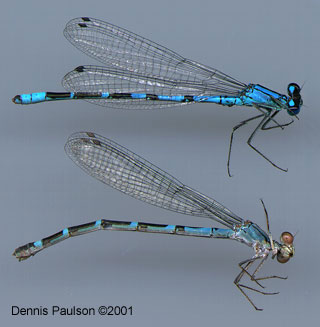
Enallagma boreale
(Boreal Bluet)
Order: Odonata
Suborder: Zygoptera
Order Description: Damselflies
Family: Coenagrionidae
Family Description: Bluet
Description:
Naiad-This is a small naiad ū to one inch (19 to 23 mm) long. It has the typical slender shape of immature damselflies. They range in color from light to dark brown.
Adult-This is a small damselfly 1 to 1 ž inches (26 to 33 mm) long. The males are predominately blue on the sides of the thorax, and the upper side of the abdomen. The lower abdominal appendages are longer than the upper appendages. Females are greenish-yellow to brown. The upper side of the abdomen is mostly black.
Range:
In North America this species is found from Alaska east to Hudson Bay and south to Utah and northern California, Missouri, and Connecticut. In Idaho it is found throughout the state.
Habitat:
This damselfly occurs at lakes, ponds, and marshes, and streams with slow to moderate flow. It occurs in a wide variety of habitats, from sagebrush desert to mountain lakes.
Adult Flight Season:
June 4 to August 27
Diet:
Naiad-Naiads eat a wide variety of aquatic insects, including mosquito larvae, mayfly larvae, and other aquatic fly larvae.
Adult-Adults eat a wide variety of small soft-bodied flying insects, such as mosquitoes, mayflies, flies and small moths. They will also pick small insects such as aphids from plants.
Ecology:
This species is almost identical to the Northern Bluet (Enallagma cyathigerum), and even though these two species share similar ranges in North America, they are almost never found at the same body of water. The reasons for this separation are not known.
Reproduction:
The males set up territories at choice breeding sites. After males and females mate, the female Boreal Bluet oviposits in aquatic vegetation.
Conservation:
Populations are widespread, abundant, and secure.
| Global Rank: | G5 |
| State Rank: | S? |
References:
Corbet, P. S. 1999. Dragonflies: Behavior and Ecology of Odonata. Cornell University Press, Ithaca, New York, USA, 829pp.
Logan, E. R. 1967. The Odonata of Idaho. Unpublished M. S. thesis. University of Idaho, Moscow, Idaho, USA, 105 pp.
Needham, J. G. and M. J. Westfall. 1955. Dragonflies of North America. University of California Press, Berkely, California, USA, 615 pp.
Paulson, D. R. 1999. Dragonflies of Washington. Seattle Audubon Society, Seattle, Washington, USA, 32 pp.
Walker, E. M. and P. S. Corbet. 1975. The Odonata of Canada and Alaska, Vol. III. University of Toronto Press, Toronto, Ontario, Canada, 307 pp.
Written by Mark Lung and Stefan Sommer, 2001
Photos by Dennis Paulson, 2001
Design by Ean Harker, 2001.
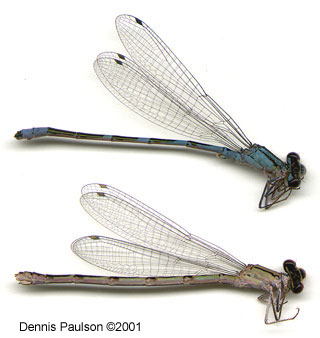
Enallagma carunculatum
(Tule Bluet)
Order: Odonata
Suborder: Zygoptera
Order Description: Damselflies
Family: Coenagrionidae
Family Description: Bluet
Description:
Naiad- This is a small naiad ž to one inch (19 to 23 mm) long. It has the typical slender shape of immature damselfies. They range in color from green to light brown.
Adult-This is a small damselfly 1 ź to 1 ˝ inches (31 to 37 mm) long. The males are predominately blue on the sides of the thorax, and the upper side of the abdomen is predominantly black, except for segments one and two, and eight and nine, which are blue. Females are pale blue to greenish-yellow. The upper side of the abdomen is mostly black, except for segment eight, which is blue with a black stripe down the center.
Range:
This species is found from southern British Columbia east to Nova Scotia, and south to Maryland, Oklahoma, New Mexico, and Baja California. In Idaho it occurs throughout the state.
Habitat:
This damselfly occurs at lakes and ponds that have stands of bulrushes along the shore.
Adult Flight Season:
July 8 to October 15
Diet:
Naiad-Naiads eat a wide variety of aquatic insects, including mosquito larvae, mayfly larvae, and other aquatic fly larvae.
Adult-Adults eat a wide variety of small soft-bodied flying insects, such as mosquitoes, mayflies, flies and small moths. They will also pick small insects such as aphids from plants.
Ecology:
The Tule Bluet is almost always found where there are extensive stands of tules. This damselfly will emerge from relatively deep water as long as there are bulrushes nearby. This species can also be found in alkaline or salty water.
Reproduction:
The males set up territories at choice breeding sites. After males and females mate, the male remains attached to the female (called "in tandem"), as she oviposits in the stems of bulrushes.
Conservation:
Populations are widespread, abundant, and secure.
| Global Rank: | G5 |
| State Rank: | S? |
References:
Corbet, P. S. 1999. Dragonflies: Behavior and Ecology of Odonata. Cornell University Press, Ithaca, New York, USA, 829pp.
Logan, E. R. 1967. The Odonata of Idaho. Unpublished M. S. thesis. University of Idaho, Moscow, Idaho, USA, 105 pp.
Needham, J. G. and M. J. Westfall. 1955. Dragonflies of North America. University of California Press, Berkely, California, USA, 615 pp.
Paulson, D. R. 1999. Dragonflies of Washington. Seattle Audubon Society, Seattle, Washington, USA, 32 pp.
Walker, E. M. and P. S. Corbet. 1975. The Odonata of Canada and Alaska, Vol. III. University of Toronto Press, Toronto, Ontario, Canada, 307 pp.
Written by Mark Lung and Stefan Sommer, 2001
Photos by Dennis Paulson, 2001
Design by Ean Harker, 2001.
HTML by Marty Peck, 2001.
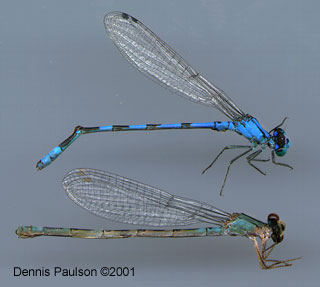
Enallagma clausum
(Alkali Bluet)
Order: Odonata
Suborder: Zygoptera
Order Description: Damselflies
Family: Coenagrionidae
Family Description: Bluet
Description:
Naiad- This is a small naiad about one inch (21 to 24 mm) long. It has the typical slender shape of immature damselflies. They range in color from green to light brown.
Adult-This is a small damselfly 1 ¼ to 1 ½ inches (31 to 37 mm) long. The males are predominately blue on the sides of the thorax, and the upper side of the abdomen, except for segments five, six, seven, and ten, which are predominantly black. Females are pale blue to greenish-yellow. The upper side of the abdomen is mostly black, except for segment eight, which is blue.
Range:
This species is found from southern British Columbia east to Manitoba, and south to Kansas, Utah and Washington. In Idaho it occurs in the southern half of the state.
Habitat:
This damselfly occurs at lakes, ponds, and marshes that have alkaline or even salty water.
Adult Flight Season:
June 24 to August 12
Diet:
Naiad- Naiads eat a wide variety of aquatic insects, including mosquito larvae, mayfly larvae, and other aquatic fly larvae.
Adult- Adults eat a wide variety of small soft-bodied flying insects, such as mosquitoes, mayflies, flies and small moths. They will also pick small insects such as aphids from plants.
Ecology:
The Alkali Bluet is found near alkaline or salty lakes or marshes, and therefore it is common in southeast Idaho where these bodies of water are more common. The naiads have been found in water that has over half the salt content of seawater. The adults are difficult to net because they fly very close to the ground, and are more wary than most damselflies.
Reproduction:
The males set up territories at choice breeding sites. After males and females mate, the female Alkali Bluet oviposits in tandem on floating mats of decaying algae.
Conservation:
Populations are widespread, abundant, and secure.
| Global Rank: | G5 |
| State Rank: | S? |
References:
Corbet, P. S. 1999. Dragonflies: Behavior and Ecology of Odonata. Cornell University Press, Ithaca, New York, USA, 829pp.
Logan, E. R. 1967. The Odonata of Idaho. Unpublished M. S. thesis. University of Idaho, Moscow, Idaho, USA, 105 pp.
Needham, J. G. and M. J. Westfall. 1955. Dragonflies of North America. University of California Press, Berkely, California, USA, 615 pp.
Paulson, D. R. 1999. Dragonflies of Washington. Seattle Audubon Society, Seattle, Washington, USA, 32 pp.
Walker, E. M. and P. S. Corbet. 1975. The Odonata of Canada and Alaska, Vol. III. University of Toronto Press, Toronto, Ontario, Canada, 307 pp.
Written by Mark Lung and Stefan Sommer, 2001
Photos by Dennis Paulson, 2001
Design by Ean Harker, 2001.
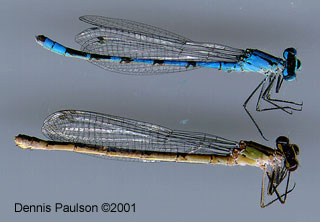
Enallagma cyathigerum
(Northern Bluet)
Order: Odonata
Suborder: Zygoptera
Order Description: Damselflies
Family: Coenagrionidae
Family Description: Bluet
Description:
Naiad- This is a small naiad about ž inch (16 to 20 mm) long. It has the typical slender shape of immature damselflies. They range in color from light to dark brown.
Adult- This is a small damselfly 1 to 1 ź inches (26 to 33 mm) long. The males are predominately blue on the sides of the thorax, and the upper side of the abdomen. The lower abdominal appendages are longer than the upper appendages. Females are greenish-yellow to brown. The upper side of the abdomen is mostly black.
Range:
This species is found around the world in northern latitudes. In North America it ranges from Alaska east to Hudson Bay, and south to Virginia, Utah and California. In Idaho it is found throughout the state.
Habitat:
This damselfly occurs at lakes, ponds, and marshes, and streams with slow to moderate flow. It occurs in a wide variety of habitats, from sagebrush desert to mountain lakes.
Adult Flight Season:
June 4 to August 27
Diet:
Naiad- Naiads eat a wide variety of aquatic insects, including mosquito larvae, mayfly larvae, and other aquatic fly larvae.
Adult- Adults eat a wide variety of small soft-bodied flying insects, such as mosquitoes, mayflies, flies and small moths. They will also pick small insects such as aphids from plants.
Ecology:
This species is almost identical to the Boreal Bluet, and even though they have similar ranges they almost never occur at the same body of water. The reason for this separation is not known.
Reproduction:
The males set up territories at choice breeding sites. After males and females mate, the female Northern Bluet oviposits, or lays eggs, in aquatic vegetation.
Conservation:
Populations are widespread, abundant, and secure.
| Global Rank: | G5 |
| State Rank: | S? |
References:
Corbet, P. S. 1999. Dragonflies: Behavior and Ecology of Odonata. Cornell University Press, Ithaca, New York, USA, 829pp.
Logan, E. R. 1967. The Odonata of Idaho. Unpublished M. S. thesis. University of Idaho, Moscow, Idaho, USA, 105 pp.
Needham, J. G. and M. J. Westfall. 1955. Dragonflies of North America. University of California Press, Berkely, California, USA, 615 pp.
Paulson, D. R. 1999. Dragonflies of Washington. Seattle Audubon Society, Seattle, Washington, USA, 32 pp.
Walker, E. M. and P. S. Corbet. 1975. The Odonata of Canada and Alaska, Vol. III. University of Toronto Press, Toronto, Ontario, Canada, 307 pp.
Written by Mark Lung and Stefan Sommer, 2001
Photos by Dennis Paulson, 2001
Design by Ean Harker, 2001.
HTML by Marty Peck, 2001.
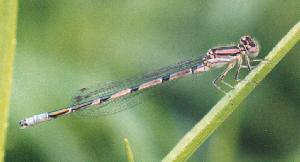
Enallagma ebrium
(Marsh Bluet)
Order: Odonata
Suborder: Zygoptera
Order Description: Damselflies
Family: Coenagrionidae
Family Description: Bluet
Description:
Naiad- This is a small naiad about ž to 1 inch (16 to 20 mm) long. It has the typical slender shape of immature damselflies. They range in color from light to dark brown.
Adult- This is a small damselfly about 1 to 1 ¼ inches (26 to 33 mm) long. The males are predominately blue on the sides of the thorax, and the upper side of the abdomen. Both the upper and lower anal appendages are about the same length. Females are greenish-yellow to brown. The upper side of the abdomen is mostly black. Segment two has a stripe on the upper side that widens at the base.
Range:
This species is found across the continent from southern British Columbia east to Nova Scotia and south to Utah, Nebraska, and Virginia. In Idaho it is known only from the northern half of the state.
Habitat:
This damselfly occurs at lowland lakes, ponds, and marshes, and has a definite preference for alkaline waters.
Adult Flight Season:
June 11 to July 8
Diet:
Naiad- Naiads eat a wide variety of aquatic insects, including mosquito larvae, mayfly larvae, and other aquatic fly larvae.
Adult- Adults eat a wide variety of small soft-bodied flying insects, such as mosquitoes, mayflies, flies and small moths. They will also pick small insects such as aphids from plants.
Ecology:
This species is very common at alkaline marshes in mid-summer.
Reproduction:
The males set up territories at choice breeding sites. After males and females mate, the female Marsh Bluet oviposits, or lays eggs, either singly or in tandem with the male. They descend as much as a foot under water to oviposit in aquatic vegetation.
Conservation:
Populations are widespread, abundant, and secure.
| Global Rank: | G5 |
| State Rank: | S? |
References:
Corbet, P. S. 1999. Dragonflies: Behavior and Ecology of Odonata. Cornell University Press, Ithaca, New York, USA, 829pp.
Logan, E. R. 1967. The Odonata of Idaho. Unpublished M. S. thesis. University of Idaho, Moscow, Idaho, USA, 105 pp.
Needham, J. G. and M. J. Westfall. 1955. Dragonflies of North America. University of California Press, Berkely, California, USA, 615 pp.
Paulson, D. R. 1999. Dragonflies of Washington. Seattle Audubon Society, Seattle, Washington, USA, 32 pp.
Walker, E. M. and P. S. Corbet. 1975. The Odonata of Canada and Alaska, Vol. III. University of Toronto Press, Toronto, Ontario, Canada, 307 pp.
Written by Mark Lung and Stefan Sommer, 2001
Photos by , 2001
Design by Ean Harker, 2001.
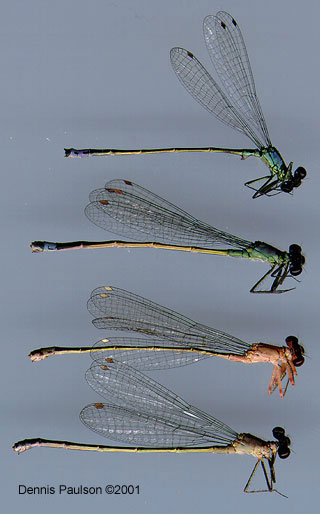
Ischnura cervula
(Pacific Forktail)
Order: Odonata
Suborder: Zygoptera
Order Description: Damselflies
Family: Coenagrionidae
Family Description: Forktail
Description:
Naiad- This is a small naiad about ū inch (15 to 18 mm). It has the typical slender immature damselfly shape. It is dark with light bands.
Adult- This is a small damselfly about 1 to 1 ― inches (26 to 32 mm). The male has pale blue on the side of the thorax, 4 blue spots on top of the thorax, and a black abdomen with segments eight and nine colored bright blue. Most females are brown, but some are colored very similarly to males. Both color forms of the females become pruinose with age.
Range:
This species is found from southern British Columbia east to Alberta, and south to New Mexico and Baja California. In Idaho it is found throughout the state.
Habitat:
This damselfly occurs at almost all lowland still-water habitats in the state, but is most abundant in semi-arid areas at alkaline ponds.
Adult Flight Season:
April 15 to October 15
Diet:
Naiad- Naiads eat a wide variety of aquatic insects, including mosquito larvae, mayfly larvae, and other aquatic fly larvae.
Adult- Adults eat a wide variety of small soft-bodied flying insects, such as mosquitoes, mayflies, flies and small moths. They will also pick small insects such as aphids off of plants.
Ecology:
Naiads of this species are often found in aquatic vegetation. This is the first damselfly to emerge in the spring, and one of the last seen in the fall.
Reproduction:
The males set up territories at choice breeding sites. After males and females mate, the female Western Forktail oviposits, or lays eggs, singly (without the male attached) in floating vegetation.
Conservation:
Populations are widespread, abundant, and secure.
| Global Rank: | G5 |
| State Rank: | S? |
References:
Corbet, P. S. 1999. Dragonflies: Behavior and Ecology of Odonata. Cornell University Press, Ithaca, New York, USA, 829pp.
Logan, E. R. 1967. The Odonata of Idaho. Unpublished M. S. thesis. University of Idaho, Moscow, Idaho, USA, 105 pp.
Needham, J. G. and M. J. Westfall. 1955. Dragonflies of North America. University of California Press, Berkely, California, USA, 615 pp.
Paulson, D. R. 1999. Dragonflies of Washington. Seattle Audubon Society, Seattle, Washington, USA, 32 pp.
Walker, E. M. and P. S. Corbet. 1975. The Odonata of Canada and Alaska, Vol. III. University of Toronto Press, Toronto, Ontario, Canada, 307 pp.
Written by Mark Lung and Stefan Sommer, 2001
Photos by Dennis Paulson, 2001
Design by Ean Harker, 2001.
HTML by Marty Peck, 2001.
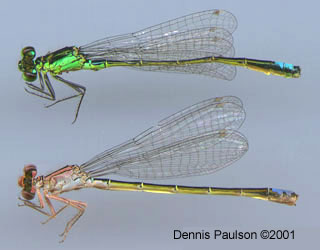
Ischnura denticollis
(Black-fronted Forktail)
Order: Odonata
Suborder: Zygoptera
Order Description: Damselflies
Family: Coenagrionidae
Family Description: Forktail
Description:
Naiad- This is a small, naiad about ž inch (15 to 18 mm) long. It has the typical, slender shape of immature damselflies.
Adult- This is a very small damselfly generally less than one inch (22 to 26 mm) long. The male has pale blue on the side of the thorax, solid black on top of the thorax, and a blue-green abdomen with segments eight and nine colored bright blue. Most females are light orange brown, but some are colored very similarly to males.
Range:
This species is found from eastern Oregon east to Kansas and south to Texas, Baja California, and Guatemala. In Idaho it is found only in the southwest corner of the state.
Habitat:
This damselfly is found at spring-fed pools and streams in arid areas.
Adult Flight Season:
Late April - Late September or early October
Diet:
Naiad- Naiads eat a wide variety of aquatic insects, including mosquito larvae, mayfly larvae, and other aquatic fly larvae.
Adult- Adults eat a wide variety of small soft-bodied flying insects, such as mosquitoes, mayflies, flies and small moths. They will also pick small insects such as aphids from plants.
Ecology:
Very little is known about the ecology of this species, except for its preference for spring-fed pools in desert areas.
Reproduction:
The males set up territories at choice breeding sites. After males and females mate, the female, unlike other forktails, stays attached to the males (called "in tandem") as she lays her eggs in floating vegetation.
Conservation:
Populations are widespread, abundant, and secure.
| Global Rank: | G5 |
| State Rank: | S? |
References:
Corbet, P. S. 1999. Dragonflies: Behavior and Ecology of Odonata. Cornell University Press, Ithaca, New York, USA, 829pp.
Logan, E. R. 1967. The Odonata of Idaho. Unpublished M. S. thesis. University of Idaho, Moscow, Idaho, USA, 105 pp.
Needham, J. G. and M. J. Westfall. 1955. Dragonflies of North America. University of California Press, Berkely, California, USA, 615 pp.
Paulson, D. R. 1999. Dragonflies of Washington. Seattle Audubon Society, Seattle, Washington, USA, 32 pp.
Walker, E. M. and P. S. Corbet. 1975. The Odonata of Canada and Alaska, Vol. III. University of Toronto Press, Toronto, Ontario, Canada, 307 pp.
Written by Mark Lung and Stefan Sommer, 2001
Photos by Dennis Paulson, 2001
Design by Ean Harker, 2001.
HTML by Marty Peck, 2001.
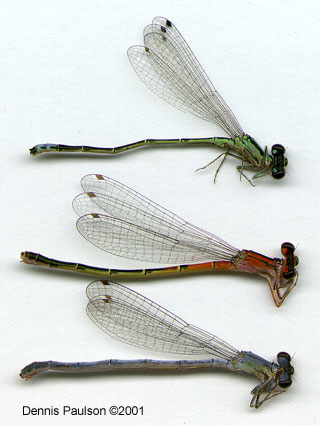
Ischnura perparva
(Western Forktail)
Order: Odonata
Suborder: Zygoptera
Order Description: Damselflies
Family: Coenagrionidae
Family Description: Forktail
Description:
Naiad- This is a small naiad about ž inch (15 to 18 mm). It has the typical slender immature damselfly shape. The color is uniform, ranging from olive to pale brown.
Adult- This is a very small damselfly about 1 to 1 ź inch (23 to 28 mm). The male has green stripes on the side of the thorax, blue stripes on top of the thorax, and a black abdomen with segments eight and nine colored bright blue. The females are light orange brown, becoming a pale pruinose blue as they age.
Range:
This species is found from southern British Columbia east to Manitoba and south to Texas and California. In Idaho it is found throughout the state.
Habitat:
This damselfly is found at ponds, lakes, and very slow-moving streams. It's often found at alkaline ponds.
Adult Flight Season:
Early June - October. In the lower elevation areas of the state it probably emerges as early as late April.
Diet:
Naiad- Naiads eat a wide variety of aquatic insects, including mosquito larvae, mayfly larvae, and other aquatic fly larvae.
Adult- Adults eat a wide variety of small soft-bodied flying insects, such as mosquitoes, mayflies, flies and small moths. They will also pick small insects such as aphids from plants.
Ecology:
The naiads of this species are often found in mud bottoms rather than among aquatic plants. Their uniform color serves as great camouflage for this habitat.
Reproduction:
The males set up territories at choice breeding sites. Before females turn pruinose, males and females mate. If a male approaches a female after her receptive period the female curves the tip of her abdomen upwards in a characteristic posture and she is generally left alone. After mating, the female oviposits singly, without the males attached, in floating vegetation at ponds, lakes, and slow streams.
Conservation:
Populations are widespread, abundant, and secure.
| Global Rank: | G5 |
| State Rank: | S? |
References:
Corbet, P. S. 1999. Dragonflies: Behavior and Ecology of Odonata. Cornell University Press, Ithaca, New York, USA, 829pp.
Logan, E. R. 1967. The Odonata of Idaho. Unpublished M. S. thesis. University of Idaho, Moscow, Idaho, USA, 105 pp.
Needham, J. G. and M. J. Westfall. 1955. Dragonflies of North America. University of California Press, Berkely, California, USA, 615 pp.
Paulson, D. R. 1999. Dragonflies of Washington. Seattle Audubon Society, Seattle, Washington, USA, 32 pp.
Walker, E. M. and P. S. Corbet. 1975. The Odonata of Canada and Alaska, Vol. III. University of Toronto Press, Toronto, Ontario, Canada, 307 pp.
Written by Mark Lung and Stefan Sommer, 2001
Photos by Dennis Paulson, 2001
Design by Ean Harker, 2001.
HTML by Marty Peck, 2001.
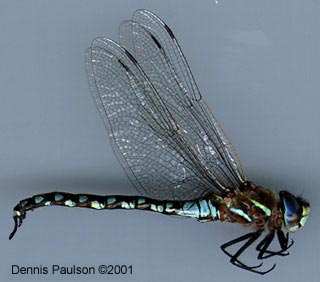
Aeshna californica
(California Darner)
Order: Odonata
Suborder: Anisoptera
Order Description: Dragonflies
Family: Aeshnidae
Family Description: Darners
Description:
Naiad- This is a medium-sized naiad, or immature dragonfly, with a length of 1 5/16 to 1 1/2 inches (33 to 37 mm). It is long and slender, which is the typical shape of an immature Darner dragonfly. It is mottled green and brown and has a single, rear-facing spine on each side of abdominal segments six through nine.
Adult- This is a medium-sized dragonfly with a length of 2 1/4 to 2 1/2 inches (57 to 64 mm). The male is dark brown to brownish black. Each side of the thorax is marked with two blue to bluish green diagonal stripes, while the top of the thorax is unmarked. The abdomen is marked with large blue spots alternating with smaller greenish dots. There are several wide blue bands circling the abdomen near where it meets the thorax. Most females resemble the males in color, but some may have greenish yellow markings instead of blue.
Range:
This species is found from southern British Columbia south to Baja California and Arizona. In Idaho it is found throughout the state.
Habitat:
This dragonfly can be found near lakes, ponds, and marshes at lower elevations.
Adult Flight Season:
Mid April - Late June
Diet:
Naiad- Naiads feed on a wide variety of aquatic insects, such as mosquito larvae, other aquatic fly larvae, mayfly larvae, and freshwater shrimp. They will also eat small fish and tadpoles.
Adult- The dragonfly will eat almost any soft-bodied flying insect including mosquitoes, flies, butterflies, moths, mayflies, and stoneflies.
Ecology:
The naiads are active predators, and are able to swim by jet propulsion - squirting water out from the ends of their abdomens. They generally take several years to mature, and when they emerge, or change into adult dragonflies, they do so at night. This behavior probably evolved to avoid being eaten be daytime predators. Adult California Darners generally fly from mid-April through the end of June, making it one of the first dragonflies seen each spring. Adults are able to regulate their body temperature which enables them to fly in temperatures too cold for most dragonflies.
Reproduction:
Males establish and defend territories along the shores of ponds and lakes. After males and females mate, females fly singly, without the male attached, to lay their eggs in the stems and leaves of aquatic plants. They have been observed resting on lily pads and reaching under the lily pad with their abdomen to deposit eggs on the underside of the pad.
Conservation:
Populations are widespread, abundant, and secure.
| Global Rank: | G5 |
| State Rank: | S? |
References:
Corbet, P. S. 1999. Dragonflies: Behavior and Ecology of Odonata. Cornell University Press, Ithaca, New York, USA, 829pp.
Logan, E. R. 1967. The Odonata of Idaho. Unpublished M. S. thesis. University of Idaho, Moscow, Idaho, USA, 105 pp.
Needham, J. G. and M. J. Westfall. 1955. Dragonflies of North America. University of California Press, Berkely, California, USA, 615 pp.
Paulson, D. R. 1999. Dragonflies of Washington. Seattle Audubon Society, Seattle, Washington, USA, 32 pp.
Walker, E. M. and P. S. Corbet. 1975. The Odonata of Canada and Alaska, Vol. III. University of Toronto Press, Toronto, Ontario, Canada, 307 pp.
Written by Mark Lung and Stefan Sommer, 2001
Photos by Dennis Paulson, 2001
Design/HTML by Ean Harker, 2001.
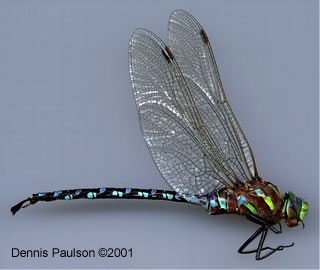
Aeshna constricta
(Lance-tipped Darner)
Order: Odonata
Suborder: Anisoptera
Order Description: Dragonflies
Family: Aeshnidae
Family Description: Darners
Description:
Naiad- This is a large naiad with a length of 1 7/16 to 1 9/16 inches (36 to 38 mm). It is long and slender like other Darner naiads. It is mottled green and brown and has a single, rear-facing spine on each side of abdominal segments six through nine.
Adult- This is a large dragonfly with a length of 2 5/8 to 2 15/16 inches (65 to 73 mm). The male is dark brown to brownish black. The top of the thorax behind the head is marked with two metallic green stripes. Each side of the thorax is marked with two diagonal stripes that are greenish on the bottom end and bluish towards the top; the stripes are tipped at the top with a rear-facing projection. The abdomen is marked with bright metallic blue spots and smaller greenish dots. Most females resemble the coloration of the male, but some may have greenish yellow markings instead of blue.
Range:
This species occurs from southern British Columbia east across Canada to Nova Scotia, and south to California, Kansas, and Maryland. In Idaho, it is found in the panhandle region.
Habitat:
This species occurs near lakes, ponds, marshes, and slow streams.
Adult Flight Season:
Early June - Early October
Diet:
Naiad- The naiad will feed on a wide variety of aquatic insects, such as mosquito larvae, other aquatic fly larvae, mayfly larvae, and freshwater shrimp. They will also eat small fish and tadpoles.
Adult- The dragonfly will feed on almost any soft-bodied flying insect including mosquitoes, flies, butterflies, moths, mayflies, and stoneflies. Most of the insects it eats are captured while flying.
Ecology:
Like other Darners, the naiads are active predators, and are able to swim by jet propulsion - squirting water out from the ends of their abdomens. They generally take several years to mature, and when they emerge, or change into adult dragonflies, they do so at night. This behavior probably evolved to avoid being eaten be daytime predators. Adults generally fly from early June to early October, and can often be seen flying over fields miles from water in August. Adults are able to regulate their body temperature which enables them to fly in temperatures too cold for most dragonflies. This Darner sometimes joins swarms of Variable Darners (Aeshna interrupta) over dirt roads. Although it ranges over most of the Northwest, it is not commonly spotted anywhere in Idaho or Washington.
Reproduction:
Males establish and defend territories along the shores of ponds and marshes. After males and females mate, females fly singly, without the male attached, to lay their eggs in the stems and leaves of aquatic plants. Unlike other Darners, female Lance-tipped Darners usually lays their eggs in plant parts several feet above the waterline.
Conservation:
Populations are widespread, abundant, and secure.
| Global Rank: | G5 |
| State Rank: | S? |
References:
Corbet, P. S. 1999. Dragonflies: Behavior and Ecology of Odonata. Cornell University Press, Ithaca, New York, USA, 829pp.
Logan, E. R. 1967. The Odonata of Idaho. Unpublished M. S. thesis. University of Idaho, Moscow, Idaho, USA, 105 pp.
Needham, J. G. and M. J. Westfall. 1955. Dragonflies of North America. University of California Press, Berkely, California, USA, 615 pp.
Paulson, D. R. 1999. Dragonflies of Washington. Seattle Audubon Society, Seattle, Washington, USA, 32 pp.
Walker, E. M. and P. S. Corbet. 1975. The Odonata of Canada and Alaska, Vol. III. University of Toronto Press, Toronto, Ontario, Canada, 307 pp.
Written by Mark Lung and Stefan Sommer, 2001
Photos by Dennis Paulson, 2001
Design/HTML by Ean Harker, 2001.
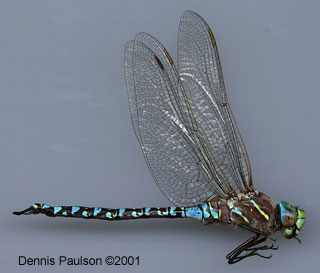
Aeshna interrupta
(Variable Darner)
Order: Odonata
Suborder: Anisoptera
Order Description: Dragonflies
Family: Aeshnidae
Family Description: Darners
Description:
Naiad- This is a large naiad with a length of 1 1/2 to 1 3/4 inches (39 to 42 mm). It is long and slender like other Darner naiads. It is mottled green and brown and has a single, rear-facing spine on each side of abdominal segments six through nine.
Adult- This is a large dragonfly with a length of 2 1/2 to 2 3/4 inches (65 to 70 mm). The male is dark brown to black. The top of the thorax is marked with two greenish dashes. Each side of the thorax is marked with a pair of diagonal stripes or with two pairs of elongated spots arranged in diagonal rows. In either case, half of the marks are greenish and half are bluish. The abdomen is spotted with green and blue. The female is marked similarly; however, the base color is brown and the abdominal marks are green. The common name for this species refers to the variable marks on the thorax.
Range:
This species is found from Alaska and the Yukon Territories east across Canada to Nova Scotia, extending south to California, New Mexico, and northern New York. In Idaho, it is found throughout the state.
Habitat:
This dragonfly can be found near lakes, ponds, and marshes, primarily in prairie and sagebrush steppe habitats.
Adult Flight Season:
Early June - October
Diet:
Naiad- Naiads feed on a wide variety of aquatic insects, such as mosquito larvae, other aquatic fly larvae, mayfly larvae, and freshwater shrimp. They will also eat small fish and tadpoles.
Adult- The dragonfly will eat almost any soft-bodied flying insect including mosquitoes, flies, butterflies, moths, mayflies, and stoneflies. It has also been known to prey on immature dragonflies (naiads) of other species found resting on blades of grass.
Ecology:
Like other Darners, the naiads are active predators, and are able to swim by jet propulsion - squirting water out from the ends of their abdomens. They generally take several years to mature, and when they emerge, or change into adult dragonflies, they do so at night. This behavior probably evolved to avoid being eaten be daytime predators. Adults generally fly from early June to October. This Darner often gathers in swarms over dirt roads. It flies long after dark on warm summer evenings, and can spot flying insects when it's too dark for a person to see them. Adults are able to regulate their body temperature which enables them to fly in temperatures too cold for most dragonflies.
Reproduction:
Males establish and defend territories along the shores of ponds and marshes. After males and females mate, females fly singly, without the male attached, to lay their eggs in the stems and leaves of aquatic plants. Unique individuals resembling females but having male reproductive organs have been collected. Such individuals are called androgynomorphs.
Conservation:
Populations are widespread, abundant, and secure.
| Global Rank: | G5 |
| State Rank: | S? |
References:
Corbet, P. S. 1999. Dragonflies: Behavior and Ecology of Odonata. Cornell University Press, Ithaca, New York, USA, 829pp.
Logan, E. R. 1967. The Odonata of Idaho. Unpublished M. S. thesis. University of Idaho, Moscow, Idaho, USA, 105 pp.
Needham, J. G. and M. J. Westfall. 1955. Dragonflies of North America. University of California Press, Berkely, California, USA, 615 pp.
Paulson, D. R. 1999. Dragonflies of Washington. Seattle Audubon Society, Seattle, Washington, USA, 32 pp.
Walker, E. M. and P. S. Corbet. 1975. The Odonata of Canada and Alaska, Vol. III. University of Toronto Press, Toronto, Ontario, Canada, 307 pp.
Written by Mark Lung and Stefan Sommer, 2001
Photos by Dennis Paulson, 2001
Design/HTML by Ean Harker, 2001.
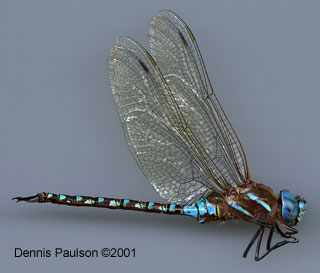
Aeshna multicolor
(Blue-eyed Darner)
Order: Odonata
Suborder: Anisoptera
Order Description: Dragonflies
Family: Aeshnidae
Family Description: Darners
Description:
Naiad- This is a large naiad, or immature dragonfly, with a length of 1 3/8 to 1 5/8 inches (35 to 40 mm). It is long and slender like other Darner naiads. It is mottled green and brown and has a single, rear-facing spine on each side of abdominal segments six through nine. Note that the spine on abdominal segment six is very short.
Adult- This is a large dragonfly with a length of 2 1/2 to 2 3/4 inches (65 to 70 mm). The eyes of both males and females are bright blue. The male is dark brown to brownish black. The top of the thorax, behind the head, is marked with two blue stripes, and each side of the thorax is marked with a pair of blue diagonal stripes. The abdomen is marked with both large and small blue spots. The anal appendages of males are forked. The female is marked similarly to the male; however, the base color is brown and the markings are green.
Range:
This species is found from southern British Columbia south to Baja California and Texas. It also occurs throughout Mexico and Central America. In Idaho, it is found throughout the state, but prefers open sunny places at low elevations. It is commonly sighted in the sagebrush steppe of the Snake River Plain.
Habitat:
This species occurs near lakes, ponds, and marshes at lower elevations.
Adult Flight Season:
Early June - October
Diet:
Naiad- Naiads feed on a wide variety of aquatic insects, such as mosquito larvae, other aquatic fly larvae, mayfly larvae, and freshwater shrimp. They will also eat small fish and tadpoles.
Adult- The dragonfly will eat almost any soft-bodied flying insect including mosquitoes, flies, butterflies, moths, mayflies, and stoneflies.
Ecology:
Like other Darners, the naiads are active predators, and are able to swim by jet propulsion - squirting water out from the ends of their abdomens. They generally take several years to mature, and when they emerge, or change into adult dragonflies, they do so at night. This behavior probably evolved to avoid being eaten be daytime predators. Adults generally fly from early June to October. This is usually the second earliest Darner to emerge in the spring, with the California Darner emerging first. It hunts small flying insects while on the wing.
Reproduction:
Males establish and defend territories and can be very aggressive towards anything, even small birds, that invade their territory. After males and females mate, females fly singly, without the male attached, to lay their eggs in the stems and leaves of aquatic plants. They tend to be very elusive and secretive as they search for egg-laying sites in shoreline vegetation.
Conservation:
Populations are widespread, abundant, and secure.
| Global Rank: | G5 |
| State Rank: | S? |
References:
Corbet, P. S. 1999. Dragonflies: Behavior and Ecology of Odonata. Cornell University Press, Ithaca, New York, USA, 829pp.
Logan, E. R. 1967. The Odonata of Idaho. Unpublished M. S. thesis. University of Idaho, Moscow, Idaho, USA, 105 pp.
Needham, J. G. and M. J. Westfall. 1955. Dragonflies of North America. University of California Press, Berkely, California, USA, 615 pp.
Paulson, D. R. 1999. Dragonflies of Washington. Seattle Audubon Society, Seattle, Washington, USA, 32 pp.
Walker, E. M. and P. S. Corbet. 1975. The Odonata of Canada and Alaska, Vol. III. University of Toronto Press, Toronto, Ontario, Canada, 307 pp.
Written by Mark Lung and Stefan Sommer, 2001
Photos by Dennis Paulson, 2001
Design/HTML by Ean Harker, 2001.
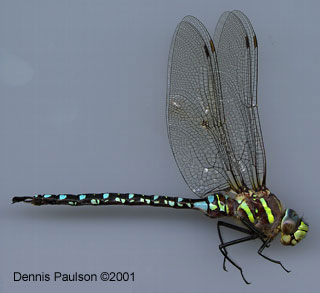
Aeshna palmata
(Paddle-tailed Darner)
Order: Odonata
Suborder: Anisoptera
Order Description: Dragonflies
Family: Aeshnidae
Family Description: Darners
Description:
Naiad- This is a large naiad, or immature dragonfly, with a length of 1 1/2 to 1 3/4 inches (37 to 43 mm). It is long and slender like other Darner naiads. It is mottled green and brown and has a single, rear-facing spine on each side of abdominal segments six through nine.
Adult- This is a large dragonfly with a length of 2 1/2 to 3 inches (63 to 74 mm). The base color of the male is brown to brownish black. The top of the thorax is marked with several yellowish green dashes, while each side of the thorax is marked with a pair of fairly thick, yellowish green diagonal stripes. The abdomen is marked with bands or large spots of blue and smaller spots of yellowish green. Males have paddle-shaped anal appendages. Females usually have yellow abdominal spots instead of blue, but may be marked identically to the males.
Range:
This species is found from Alaska south to British Columbia and Alberta to northern California, Utah and Colorado. In Idaho, it is found throughout the state.
Habitat:
This dragonfly occurs near lakes, ponds, marshes, and slow streams in a wide variety of habitats.
Adult Flight Season:
Early July - October
Diet:
Naiad- Naiads feed on a wide variety of aquatic insects, such as mosquito larvae, other aquatic fly larvae, mayfly larvae, and freshwater shrimp. They will also eat small fish and tadpoles.
Adult- The dragonfly will eat almost any soft-bodied flying insect including mosquitoes, flies, butterflies, moths, mayflies, and stoneflies.
Ecology:
Like other Darners, the naiads are active predators and are able to swim by jet propulsion - squirting water out from the ends of their abdomens. They can live in a wide variety of aquatic habitats ranging from hot springs to cold alpine lakes. They generally take several years to mature, and typically emerge as adults at night. This behavior probably evolved to avoid being eaten be daytime predators. Adults generally fly from early July to October. This is probably the most common dragonfly in Idaho. There are vast numbers of these dragonflies at the sedge marshes of Bear Lake and Gray's Lake in late summer and early fall.
Reproduction:
Males establish and defend territories along the shores of ponds, lakes, marshes, and hot springs. After males and females mate, females fly singly, without the male attached, to lay their eggs in the stems and leaves of aquatic plants.
Conservation:
Populations are widespread, abundant, and secure.
| Global Rank: | G5 |
| State Rank: | S? |
References:
Corbet, P. S. 1999. Dragonflies: Behavior and Ecology of Odonata. Cornell University Press, Ithaca, New York, USA, 829pp.
Logan, E. R. 1967. The Odonata of Idaho. Unpublished M. S. thesis. University of Idaho, Moscow, Idaho, USA, 105 pp.
Needham, J. G. and M. J. Westfall. 1955. Dragonflies of North America. University of California Press, Berkely, California, USA, 615 pp.
Paulson, D. R. 1999. Dragonflies of Washington. Seattle Audubon Society, Seattle, Washington, USA, 32 pp.
Walker, E. M. and P. S. Corbet. 1975. The Odonata of Canada and Alaska, Vol. III. University of Toronto Press, Toronto, Ontario, Canada, 307 pp.
Written by Mark Lung and Stefan Sommer, 2001
Photos by Dennis Paulson, 2001
Design/HTML by Ean Harker, 2001.
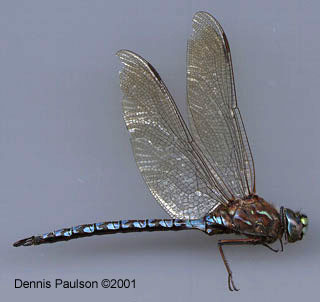
Aeshna sitchensis
(Zigzag Darner)
Order: Odonata
Suborder: Anisoptera
Order Description: Dragonflies
Family: Aeshnidae
Family Description: Darners
Description:
Naiad- This is a medium-sized naiad with a length of 1 1/4 to 1 1/2 inches (30 to 37 mm). It is long and slender like other Darner naiads. It is mottled green and brown and has a single, rear-facing spine on each side of abdominal segments seven through nine.
Adult- This is a medium-sized dragonfly with a length of 2 1/8 to 2 1/2 inches (54 to 64 mm). The base color is olive brown to brownish black. The top of the thorax is unmarked, while each side of the thorax is marked with a pair of zig-zag stripes of yellow or light blue. The abdomen is marked with numerous blue patches.
Range:
This species is found from Alaska east to Hudson Bay south to Washington and New Hampshire. In the northern states, it is found only at high elevations. In Idaho, it occurs in the mountains of the northern and central portions of the state with the southern-most extent of its range being Alturas Lake in the Stanley Basin of central Idaho.
Habitat:
This dragonfly can be found at high elevation sedge marshes near lakes and streams.
Adult Flight Season:
Late June - September
Diet:
Naiad- Naiads feed on a wide variety of aquatic insects, such as mosquito larvae, other aquatic fly larvae, mayfly larvae, and freshwater shrimp. They will also eat small fish and tadpoles.
Adult- The dragonfly will eat almost any soft-bodied flying insect including mosquitoes, flies, butterflies, moths, mayflies, and flying ants or termites.
Ecology:
Like other Darners, the naiads are active predators, and are able to swim by jet propulsion - squirting water out from the ends of their abdomens. They generally take several years to mature, and when they emerge, or change into adult dragonflies, they do so at night. This behavior probably evolved to avoid being eaten be daytime predators. Although records are sparse, adults are thought to fly from the end of June to September, and do all of their hunting while on the wing. Zig-zag Darners are able to regulate their body temperature which enables them to fly in temperatures too cold for most dragonflies.
Reproduction:
After males and females mate, females fly singly, without the male attached, to lay their eggs in the stems and leaves of aquatic plants.
Conservation:
Populations are widespread, abundant, and secure.
| Global Rank: | G5 |
| State Rank: | S? |
References:
Corbet, P. S. 1999. Dragonflies: Behavior and Ecology of Odonata. Cornell University Press, Ithaca, New York, USA, 829pp.
Logan, E. R. 1967. The Odonata of Idaho. Unpublished M. S. thesis. University of Idaho, Moscow, Idaho, USA, 105 pp.
Needham, J. G. and M. J. Westfall. 1955. Dragonflies of North America. University of California Press, Berkely, California, USA, 615 pp.
Paulson, D. R. 1999. Dragonflies of Washington. Seattle Audubon Society, Seattle, Washington, USA, 32 pp.
Walker, E. M. and P. S. Corbet. 1975. The Odonata of Canada and Alaska, Vol. III. University of Toronto Press, Toronto, Ontario, Canada, 307 pp.
Written by Mark Lung and Stefan Sommer, 2001
Photos by Dennis Paulson, 2001
Design/HTML by Ean Harker, 2001.
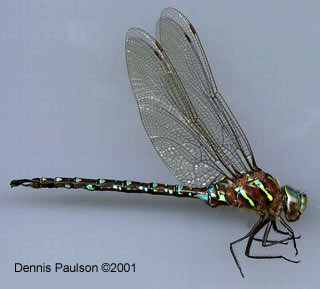
Aeshna umbrosa
(Shadow Darner)
Order: Odonata
Suborder: Anisoptera
Order Description: Dragonflies
Family: Aeshnidae
Family Description: Darners
Description:
Naiad- This is a large immature dragonfly, or naiad, with a length of 1 1/2 to 1 3/4 inches (38 to 43 mm). It is long and slender, the typical shape of immature Darners. It is mottled green and brown.
Adult- This is a large dragonfly with a length of 2 5/8 to 3 1/8 inches (68 to 78 mm). The base color is brownish black. The top of the thorax is marked with two pairs of greenish crescent-shaped spots. Each side of the thorax is marked with two yellowish to yellowish green diagonal stripes. The abdomen is marked with bluish green spots. The male has paddle-shaped anal appendages.
Range:
This species is found from the Yukon Territories east to Hudson Bay, extending south to California, Nevada, Oklahoma, and Alabama. In Idaho, it is found throughout the state.
Habitat:
This dragonfly can be found near ditches, slow streams and ponds.
Adult Flight Season:
Late April - November
Diet:
Naiad- Naiads feed on a wide variety of aquatic insects, such as mosquito larvae, other aquatic fly larvae, mayfly larvae, and freshwater shrimp. They will also eat small fish and tadpoles.
Adult- The dragonfly will eat almost any soft-bodied flying insect including mosquitoes, flies, butterflies, moths, mayflies, and stoneflies.
Ecology:
The naiads are active predators, and are able to swim by jet propulsion - squirting water out from the ends of their abdomens. They generally take several years to mature, and when the immature forms emerge, or change into a dragonfly, they do so at night. This behavior probably evolved to avoid being eaten be daytime predators. Adults generally fly from late April to November, and do all of their hunting while on the wing. Adult Shadow Darners are able to regulate their body temperature which enables them to fly in temperatures too cold for most dragonflies. This species in particular seems to be extremely cold tolerant. It flies at dusk and in shaded areas, and it flies later into the fall than any species other than the Yellow-legged Meadowhawk (Sympetrum vicinum).
Reproduction:
Males establish and defend territories along the shores of slow streams and ponds. After males and females mate, females fly singly, without the male attached, to lay their eggs in the stems and leaves of aquatic plants.
Conservation:
Populations are widespread, abundant, and secure.
| Global Rank: | G5 |
| State Rank: | S? |
References:
Corbet, P. S. 1999. Dragonflies: Behavior and Ecology of Odonata. Cornell University Press, Ithaca, New York, USA, 829pp.
Logan, E. R. 1967. The Odonata of Idaho. Unpublished M. S. thesis. University of Idaho, Moscow, Idaho, USA, 105 pp.
Needham, J. G. and M. J. Westfall. 1955. Dragonflies of North America. University of California Press, Berkely, California, USA, 615 pp.
Paulson, D. R. 1999. Dragonflies of Washington. Seattle Audubon Society, Seattle, Washington, USA, 32 pp.
Walker, E. M. and P. S. Corbet. 1975. The Odonata of Canada and Alaska, Vol. III. University of Toronto Press, Toronto, Ontario, Canada, 307 pp.
Written by Mark Lung and Stefan Sommer, 2001
Photos by Dennis Paulson, 2001
Design/HTML by Ean Harker, 2001.

Anax junius
(Common Green Darner)
Order: Odonata
Suborder: Anisoptera
Order Description: Dragonflies
Family: Aeshnidae
Family Description: Darners
Description:
Naiad- This is a very large naiad with a length of 1 3/4 to 1 7/8 inches (43 to 47 mm). It is long and slender like other Darner naiads. It is mottled green and brown.
Adult- This is a very large dragonfly with a length of 2 3/4 to 3 1/8 inches (68 to 80 mm). The thorax of the male is brownish green to yellowish green and unmarked. The abdomen is bright blue, changing to green towards the rear, and marked with black. The female is primarily yellowish green and marked with brownish black on the abdomen.
Range:
This species occurs in Canada from southern British Columbia east to Nova Scotia, and throughout the entire U.S. extending south into Mexico and Central America. In Idaho, it is found throughout the state.
Habitat:
This dragonfly can be found near weedy ponds and lakes at low elevations.
Adult Flight Season:
June - September
Diet:
Naiad- Naiads feed on a wide variety of aquatic insects, such as mosquito larvae, other aquatic fly larvae, mayfly larvae, and freshwater shrimp. They will also eat small fish and tadpoles.
Adult- The dragonfly will eat almost any soft-bodied flying insect including mosquitoes, flies, butterflies, moths, mayflies, and stoneflies.
Ecology:
Like other Darners, the naiads are active predators, and are able to swim by jet propulsion - squirting water out from the ends of their abdomens. They can be very aggressive hunters, and because of their aggressiveness they are often exposed and fall prey to predatory fish. They generally take several years to mature, and typically emerge as adults at night. This behavior probably evolved to avoid being eaten be daytime predators. Adults generally fly from June through September, and do all of their hunting while on the wing. This species is perhaps the best known of the North American migrant dragonflies. The adults that appear in Idaho in June are fully mature, having emerged earlier in the spring from ponds and lakes far to the south. They lay eggs here, and the resulting generation of naiads emerges as adults in August and migrates to the south. Here, they eventually produce a generation that will fly north in the spring.
There was an incident on the East Coast during one fall migration, where a Ruby-throated hummingbird was taken down by a dragonfly, but the dragonfly was frightened off by a group of bird watchers who saw the incident. According to the description given by the birders, the dragonfly involved was probably this species..
Reproduction:
Males establish and continually defend territories along the shores of lakes and ponds. After males and females mate, females then fly singly, without the male attached, or in tandem with the male, to lay their eggs in the stems and leaves of aquatic plants.
Conservation:
Populations are widespread, abundant, and secure.
| Global Rank: | G5 |
| State Rank: | S? |
References:
Corbet, P. S. 1999. Dragonflies: Behavior and Ecology of Odonata. Cornell University Press, Ithaca, New York, USA, 829pp.
Logan, E. R. 1967. The Odonata of Idaho. Unpublished M. S. thesis. University of Idaho, Moscow, Idaho, USA, 105 pp.
Needham, J. G. and M. J. Westfall. 1955. Dragonflies of North America. University of California Press, Berkely, California, USA, 615 pp.
Paulson, D. R. 1999. Dragonflies of Washington. Seattle Audubon Society, Seattle, Washington, USA, 32 pp.
Walker, E. M. and P. S. Corbet. 1975. The Odonata of Canada and Alaska, Vol. III. University of Toronto Press, Toronto, Ontario, Canada, 307 pp.
Written by Mark Lung and Stefan Sommer, 2001
Photos by Dennis Paulson, 2001
Design/HTML by Ean Harker, 2001.
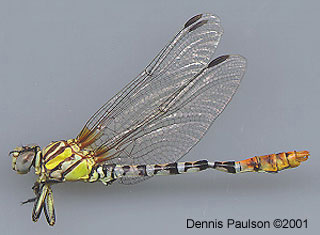
Erpetogomphus compositus
(White-belted Ringtail)
Order: Odonata
Suborder: Anisoptera
Order Description: Dragonflies
Family: Gomphidae
Family Description: Ringtail
Description:
Naiad- The naiad of this species is medium sized. As with other species in this family, the tip of the abdomen is pointed up. It has small hooks on the top of abdominal segments two through nine, and a single, rear-facing spine on each side of abdominal segments six through nine.
Adult- This is a medium-sized dragonfly with a length of 1 7/8 to 2 1/4 inches (46 to 55 mm). The face is white and the thorax is whitish yellow and striped with black. The abdomen is black, with yellowish or white rings at the segment joints. Only the male has a clubbed tip of the abdomen.
Range:
This species is found from northern Oregon east to Wyoming and south to northern Baja California and Sonoran, Mexico. In Idaho, it is found at desert streams in the southwest corner of the state.
Habitat:
This dragonfly can be found near streams and rivers in desert and sagebrush steppe areas.
Adult Flight Season:
Mid-July to mid-August
Diet:
Naiad- Naiads feed on a wide variety of aquatic insects, such as mosquito larvae, other aquatic fly larvae, mayfly larvae, and freshwater shrimp. They will also eat small fish and tadpoles.
Adult- The dragonfly will eat almost any soft-bodied flying insect including mosquitoes, flies, butterflies, moths, mayflies, and flying ants or termites.
Ecology:
Clubtail naiads can be very selective in their habitat choice and will often occur only in certain stretches of a particular river or stream. They burrow into the sand or mud, leaving the upturned tip of their abdomen exposed. This allows them to breathe while buried by pumping water in and out of the tip of the abdomen. Unlike most species, the Clubtail naiads emerge as adults during the day. Adults generally fly from mid-July to mid-August. They can not tolerate cooler temperatures and are rarely seen flying on cool or cloudy days. Hunting occurs from perches on rocks or twigs.
Reproduction:
Males establish and defend territories along streams. After males and females mate, the female flies singly, without the male attached, to lay her eggs by dipping the tip of her abdomen in a river or stream while hovering above it.
Conservation:
Populations are widespread, abundant, and secure.
| Global Rank: | G5 |
| State Rank: | S? |
References:
Corbet, P. S. 1999. Dragonflies: Behavior and Ecology of Odonata. Cornell University Press, Ithaca, New York, USA, 829pp.
Logan, E. R. 1967. The Odonata of Idaho. Unpublished M. S. thesis. University of Idaho, Moscow, Idaho, USA, 105 pp.
Needham, J. G. and M. J. Westfall. 1955. Dragonflies of North America. University of California Press, Berkely, California, USA, 615 pp.
Paulson, D. R. 1999. Dragonflies of Washington. Seattle Audubon Society, Seattle, Washington, USA, 32 pp.
Walker, E. M. and P. S. Corbet. 1975. The Odonata of Canada and Alaska, Vol. III. University of Toronto Press, Toronto, Ontario, Canada, 307 pp.
Written by Mark Lung and Stefan Sommer, 2001
Photos by Dennis Paulson, 2001
Design by Ean Harker, 2001.

Gomphus externus
(Plains Clubtail)
Order: Odonata
Suborder: Anisoptera
Order Description: Dragonflies
Family: Gomphidae
Family Description: Clubtail
Description:
Naiad- This is a large naiad with a maximum length of 1 5/16 inches (33 mm). The abdomen is thick for most of its length, then tapers to a rounded point at the end of segment ten. There is a single, rear-facing spine on each side of abdominal segments six through nine. There are no dorsal hooks.
Adult- This is a medium to large dragonfly with a length of 2 1/16 to 2 3/8 inches (52 to 59 mm). The base color is brownish black. The face is marked with yellow. The top of the thorax behind the head is marked with a parallel pair of yellow stripes, and each side of the thorax is marked with several diagonal yellow stripes. The base of the wings may be clouded with yellow where they attach to the body. The abdomen is black and marked with a line of yellow dashes along the top. As with other Clubtails, the segments at the tip of the abdomen are wider than the rest.
Range:
This species is found from Manitoba south through Wisconsin and Minnesota to New Mexico and Texas, and in northeastern Utah and the southeast corner of Idaho. The population in Utah and Idaho is isolated from the main range of this species by several hundred miles.
Habitat:
This dragonfly can be found near large, slow, muddy streams and rivers.
Adult Flight Season:
Mid-July to mid-August
Diet:
Naiad- Naiads feed on a wide variety of aquatic insects, such as mosquito larvae, other aquatic fly larvae, mayfly larvae, and freshwater shrimp. They will also eat small fish and tadpoles.
Adult- The dragonfly will eat almost any soft-bodied flying insect including mosquitoes, flies, butterflies, moths, mayflies, and flying ants or termites.
Ecology:
Clubtail naiads can be very selective in their habitat choice and will often occur only in certain stretches of a particular river or stream. They burrow into the sand or mud, leaving the upturned tip of their abdomen exposed. This allows them to breathe while buried by pumping water in and out of the tip of the abdomen. Unlike most species the Clubtail naiads emerge as adults during the day. Adults generally fly from mid-July to mid-August. They can not tolerate cooler temperatures and are rarely seen flying on cool or cloudy days. Hunting occurs from perches on rocks or bare sand. They perch with their abdomen elevated and their wings drooping so the tips just touch the ground.
Reproduction:
After males and females mate, the female flies singly, without the male attached, to lay her eggs by dipping the tip of her abdomen in rivers, lakes, or slow streams while hovering above it. Lab experiments have found that females are capable of laying over 5000 eggs.
Conservation:
Populations are widespread, abundant, and secure.
| Global Rank: | G5 |
| State Rank: | S? |
References:
Corbet, P. S. 1999. Dragonflies: Behavior and Ecology of Odonata. Cornell University Press, Ithaca, New York, USA, 829pp.
Logan, E. R. 1967. The Odonata of Idaho. Unpublished M. S. thesis. University of Idaho, Moscow, Idaho, USA, 105 pp.
Needham, J. G. and M. J. Westfall. 1955. Dragonflies of North America. University of California Press, Berkely, California, USA, 615 pp.
Paulson, D. R. 1999. Dragonflies of Washington. Seattle Audubon Society, Seattle, Washington, USA, 32 pp.
Walker, E. M. and P. S. Corbet. 1975. The Odonata of Canada and Alaska, Vol. III. University of Toronto Press, Toronto, Ontario, Canada, 307 pp.
Written by Mark Lung and Stefan Sommer, 2001
Photos by , 2001
Design by Ean Harker, 2001.
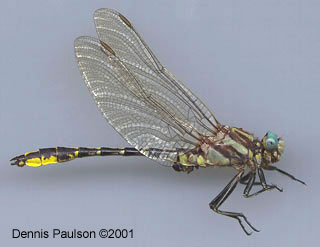
Gomphus graslinellus
(Pronghorn Clubtail)
Order: Odonata
Suborder: Anisoptera
Order Description: Dragonflies
Family: Gomphidae
Family Description: Clubtail
Description:
Naiad- This is a large naiad with a maximum length of 1 1/8 inches (29 mm). The abdomen is widest at segment five. There is a curved hook on the top of each abdominal segment two through nine, and there is a single, rear-facing spine on each side of abdominal segments seven through nine.
Adult- This is a medium-sized dragonfly with a length of 1 7/8 to 2 1/8 inches (47 to 53 mm). The face and thorax are olive green, with the thorax marked with dark brown stripes. The abdomen is dark brown to black and is marked along the top with a line of elongated, triangular-shaped marks varying in color from greenish to yellow. The underside of the tip of the abdomen is marked with yellow and is swollen as in other Clubtails.
Range:
This species is found from southern British Columbia east to southwestern Ontario, extending south to Washington, Oklahoma, and Missouri. In Idaho, it is found in the northern half of the state.
Habitat:
This dragonfly can be found near lakes, ponds and slow streams.
Adult Flight Season:
Early June to August
Diet:
Naiad- Naiads feed on a wide variety of aquatic insects, such as mosquito larvae, other aquatic fly larvae, mayfly larvae, and freshwater shrimp. They will also eat small fish and tadpoles.
Adult- The dragonfly will eat almost any soft-bodied flying insect including mosquitoes, flies, butterflies, moths, mayflies, and flying ants or termites.
Ecology:
Clubtail naiads can be very selective in their habitat choice and will often occur only in certain stretches of a particular stream, lake, or pond. They burrow into the sand or mud, leaving the upturned tip of their abdomen exposed. This allows them to breathe while buried by pumping water in and out of the tip of the abdomen. These naiads emerge as adults at the water's edge just before sunrise. Although records are sparse, adults are believed to fly from early June to August. They can not tolerate cooler temperatures and are rarely seen flying on cool or cloudy days. Hunting occurs from perches on rocks or twigs.
Reproduction:
After males and females mate, the female flies singly, without the male attached, to lay her eggs by dipping the tip of her abdomen in rivers, lakes, or slow streams while hovering above it.
Conservation:
Populations are widespread, abundant, and secure.
| Global Rank: | G5 |
| State Rank: | S? |
References:
Corbet, P. S. 1999. Dragonflies: Behavior and Ecology of Odonata. Cornell University Press, Ithaca, New York, USA, 829pp.
Logan, E. R. 1967. The Odonata of Idaho. Unpublished M. S. thesis. University of Idaho, Moscow, Idaho, USA, 105 pp.
Needham, J. G. and M. J. Westfall. 1955. Dragonflies of North America. University of California Press, Berkely, California, USA, 615 pp.
Paulson, D. R. 1999. Dragonflies of Washington. Seattle Audubon Society, Seattle, Washington, USA, 32 pp.
Walker, E. M. and P. S. Corbet. 1975. The Odonata of Canada and Alaska, Vol. III. University of Toronto Press, Toronto, Ontario, Canada, 307 pp.
Written by Mark Lung and Stefan Sommer, 2001
Photos by Dennis Paulson, 2001
Design by Ean Harker, 2001.
HTML by Marty Peck, 2001.

Ophiogomphus severus
(Pale Snaketail)
Order: Odonata
Suborder: Anisoptera
Order Description: Dragonflies
Family: Gomphidae
Family Description: Snaketail
Description:
Naiad- This is a large, robust naiad with a length of 1 inch (25 to 27 mm). There is a curved hook on the top of each abdominal segment two through nine, and there is a single, rear-facing spine on each side of abdominal segments seven through nine. The abdomen turns up at the tip.
Adult- This is a medium-sized dragonfly with a length of 2 inches (49 to 52 mm). The face and thorax are yellowish green. The top of the thorax may be marked with black while each side is unmarked. The abdomen is black and marked with yellow on the top of each segment. The underside of the tip of the abdomen is marked with yellow and is swollen as in other members of this family. The female's abdomen may appear olive brown to yellowish green, especially when viewed from the side.
Range:
This species is found from southern British Columbia east to Alberta, extending south to northern California, Colorado, and Nebraska. In Idaho, it is found throughout the state in river systems at lower elevations.
Habitat:
This dragonfly occurs near low elevation rivers and streams.
Adult Flight Season:
Mid-May to September
Diet:
Naiad- Naiads feed on a wide variety of aquatic insects, such as mosquito larvae, other aquatic fly larvae, mayfly larvae, and freshwater shrimp. They will also eat small fish and tadpoles.
Adult- The dragonfly will eat almost any soft-bodied flying insect including mosquitoes, flies, butterflies, moths, mayflies, and flying ants or termites.
Ecology:
Clubtail naiads can be very selective in their habitat choices and will often occur only in certain stretches of a particular river or stream. Sinuous Snaketail naiads seem to be more tolerant of higher stream gradients and lower water temperatures than most members of this family, and are often found in cold trout streams. They burrow into the sand or mud, leaving the upturned tip of their abdomen exposed. This allows them to breathe while buried by pumping water in and out of the tip of the abdomen. Unlike most species, Clubtail naiads generally emerge as adults during the day.
Adults generally fly from mid-May to September, and are commonly seen perching on gravel bars. They can not tolerate cooler temperatures and are rarely seen flying on cool or cloudy days. This is probably the most common member of the Gomphidae family in Idaho.
Reproduction:
After males and females mate, the female flies singly, without the male attached, to lay her eggs by dipping the tip of her abdomen in rivers or streams while perching on a rock.
Conservation:
Populations are widespread, abundant, and secure.
| Global Rank: | G5 |
| State Rank: | S? |
References:
Corbet, P. S. 1999. Dragonflies: Behavior and Ecology of Odonata. Cornell University Press, Ithaca, New York, USA, 829pp.
Logan, E. R. 1967. The Odonata of Idaho. Unpublished M. S. thesis. University of Idaho, Moscow, Idaho, USA, 105 pp.
Needham, J. G. and M. J. Westfall. 1955. Dragonflies of North America. University of California Press, Berkely, California, USA, 615 pp.
Paulson, D. R. 1999. Dragonflies of Washington. Seattle Audubon Society, Seattle, Washington, USA, 32 pp.
Walker, E. M. and P. S. Corbet. 1975. The Odonata of Canada and Alaska, Vol. III. University of Toronto Press, Toronto, Ontario, Canada, 307 pp.
Written by Mark Lung and Stefan Sommer, 2001
Photos by Dennis Paulson, 2001
Design by Ean Harker, 2001.
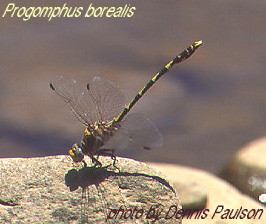
Progomphus borealis
(Gray Sanddragon)
Order: Odonata
Suborder: Anisoptera
Order Description: Dragonflies
Family: Gomphidae
Family Description: Sanddragon
Description:
Naiad- This is a large naiad with a length of 1 inch (25 to 27 mm). It is sandy brown in color and has short legs covered with stiff bristles. The abdomen turns up at the tip, and there is a single, rear-facing spine on each side of abdominal segments three through nine.
Adult- This is a medium to large dragonfly with a maximum length of 2 ž inches (57 mm). The face and thorax are grayish to yellowish brown, and the thorax may be marked with black. The abdomen is black and marked with yellow on the top of each segment. The underside of the tip of the abdomen is marked with yellow as well, and the abdominal tip is swollen as in other members of this family.
Range:
This species is found from eastern Oregon and southwestern Idaho south to California and Texas. It is also found in Sonora and Chihuahua and south to Jalisco in Mexico. In Idaho, it is found at desert streams in the southwest corner of the state.
Habitat:
This dragonfly can be found near sandy streams in desert areas.
Adult Flight Season:
Early June to September
Diet:
Naiad- Naiads feed on a wide variety of aquatic insects, such as mosquito larvae, other aquatic fly larvae, mayfly larvae, and freshwater shrimp. They will also eat small fish and tadpoles.
Adult- The dragonfly will eat almost any soft-bodied flying insect including mosquitoes, flies, butterflies, moths, mayflies, and flying ants or termites.
Ecology:
Naiads can be very selective in their habitat choices and will often occur only in certain stretches of a particular river or stream. They burrow into the sand, leaving the upturned tip of their abdomen exposed. This allows them to breathe while buried by pumping water in and out of the tip of the abdomen. Unlike most other species the Clubtail naiads emerge as adults during the day. Although records are sparse, the adults are believed to fly from early June to September. They can not tolerate cooler temperatures and are rarely seen flying on cool or cloudy days.
Reproduction:
After males and females mate, the female flies singly, without the male attached, to lay her eggs by dipping the tip of her abdomen in the shallows of small streams while hovering above it.
Conservation:
Populations are widespread, abundant, and secure.
| Global Rank: | G5 |
| State Rank: | S? |
References:
Corbet, P. S. 1999. Dragonflies: Behavior and Ecology of Odonata. Cornell University Press, Ithaca, New York, USA, 829pp.
Logan, E. R. 1967. The Odonata of Idaho. Unpublished M. S. thesis. University of Idaho, Moscow, Idaho, USA, 105 pp.
Needham, J. G. and M. J. Westfall. 1955. Dragonflies of North America. University of California Press, Berkely, California, USA, 615 pp.
Paulson, D. R. 1999. Dragonflies of Washington. Seattle Audubon Society, Seattle, Washington, USA, 32 pp.
Walker, E. M. and P. S. Corbet. 1975. The Odonata of Canada and Alaska, Vol. III. University of Toronto Press, Toronto, Ontario, Canada, 307 pp.
Written by Mark Lung and Stefan Sommer, 2001
Photos by Dennis Paulson, 2001
Design by Ean Harker, 2001.
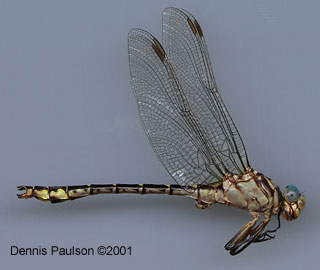
Stylurus (Gomphus) olivaceous
(Olive Clubtail)
Order: Odonata
Suborder: Anisoptera
Order Description: Dragonflies
Family: Gomphidae
Family Description: Clubtail
Description:
Naiad- This is a large, slender naiad with a maximum length of 1 ½ inches (36 mm). There is a short, rear-facing spine on each side of abdominal segments eight and nine.
Adult- This is a medium to large dragonfly with a length of 2 ¼ to 2 ½ inches (56 to 60 mm). The eyes are a remarkable turquoise blue. The face and thorax are olive green, and there may be some black markings on the top of the thorax behind the head. The abdomen is brownish black and is marked along the top with yellowish, funnel-shaped marks. The underside of the tip of the abdomen is also marked with yellow, and the rearmost segments appear swollen as in other members of this family. The female may be more yellowish green than olive green, and may have more yellow on the sides of the abdomen.
Range:
This species is found from southern British Columbia south to central California and east to Nebraska. In Idaho, it occurs along the Snake River from Massacre Rocks near American Falls downstream, and along the Bear River.
Habitat:
This dragonfly can be found at large, nutrient-rich rivers.
Adult Flight Season:
Early August to mid-October
Diet:
Naiad- Naiads feed on a wide variety of aquatic insects, such as mosquito larvae, other aquatic fly larvae, mayfly larvae, and freshwater shrimp. They will also eat small fish and tadpoles.
Adult- The dragonfly will eat almost any soft-bodied flying insect including mosquitoes, flies, butterflies, moths, mayflies, and flying ants or termites.
Ecology:
Naiads can be very selective in their habitat choices and will often occur only in certain stretches of a particular river or stream. They burrow into the sand or mud, leaving the upturned tip of their abdomen exposed. This allows them to breathe while buried by pumping water in and out of the tip of the abdomen. Unlike most other species, the Clubtail naiads emerge as adults during the day. Adults generally fly from early August to mid-October. They perch on trees and bushes, often far from the water.
Reproduction:
After males and females mate, the female flies singly, without the male attached, to lay her eggs by dipping the tip of her abdomen in the water while hovering above it. This is usually done in large rivers.
Conservation:
Populations are widespread, abundant, and secure.
| Global Rank: | G5 |
| State Rank: | S? |
References:
Corbet, P. S. 1999. Dragonflies: Behavior and Ecology of Odonata. Cornell University Press, Ithaca, New York, USA, 829pp.
Logan, E. R. 1967. The Odonata of Idaho. Unpublished M. S. thesis. University of Idaho, Moscow, Idaho, USA, 105 pp.
Needham, J. G. and M. J. Westfall. 1955. Dragonflies of North America. University of California Press, Berkely, California, USA, 615 pp.
Paulson, D. R. 1999. Dragonflies of Washington. Seattle Audubon Society, Seattle, Washington, USA, 32 pp.
Walker, E. M. and P. S. Corbet. 1975. The Odonata of Canada and Alaska, Vol. III. University of Toronto Press, Toronto, Ontario, Canada, 307 pp.
Written by Mark Lung and Stefan Sommer, 2001
Photos by Dennis Paulson, 2001
Design by Ean Harker, 2001.
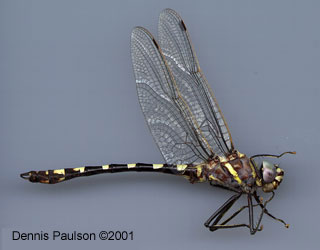
Macromia magnifica
(Western River Cruiser)
Order: Odonata
Suborder: Anisoptera
Order Description: Dragonflies
Family: Macromiidae
Family Description: Cruiser
Description:
Naiad- This is a large naiad 1 ž inches (30 to 32 mm) long. It has a large, rounded abdomen and long legs, giving it a spider-like appearance. There is a curved hook on the top of abdominal segments two through ten, and a single, rear-facing spine on each side of abdominal segments eight and nine.
Adult- This is a large dragonfly with a length of 2 ū to 3 inches (69 to 74 mm). The eyes are green. The thorax is greenish brown with a metallic luster and may be marked on the top and sides with yellow. The abdomen is black and ringed with yellow, but the rings do not completely encircle the abdomen. The tip of the abdomen appears swollen ("clubbed").
Range:
This species is found from southern British Columbia south to California and Arizona. In Idaho, it occurs in the southwestern corner of the state.
Habitat:
This dragonfly can be found near rivers with dense aquatic weeds. In Idaho, this species is found almost exclusively along warm-water rivers.
Adult Flight Season:
Mid-June to late August
Diet:
Naiad- Naiads feed on a wide variety of aquatic insects, such as mosquito larvae, other aquatic fly larvae, mayfly larvae, and freshwater shrimp. They will also eat small fish and tadpoles.
Adult- The dragonfly will eat almost any soft-bodied flying insect including mosquitoes, flies, butterflies, moths, mayflies, and flying ants or termites.
Ecology:
The naiads live on submerged weeds and tree roots in rivers. They are ambush predators, waiting for prey to pass by. They emerge as adults during the night. Although records are sparse, adults are believed to fly from mid-June through late August. Adults hunt while on the wing, and fly at high speeds often down the middle of rivers and streams.
Reproduction:
Males actively patrol in search of receptive females during the morning. After males and females mate, the females fly singly, without the male attached, to deposit their eggs. The tip of the abdomen is dipped into the water, typically a weedy river, while flying just above the surface. Both males and females disappear by early afternoon.
Conservation:
Populations are widespread, abundant, and secure.
| Global Rank: | G5 |
| State Rank: | S? |
References:
Corbet, P. S. 1999. Dragonflies: Behavior and Ecology of Odonata. Cornell University Press, Ithaca, New York, USA, 829pp.
Logan, E. R. 1967. The Odonata of Idaho. Unpublished M. S. thesis. University of Idaho, Moscow, Idaho, USA, 105 pp.
Needham, J. G. and M. J. Westfall. 1955. Dragonflies of North America. University of California Press, Berkely, California, USA, 615 pp.
Paulson, D. R. 1999. Dragonflies of Washington. Seattle Audubon Society, Seattle, Washington, USA, 32 pp.
Walker, E. M. and P. S. Corbet. 1975. The Odonata of Canada and Alaska, Vol. III. University of Toronto Press, Toronto, Ontario, Canada, 307 pp.
Written by Mark Lung and Stefan Sommer, 2001
Photos by Dennis Paulson, 2001
Design by Ean Harker, 2001.
HTML by Marty Peck, 2001.
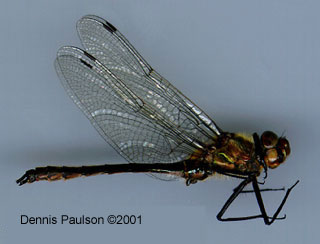
Cordulia shurtleffi
(American Emerald)
Order: Odonata
Suborder: Anisoptera
Order Description: Dragonflies
Family: Corduliidae
Family Description: Emerald
Description:
Naiad- This is a medium-sized naiad, or immature dragonfly, with a length of 13/16 to 1 inch (20 to 23 mm). The abdomen is rounded, giving it a short, stocky appearance known as the sprawler form. The color is uniform brown, with each side of the thorax marked with stripes. There are short, knobby projections along the back, and a single, rear-facing spine on each side of abdominal segments eight and nine.
Adult- This is a medium-sized dragonfly with a length of 1 3/4 to 2 inches (43 to 50 mm). It is metallic bronze-green and lacks any additional markings.
Range:
This species is found from Alaska east across Canada to Labrador, extending south to California, Ohio, and Connecticut. In Idaho, it is found in the panhandle region.
Habitat:
This dragonfly can be found near mountain lakes, bogs, and marshes.
Adult Flight Season:
Mid May to late June
Diet:
Naiad- Naiads feed on a wide variety of aquatic insects, such as mosquito larvae, other aquatic fly larvae, mayfly larvae, and freshwater shrimp. They will also eat small fish and tadpoles.
Adult- The dragonfly will eat almost any soft-bodied flying insect including mosquitoes, flies, butterflies, moths, mayflies, and stoneflies.
Ecology:
The naiads live in submerged vegetation and woody debris on the bottom of lakes or bogs, and seem to tolerate very cold water. They do not actively pursue prey but wait for it pass by, a strategy which affords them protection from other predators. Naiads may require several years to mature, and typically emerge as adults at night. It is one of the first dragonfly species to emerge in the spring.
Reproduction:
Males patrol along the water's edge searching for receptive females. After males and females mate, the female flies singly, without the male attached, to lay her eggs by dipping the tip of her abdomen on the surface of the water while hovering above it.
Conservation:
Populations are widespread, abundant, and secure.
| Global Rank: | G5 |
| State Rank: | S? |
References:
Corbet, P. S. 1999. Dragonflies: Behavior and Ecology of Odonata. Cornell University Press, Ithaca, New York, USA, 829pp.
Logan, E. R. 1967. The Odonata of Idaho. Unpublished M. S. thesis. University of Idaho, Moscow, Idaho, USA, 105 pp.
Needham, J. G. and M. J. Westfall. 1955. Dragonflies of North America. University of California Press, Berkely, California, USA, 615 pp.
Paulson, D. R. 1999. Dragonflies of Washington. Seattle Audubon Society, Seattle, Washington, USA, 32 pp.
Walker, E. M. and P. S. Corbet. 1975. The Odonata of Canada and Alaska, Vol. III. University of Toronto Press, Toronto, Ontario, Canada, 307 pp.
Written by Mark Lung and Stefan Sommer, 2001
Photos by Dennis Paulson, 2001
Design by Ean Harker, 2001.
HTML by Marty Peck, 2001.
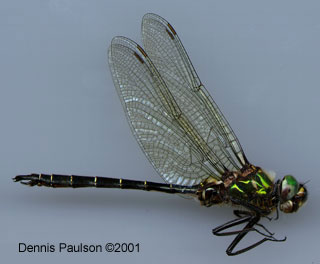
Somatochlora albicincta
(White-ringed Emerald)
Order: Odonata
Suborder: Anisoptera
Order Description: Dragonflies
Family: Corduliidae
Family Description: Emerald
Description:
Naiad- This is a medium-sized naiad with a length of 13/16 to 1 inch (20 to 23.5 mm). The abdomen is rounded, giving it a short, stocky appearance known as the sprawler form. The color is uniform brown, and the sides of the thorax are unmarked. There is a single, rear-facing spine on each side of abdominal segments eight and nine.
Adult- This is a medium-sized dragonfly with a length of 1 3/4 to 2 1/16 inches (45 to 52 mm). It is a brilliant metallic green, with each side of the thorax marked with several wavy yellowish stripes or dashes. Each abdominal segment is ringed with yellowish white where it joins with the following segment. The eyes are bright green.
Range:
This species is found from Alaska east across Canada to Labrador, extending south to Washington and New Hampshire. In Idaho, it has been documented to occur only at the Roman Nose lakes in Boundary County, but it probably occurs in the mountains of the northern and central portions of the state.
Habitat:
This dragonfly can be found near mountain lakes.
Adult Flight Season:
Late June to September
Diet:
Naiad- Naiads feed on a wide variety of aquatic insects, such as mosquito larvae, other aquatic fly larvae, mayfly larvae, and freshwater shrimp. They will also eat small fish and tadpoles.
Adult- The dragonfly will eat almost any soft-bodied flying insect including mosquitoes, flies, butterflies, moths, mayflies, and flying ants or termites.
Ecology:
The naiads live in submerged vegetation and woody debris on lake bottoms. They do not actively pursue prey but wait for it to pass by, a strategy which affords them protection from other predators. Naiads may require several years to mature, and typically emerge as adults at night. Although records are sparse, adults are believed to fly from late June to September.
Reproduction:
The males establish and defend territories along the shores of mountain lakes, and actively patrol them in search of receptive females. Males on patrol can be very aggressive and will chase dragonfly species much larger than themselves. After males and females mate, the female flies singly, without the male attached, to lay her eggs by dipping the tip of her abdomen on the surface of the water while hovering above it.
Conservation:
Populations are widespread, abundant, and secure.
| Global Rank: | G5 |
| State Rank: | S? |
References:
Corbet, P. S. 1999. Dragonflies: Behavior and Ecology of Odonata. Cornell University Press, Ithaca, New York, USA, 829pp.
Logan, E. R. 1967. The Odonata of Idaho. Unpublished M. S. thesis. University of Idaho, Moscow, Idaho, USA, 105 pp.
Needham, J. G. and M. J. Westfall. 1955. Dragonflies of North America. University of California Press, Berkely, California, USA, 615 pp.
Paulson, D. R. 1999. Dragonflies of Washington. Seattle Audubon Society, Seattle, Washington, USA, 32 pp.
Walker, E. M. and P. S. Corbet. 1975. The Odonata of Canada and Alaska, Vol. III. University of Toronto Press, Toronto, Ontario, Canada, 307 pp.
Written by Mark Lung and Stefan Sommer, 2001
Photos by Dennis Paulson, 2001
Design by Ean Harker, 2001.
HTML by Marty Peck, 2001.
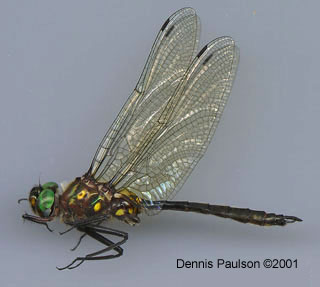
Somatochlora minor
(Ocellated Emerald)
Order: Odonata
Suborder: Anisoptera
Order Description: Dragonflies
Family: Corduliidae
Family Description: Emerald
Description:
Naiad- This is a medium-sized naiad with a length of 13/16 to 15/16 inch (20 to 22 mm). The abdomen is rounded, giving it a short, stocky appearance known as the sprawler form. The color is pale to dark brown, and the sides of the thorax are unmarked. It has small hooks on the tops of abdominal segments four through nine, and a single, rear-facing spine on each side of abdominal segments eight and nine.
Adult- This is a medium-sized dragonfly with a length of 1 11/16 to 2 inches (42 to 50 mm). It is a brilliant metallic green and is marked with several golden yellow spots on the thorax. The upper anal appendages of the males are straight and touch at the tips.
Range:
This species is found from British Columbia east to Nova Scotia, extending south to Washington, Wyoming, and New York. In Idaho, it occurs in the northern half of the state.
Habitat:
This dragonfly can be found near slow, clear streams. In Idaho and eastern Washington, this dragonfly is typically found along slow, willow-lined streams, often with sandy or muddy bottoms.
Adult Flight Season:
Early June to late July
Diet:
Naiad- Naiads feed on a wide variety of aquatic insects, such as mosquito larvae, other aquatic fly larvae, mayfly larvae, and freshwater shrimp. They will also eat small fish and tadpoles.
Adult- The dragonfly will eat almost any soft-bodied flying insect including mosquitoes, flies, butterflies, moths, mayflies, and flying ants or termites.
Ecology:
The naiads live in debris on stream bottoms. They do not actively pursue prey but wait for it to pass by, a strategy which affords them protection from other predators. Naiads may require several years to mature, and typically emerge as adults at night. Adults generally fly from early June through July.
Reproduction:
After males and females mate, the female flies singly, without the male attached, to lay her eggs by dipping the tip of her abdomen on the surface of the water while hovering above it.
Conservation:
Populations are widespread, abundant, and secure.
| Global Rank: | G5 |
| State Rank: | S? |
References:
Corbet, P. S. 1999. Dragonflies: Behavior and Ecology of Odonata. Cornell University Press, Ithaca, New York, USA, 829pp.
Logan, E. R. 1967. The Odonata of Idaho. Unpublished M. S. thesis. University of Idaho, Moscow, Idaho, USA, 105 pp.
Needham, J. G. and M. J. Westfall. 1955. Dragonflies of North America. University of California Press, Berkely, California, USA, 615 pp.
Paulson, D. R. 1999. Dragonflies of Washington. Seattle Audubon Society, Seattle, Washington, USA, 32 pp.
Walker, E. M. and P. S. Corbet. 1975. The Odonata of Canada and Alaska, Vol. III. University of Toronto Press, Toronto, Ontario, Canada, 307 pp.
Written by Mark Lung and Stefan Sommer, 2001
Photos by Dennis Paulson, 2001
Design by Ean Harker, 2001.
HTML by Marty Peck, 2001.
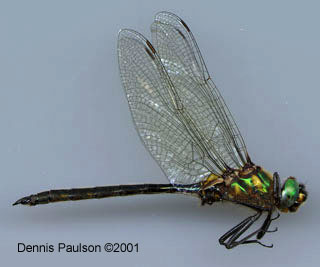
Somatochlora semicircularis
(Mountain Emerald)
Order: Odonata
Suborder: Anisoptera
Order Description: Dragonflies
Family: Corduliidae
Family Description: Emerald
Description:
Naiad- This is a medium-sized naiad with a length of 7/8 inch (21 to 22 mm). The abdomen is rounded, giving it a short, stocky appearance known as the sprawler form. The color is pale to dark brown, and the sides of the thorax are unmarked. There are no hooks or knobs along the back, but there is a single, rear-facing spine on each side of abdominal segment nine.
Adult- This is a medium-sized dragonfly with a length of 1 7/8 to 2 1/16 inches (47 to 52 mm). It is a brilliant metallic green, with each side of the thorax marked with two yellowish gold stripes. The top of the abdomen may be marked with one or two pairs of yellow spots near where it meets the thorax. The upper anal appendages of the male curve together to touch at the tips.
Range:
This is a northwestern species found from southern Alaska south through British Columbia to northern California and western Colorado. In Idaho, it occurs in the northern half of the state.
Habitat:
This dragonfly can be found near marshy bogs and ponds, especially those surrounded by a lot of vegetation.
Adult Flight Season:
Early June to late July
Diet:
Naiad- Naiads feed on a wide variety of aquatic insects, such as mosquito larvae, other aquatic fly larvae, mayfly larvae, and freshwater shrimp. They will also eat small fish and tadpoles.
Adult- The dragonfly will eat almost any soft-bodied flying insect including mosquitoes, flies, butterflies, moths, mayflies, and flying ants or termites.
Ecology:
The naiads live in submerged vegetation. They do not actively pursue prey but wait for it to pass by, a strategy which affords them protection from other predators. Naiads may require several years to mature, and typically emerge as adults at night. Adults generally fly from early June through July.
Reproduction:
The male captures a receptive females while she is resting on vegetation, and then takes her on a long nuptial flight lasting several minutes, after which they perch together in tandem. After they separate the female begins laying her eggs by dipping the tip of her abdomen on the surface of the water while hovering above it.
Conservation:
Populations are widespread, abundant, and secure.
| Global Rank: | G5 |
| State Rank: | S? |
References:
Corbet, P. S. 1999. Dragonflies: Behavior and Ecology of Odonata. Cornell University Press, Ithaca, New York, USA, 829pp.
Logan, E. R. 1967. The Odonata of Idaho. Unpublished M. S. thesis. University of Idaho, Moscow, Idaho, USA, 105 pp.
Needham, J. G. and M. J. Westfall. 1955. Dragonflies of North America. University of California Press, Berkely, California, USA, 615 pp.
Paulson, D. R. 1999. Dragonflies of Washington. Seattle Audubon Society, Seattle, Washington, USA, 32 pp.
Walker, E. M. and P. S. Corbet. 1975. The Odonata of Canada and Alaska, Vol. III. University of Toronto Press, Toronto, Ontario, Canada, 307 pp.
Written by Mark Lung and Stefan Sommer, 2001
Photos by Dennis Paulson, 2001
Design by Ean Harker, 2001.
HTML by Marty Peck, 2001.
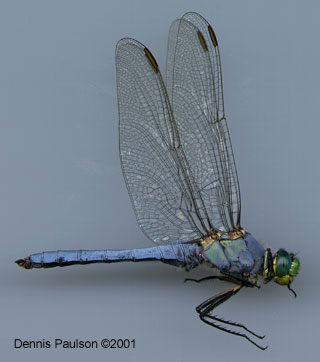
Erythemis collacata
(Western Pondhawk)
Order: Odonata
Suborder: Anisoptera
Order Description: Dragonflies
Family: Libellulidae
Family Description: Pondhawk
Description:
Naiad- This is a small naiad with a length of 5/8 to 3/4 inch (15 to 17 mm). The abdomen is rounded, giving it a short, stocky appearance known as the sprawler form. The color is a uniform green, and there are no hooks or spines on any of the abdominal segments.
Adult- This is a medium-sized dragonfly with a length of 1 5/8 to 1 11/16 inches (40 to 42 mm). The body appears thick and somewhat stubby. Females and immature males are a uniform bright green from the face to the tip of the abdomen, while mature males are covered with a powdery slate blue (a condition called "pruinose"). The sides of the thorax may have several small patches of hazy green.
Range:
This species is found from southern British Columbia east to Alberta, extending south to southern California. In Idaho, it occurs throughout the state at lower elevations.
Habitat:
This dragonfly can be found near warm, marshy lakes and ponds.
Adult Flight Season:
Mid-April to early October
Diet:
Naiad- Naiads feed on a wide variety of aquatic insects, such as mosquito larvae, other aquatic fly larvae, mayfly larvae, and freshwater shrimp. They will also eat small fish and tadpoles.
Adult- The dragonfly will eat almost any soft-bodied flying insect including mosquitoes, flies, butterflies, moths, mayflies, and flying ants or termites.
Ecology:
The naiads live in submerged vegetation. They do not actively pursue prey but wait for it to pass by, a strategy which affords them protection from other predators. Naiads emerge as adults at night. Adults generally fly from mid-April to early October. This species has large, powerful mandibles for its size, and often eats comparatively large insects, such as butterflies and other dragonflies. Adults hunt from perches on twigs or rocks.
Reproduction:
After males and females mate, the female flies singly, without the male attached, to lay her eggs. She does this by dipping the tip of her abdomen in the water while hovering just above its surface.
Conservation:
Populations are widespread, abundant, and secure.
| Global Rank: | G5 |
| State Rank: | S? |
References:
Corbet, P. S. 1999. Dragonflies: Behavior and Ecology of Odonata. Cornell University Press, Ithaca, New York, USA, 829pp.
Logan, E. R. 1967. The Odonata of Idaho. Unpublished M. S. thesis. University of Idaho, Moscow, Idaho, USA, 105 pp.
Needham, J. G. and M. J. Westfall. 1955. Dragonflies of North America. University of California Press, Berkely, California, USA, 615 pp.
Paulson, D. R. 1999. Dragonflies of Washington. Seattle Audubon Society, Seattle, Washington, USA, 32 pp.
Walker, E. M. and P. S. Corbet. 1975. The Odonata of Canada and Alaska, Vol. III. University of Toronto Press, Toronto, Ontario, Canada, 307 pp.
Written by Mark Lung and Stefan Sommer, 2001
Photos by Dennis Paulson, 2001
Design by Ean Harker, 2001.
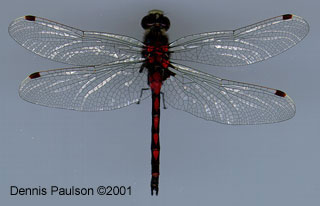
Leucorrhinia hudsonica
(Hudsonian Whiteface)
Order: Odonata
Suborder: Anisoptera
Order Description: Dragonflies
Family: Libellulidae
Family Description: Whiteface
Description:
Naiad- This is a small naiad with a length of 5/8 to 3/4 inch (16 to 18 mm). The abdomen is rounded, giving it a short, stocky appearance known as the sprawler form. It is brown with three dark stripes marking the length of the underside of the abdomen. There may be very small hooks on the tops of abdominal segments three through six, or they may be absent. Each side of abdominal segments eight and nine has a spine that points out away from the abdomen.
Adult- This is a small dragonfly with a length of 1 1/16 to 1 3/16 inches (27 to 30 mm). The male is black and marked with red on the thorax and abdomen; the marks on the abdomen are elongated spots, possibly pointed on one end, which form a line along the length of the top side of the abdomen. The female is brownish black and marked similarly to the male except the markings are yellow instead of black. The face of both sexes is creamy white.
Range:
This species is found from Alaska east to Labrador, extending south to Oregon, Utah, and Pennsylvania. In Idaho, it occurs in the northern and central portions of the state, primarily at higher elevations.
Habitat:
This dragonfly can be found at marshy lakes, ponds, and bogs at higher elevations.
Adult Flight Season:
Late May to mid-August
Diet:
Naiad- Naiads feed on a wide variety of aquatic insects, such as mosquito larvae, other aquatic fly larvae, mayfly larvae, and freshwater shrimp. They will also eat small fish and tadpoles.
Adult- The dragonfly will eat almost any soft-bodied flying insect including mosquitoes, flies, butterflies, moths, mayflies, and flying ants or termites.
Ecology:
The naiads live in submerged vegetation. They do not actively pursue prey but wait for it to pass by, a strategy which affords them protection from other predators. Naiads emerge as adults at night. Although records are sparse, adults are believed to fly from late May to mid-August. Hunting occurs from perches on shoreline vegetation. Specimens from Idaho tend to be larger than those found further north. Adults have been known to swarm over sphagnum bogs in the northern part of its range.
Reproduction:
After mating, a male will actively guard a female to prevent other males from mating with her. He does this by flying above her while she lays her eggs, and by driving away other potential mates or even dragonflies of other species. The female lays her eggs by dipping the tip of her abdomen in the water while hovering just above its surface.
Conservation:
Populations are widespread, abundant, and secure.
| Global Rank: | G5 |
| State Rank: | S? |
References:
Corbet, P. S. 1999. Dragonflies: Behavior and Ecology of Odonata. Cornell University Press, Ithaca, New York, USA, 829pp.
Logan, E. R. 1967. The Odonata of Idaho. Unpublished M. S. thesis. University of Idaho, Moscow, Idaho, USA, 105 pp.
Needham, J. G. and M. J. Westfall. 1955. Dragonflies of North America. University of California Press, Berkely, California, USA, 615 pp.
Paulson, D. R. 1999. Dragonflies of Washington. Seattle Audubon Society, Seattle, Washington, USA, 32 pp.
Walker, E. M. and P. S. Corbet. 1975. The Odonata of Canada and Alaska, Vol. III. University of Toronto Press, Toronto, Ontario, Canada, 307 pp.
Written by Mark Lung and Stefan Sommer, 2001
Photos by Dennis Paulson, 2001
Design by Ean Harker, 2001.
HTML by Marty Peck, 2001.
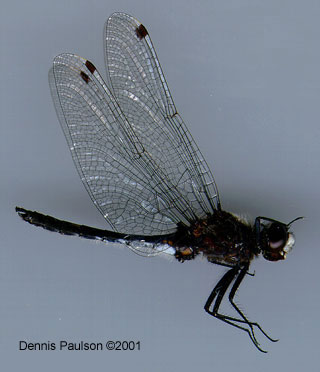
Leucorrhinia intacta
(Dot-tailed Whiteface)
Order: Odonata
Suborder: Anisoptera
Order Description: Dragonflies
Family: Libellulidae
Family Description: Whiteface
Description:
Naiad- This is a small naiad with a length of 9/16 to 3/4 inch (14-19 mm). The abdomen is rounded, giving it a short, stocky appearance known as the sprawler form. It is brown and marked with either three dark stripes or two rows of dark spots running the length of the underside of the abdomen. There are needle-like hooks on the top of abdominal segments three through eight, and a single, rear-facing spine on each side of abdominal segments eight and nine.
Adult- This is a small dragonfly with a length of 1 5/16 to 1 7/16 inches (33 to 36 mm). The face is creamy white, and the thorax and abdomen are generally solid black, marked only with a single yellow spot on the top of abdominal segment seven.
Range:
This species is found from British Columbia east to Manitoba, extending south as far as northern California, South Dakota, and Pennsylvania. It occurs throughout Idaho at lower to middle elevations.
Habitat:
This dragonfly can be found near marshy lakes and ponds, especially those with heavy vegetation.
Adult Flight Season:
Early June to early August
Diet:
Naiad- Naiads feed on a wide variety of aquatic insects, such as mosquito larvae, other aquatic fly larvae, mayfly larvae, and freshwater shrimp. They will also eat small fish and tadpoles.
Adult- The dragonfly will eat almost any soft-bodied flying insect including mosquitoes, flies, butterflies, moths, mayflies, and flying ants or termites.
Ecology:
The naiads live in submerged vegetation. They do not actively pursue prey but wait for it to pass by, a strategy which affords them protection from other predators. Naiads emerge as adults at night. Adults generally fly from early June to early August. This species prefers warmer habitats than most Whitefaces, and is often found sitting on lily pads in heavily vegetated ponds. It hunts from perches on shoreline vegetation.
Reproduction:
After mating, a male will actively guard a female with whom he has mated by flying above her while she lays her eggs. He apparently does ths to prevent other males from mating with her. The female lays her eggs by dipping the tip of her abdomen in the water while hovering just above its surface.
Conservation:
Populations are widespread, abundant, and secure.
| Global Rank: | G5 |
| State Rank: | S? |
References:
Corbet, P. S. 1999. Dragonflies: Behavior and Ecology of Odonata. Cornell University Press, Ithaca, New York, USA, 829pp.
Logan, E. R. 1967. The Odonata of Idaho. Unpublished M. S. thesis. University of Idaho, Moscow, Idaho, USA, 105 pp.
Needham, J. G. and M. J. Westfall. 1955. Dragonflies of North America. University of California Press, Berkely, California, USA, 615 pp.
Paulson, D. R. 1999. Dragonflies of Washington. Seattle Audubon Society, Seattle, Washington, USA, 32 pp.
Walker, E. M. and P. S. Corbet. 1975. The Odonata of Canada and Alaska, Vol. III. University of Toronto Press, Toronto, Ontario, Canada, 307 pp.
Written by Mark Lung and Stefan Sommer, 2001
Photos by Dennis Paulson, 2001
Design by Ean Harker, 2001.
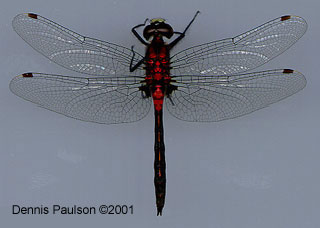
Leucorrhinia proxima
(Red-Waisted Whiteface)
Order: Odonata
Suborder: Anisoptera
Order Description: Dragonflies
Family: Libellulidae
Family Description: Whiteface
Description:
Naiad- This is a small naiad with a length of 3/4 to 7/8 inch (19 to 21 mm). The abdomen is rounded, giving it a short, stocky appearance known as the sprawler form. It is brown and marked with either three dark stripes or two rows of dark spots running the length of the underside of the abdomen. There are needle-like hooks on the top of abdominal segments three through eight, and a single, rear-facing spine on each side of abdominal segments eight and nine.
Adult- This is a small dragonfly with a length of 1 5/16 to 1 7/16 inches (33 to 36 mm). The face is creamy white, and the thorax and abdomen are solid black marked with either metallic red (males) or yellow (females), primarily on the thorax and the front portion of the abdomen where it meets the thorax.
Range:
This species is found from Alaska, east across Canada to Nova Scotia, extending south as far as Washington, Wyoming, and Pennsylvania. In Idaho, it has been observed only at one pond in the mountains north of Salmon; however, it can be expected to occur at high elevations in the northern and central portions of the state.
Habitat:
This dragonfly can be found near marshy lakes and ponds at higher elevations.
Adult Flight Season:
Late May to mid-August
Diet:
Naiad- Naiads feed on a wide variety of aquatic insects, such as mosquito larvae, other aquatic fly larvae, mayfly larvae, and freshwater shrimp. They will also eat small fish and tadpoles.
Adult- The dragonfly will eat almost any soft-bodied flying insect including mosquitoes, flies, butterflies, moths, mayflies, and flying ants or termites.
Ecology:
The naiads live in submerged vegetation. They do not actively pursue prey but wait for it to pass by, a strategy which affords them protection from other predators. Naiads emerge as adults at night. Although records are sparse, adults are believed to fly from the end of May to mid-august. They hunt from perches on shoreline vegetation.
Reproduction:
After mating, a male will actively guard a female with whom he has mated by flying above her while she lays her eggs. He apparently does this to prevent other males from mating with her. She lays her eggs by dipping the tip of her abdomen in the water while hovering just above its surface.
Conservation:
Populations are widespread, abundant, and secure.
| Global Rank: | G5 |
| State Rank: | S? |
References:
Corbet, P. S. 1999. Dragonflies: Behavior and Ecology of Odonata. Cornell University Press, Ithaca, New York, USA, 829pp.
Logan, E. R. 1967. The Odonata of Idaho. Unpublished M. S. thesis. University of Idaho, Moscow, Idaho, USA, 105 pp.
Needham, J. G. and M. J. Westfall. 1955. Dragonflies of North America. University of California Press, Berkely, California, USA, 615 pp.
Paulson, D. R. 1999. Dragonflies of Washington. Seattle Audubon Society, Seattle, Washington, USA, 32 pp.
Walker, E. M. and P. S. Corbet. 1975. The Odonata of Canada and Alaska, Vol. III. University of Toronto Press, Toronto, Ontario, Canada, 307 pp.
Written by Mark Lung and Stefan Sommer, 2001
Photos by Dennis Paulson, 2001
Design by Ean Harker, 2001.
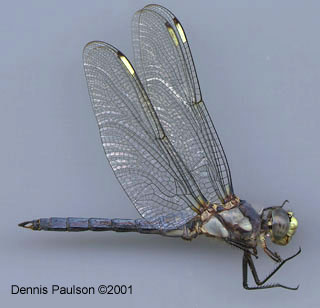
Libellula comanche
(Comanche Skimmer)
Order: Odonata
Suborder: Anisoptera
Order Description: Dragonflies
Family: Libellulidae
Family Description: Skimmer
Description:
Naiad- This is a medium-sized naiad with a length of 7/8 to 15/16 inch (21 to 24 mm). The abdomen is rounded, giving it a short, stocky appearance known as the sprawler form. Each side of abdominal segments eight and nine has a very short, rear-facing spine.
Adult- This is a large skimmer, with a length of 1 7/8 to 2 3/16 inches (47 to 55 mm). The face is creamy to yellowish white and the base color of the thorax and abdomen is brownish black. There are two patches of gray on each side of the thorax. Older males have a powdery blue coating (a condition called "pruinose") on the thorax and abdomen. Females are marked with yellow, down the center of the top of the thorax and along each side of the tops of the abdominal segments. The wings are clear but the stigma, the "spot" on the leading edge of each wing, is bi-colored dark brown and yellow.
Range:
This species is found from California east to Texas, extending north through parts of Idaho and Montana. It has been observed in only two locations in Idaho: at Hot Springs Falls in Owyhee County, and at a hot spring just west of Carey in Butte County.
Habitat:
This dragonfly can be found primarily near ponds, lakes, and hot springs. In Idaho, this species is found only at hot springs.
Adult Flight Season:
Mid-June to mid-August
Diet:
Naiad- Naiads feed on a wide variety of aquatic insects, such as mosquito larvae, other aquatic fly larvae, mayfly larvae, and freshwater shrimp. They will also eat small fish and tadpoles.
Adult- The dragonfly will eat almost any soft-bodied flying insect including mosquitoes, flies, butterflies, moths, mayflies, and flying ants or termites.
Ecology:
The naiads live in submerged vegetation and mud at the bottom of ponds, lakes, and hot springs. They do not actively pursue prey but wait for it to pass by, a strategy which affords them protection from other predators. Naiads emerge as adults at night. Adults generally fly from mid-June to mid-August. Members of this species are very aggressive towards other species of dragonflies. They hunt from perches on twigs or rocks.
Reproduction:
Males establish and actively defend territories at prime breeding locations. After males and females mate, the female flies singly, without the male attached, to lay her eggs. She does this by dipping the tip of her abdomen in the shallows of lakes and ponds while hovering just above its surface.
Conservation:
Populations are widespread, abundant, and secure.
| Global Rank: | G5 |
| State Rank: | S? |
References:
Corbet, P. S. 1999. Dragonflies: Behavior and Ecology of Odonata. Cornell University Press, Ithaca, New York, USA, 829pp.
Logan, E. R. 1967. The Odonata of Idaho. Unpublished M. S. thesis. University of Idaho, Moscow, Idaho, USA, 105 pp.
Needham, J. G. and M. J. Westfall. 1955. Dragonflies of North America. University of California Press, Berkely, California, USA, 615 pp.
Paulson, D. R. 1999. Dragonflies of Washington. Seattle Audubon Society, Seattle, Washington, USA, 32 pp.
Walker, E. M. and P. S. Corbet. 1975. The Odonata of Canada and Alaska, Vol. III. University of Toronto Press, Toronto, Ontario, Canada, 307 pp.
Written by Mark Lung and Stefan Sommer, 2001
Photos by Dennis Paulson, 2001
Design by Ean Harker, 2001.
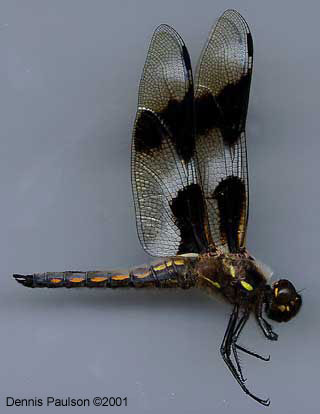
Libellula forensis
(Eight-Spotted Skimmer)
Order: Odonata
Suborder: Anisoptera
Order Description: Dragonflies
Family: Libellulidae
Family Description: Skimmer
Description:
Naiad- This is a medium-sized naiad with a length of 3/4 to 7/8 inch (18 to 21 mm). The abdomen is rounded, giving it a short, stocky appearance known as the sprawler form. There are hooks on the tops of abdominal segments four through six, and a small nub (a remnant of a hook) on segment seven. Each side of abdominal segments eight and nine has a short, rear-facing spine.
Adult- This is a large Skimmer, with a length of 1 13/16 to 2 1/16 inches (45 to 51 mm). It has a broad abdomen. The base color is brownish black. Mature males may be covered with a powdery blue coating on the thorax and abdomen (a condition called "pruinose"), although specimens from the West Coast may lack it. Females and immature males are marked with yellow or orange on the top and sides of the thorax and along each side of the upper surface of the abdomen. The "eight spots" sited in the common name refer to the total number of spots occurring on the wings. Each wing has two large, dark spots, one near the base and one about halfway out that spans the width of the wing. The stigma is also dark.
Range:
This species is found from southern British Columbia east to Montana, extending south to California east to Nebraska. It occurs throughout Idaho at low elevations.
Habitat:
This dragonfly can be found near weedy lakes and ponds at low elevations.
Adult Flight Season:
Early June to mid-August
Diet:
Naiad- Naiads feed on a wide variety of aquatic insects, such as mosquito larvae, other aquatic fly larvae, mayfly larvae, and freshwater shrimp. They will also eat small fish and tadpoles.
Adult- The dragonfly will eat almost any soft-bodied flying insect including mosquitoes, flies, butterflies, moths, mayflies, and flying ants or termites.
Ecology:
The naiads live in submerged vegetation and mud at the bottom of lakes and ponds. They do not actively pursue prey but wait for it to pass by, a strategy which affords them protection from other predators. Naiads emerge as adults at night, often after crawling a considerable distance from the water. Adults generally fly from early June to mid-August. They hunt from perches on twigs and rocks. This species is very common and conspicuous at large weedy lakes. It closely resembles Libellula. pulchella, but lacks the dark spots on the wing tips.
Reproduction:
After males and females mate, the female flies singly, without the male attached, to lay her eggs. She does this by dipping the tip of her abdomen in the shallows of lakes and ponds while hovering just above its surface.
Conservation:
Populations are widespread, abundant, and secure.
| Global Rank: | G5 |
| State Rank: | S? |
References:
Corbet, P. S. 1999. Dragonflies: Behavior and Ecology of Odonata. Cornell University Press, Ithaca, New York, USA, 829pp.
Logan, E. R. 1967. The Odonata of Idaho. Unpublished M. S. thesis. University of Idaho, Moscow, Idaho, USA, 105 pp.
Needham, J. G. and M. J. Westfall. 1955. Dragonflies of North America. University of California Press, Berkely, California, USA, 615 pp.
Paulson, D. R. 1999. Dragonflies of Washington. Seattle Audubon Society, Seattle, Washington, USA, 32 pp.
Walker, E. M. and P. S. Corbet. 1975. The Odonata of Canada and Alaska, Vol. III. University of Toronto Press, Toronto, Ontario, Canada, 307 pp.
Written by Mark Lung and Stefan Sommer, 2001
Photos by Dennis Paulson, 2001
Design by Ean Harker, 2001.
HTML by Marty Peck, 2001.
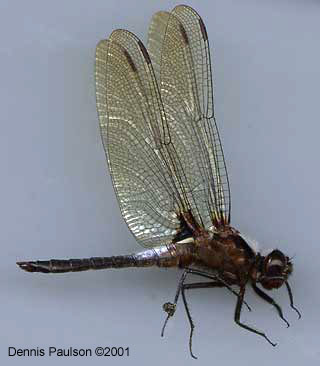
Libellula (Ladona) julia
(Chalk-Fronted Corporal)
Order: Odonata
Suborder: Anisoptera
Order Description: Dragonflies
Family: Libellulidae
Family Description: Corporal
Description:
Naiad- This is a medium-sized naiad with a length of 15/16 to 1 inch (24 to 25 mm). It is dark brown in color. The abdomen is rounded, giving it a short, stocky appearance known as the sprawler form. There are hooks on the tops of abdominal segments four through eight (the hook on segment six is noticeably longer), and a single, slender, rear-facing spine on each side of abdominal segments eight and nine.
Adult- This is a medium-sized dragonfly with a length of 1 5/8 to 1 13/16 inches (41 to 45 mm). The wings are clear except for a patch of brown at their bases (where they attach to the body). Immature males and females are uniformly dark brown on the thorax and abdomen. Both mature males and females have a powdery-appearing coating (a condition called pruinosity) on the thorax and the first part of the abdomen; in males it is bluish white while in females it is grayish. The rest of the abdomen is blackish brown, possibly fading to orangish brown along each side.
Range:
This dragonfly has a fairly narrow but lengthy range centered on the U.S.-Canadian border, extending from British Columbia and Washington east to Nova Scotia and Maine. It occurs in the northern half of Idaho at low elevations.
Habitat:
This dragonfly can be found near nutrient-poor lakes, ponds, and marshes. Unlike most Libellula, this species seems to prefer acidic waters like peat bogs.
Adult Flight Season:
Mid-June to September
Diet:
Naiad- Naiads feed on a wide variety of aquatic insects, such as mosquito larvae, other aquatic fly larvae, mayfly larvae, and freshwater shrimp. They will also eat small fish and tadpoles.
Adult- The dragonfly will eat almost any soft-bodied flying insect including mosquitoes, flies, butterflies, moths, mayflies, and flying ants or termites.
Ecology:
The naiads live on the bottom in decaying vegetation. They do not actively pursue prey but wait for it to pass by, a strategy which affords them protection from other predators. Naiads emerge as adults at night. Although records are sparse, the adults are believed to fly from mid-June to September. Hunting occurs from perches on vegetation.
Reproduction:
After males and females mate, the female flies singly, without the male attached, to lay her eggs. She does this by dipping the tip of her abdomen in the shallows of lakes, bogs, and ponds while hovering just above its surface.
Conservation:
Populations are widespread, abundant, and secure.
| Global Rank: | G5 |
| State Rank: | S? |
References:
Corbet, P. S. 1999. Dragonflies: Behavior and Ecology of Odonata. Cornell University Press, Ithaca, New York, USA, 829pp.
Logan, E. R. 1967. The Odonata of Idaho. Unpublished M. S. thesis. University of Idaho, Moscow, Idaho, USA, 105 pp.
Needham, J. G. and M. J. Westfall. 1955. Dragonflies of North America. University of California Press, Berkely, California, USA, 615 pp.
Paulson, D. R. 1999. Dragonflies of Washington. Seattle Audubon Society, Seattle, Washington, USA, 32 pp.
Walker, E. M. and P. S. Corbet. 1975. The Odonata of Canada and Alaska, Vol. III. University of Toronto Press, Toronto, Ontario, Canada, 307 pp.
Written by Mark Lung and Stefan Sommer, 2001
Photos by Dennis Paulson, 2001
Design by Ean Harker, 2001.
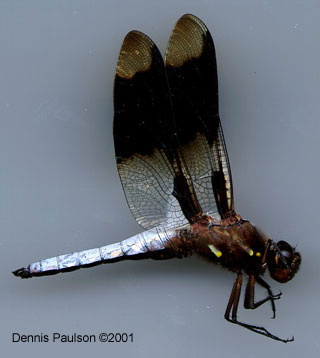
Libellula (Plathemis) lydia
(Common Whitetail)
Order: Odonata
Suborder: Anisoptera
Order Description: Dragonflies
Family: Libellulidae
Family Description: Whitetail
Description:
Naiad- This is a medium-sized naiad with a length of 7/8 to 15/16 inch (21 to 24 mm). The abdomen is rounded, giving it a short, stocky appearance known as the sprawler form. There is a single, curved, sharply pointed hook on the tops of abdominal segments two through six, the tallest of which occurs on segment five. Additionally, there is a single, rear-facing spine on each side of abdominal segments eight and nine.
Adult- This is a medium-sized dragonfly with a length of 1 11/16 to 1 7/8 inches (42 to 48 mm). The abdomen appears broad. Mature males have partially clear wings, with the central third portion of each wing marked with a large dark patch and a small dark spot at each wing base. The top and sides of the abdomen are pruinose white, with the white extending onto each hindwing along the bottom edge of the dark spot. The thorax may have several lines or spots of yellow. In females and immature males, each wing has a small dark patch at the base, at the center, and at each tip (the patch at the tip may be more yellowish). The thorax and abdomen is brown marked with yellow.
Range:
This species is found through most of the U. S. except for the desert Southwest, where it is replaced by the Desert Whitetail, Libellula subornata. In Idaho, it can be found throughout the state at lower elevations.
Habitat:
This dragonfly can be found near weedy, warm-water ponds and lakes.
Adult Flight Season:
Mid-June to late August
Diet:
Naiad- Naiads feed on a wide variety of aquatic insects, such as mosquito larvae, other aquatic fly larvae, mayfly larvae, and freshwater shrimp. They will also eat small fish and tadpoles.
Adult- The dragonfly will eat almost any soft-bodied flying insect including mosquitoes, flies, butterflies, moths, mayflies, and flying ants or termites.
Ecology:
The naiads live in submerged aquatic grasses and sedges. They do not actively pursue prey but wait for it to pass by, a strategy which affords them protection from other predators. Naiads emerge as adults at night. Adults generally fly from mid-June through most of August. This species is most abundant in late spring and early summer. The adults hunt from perches on vegetation. The white abdomen and wings patterned with black make it a very striking dragonfly.
Reproduction:
Males establish and defend territories at choice breeding locations. After males and females mate, the female flies singly, without the male attached, to lay her eggs. She doe this by dipping the tip of her abdomen along the weedy margins of lakes and ponds while hovering just above the water's surface.
Conservation:
Populations are widespread, abundant, and secure.
| Global Rank: | G5 |
| State Rank: | S? |
References:
Corbet, P. S. 1999. Dragonflies: Behavior and Ecology of Odonata. Cornell University Press, Ithaca, New York, USA, 829pp.
Logan, E. R. 1967. The Odonata of Idaho. Unpublished M. S. thesis. University of Idaho, Moscow, Idaho, USA, 105 pp.
Needham, J. G. and M. J. Westfall. 1955. Dragonflies of North America. University of California Press, Berkely, California, USA, 615 pp.
Paulson, D. R. 1999. Dragonflies of Washington. Seattle Audubon Society, Seattle, Washington, USA, 32 pp.
Walker, E. M. and P. S. Corbet. 1975. The Odonata of Canada and Alaska, Vol. III. University of Toronto Press, Toronto, Ontario, Canada, 307 pp.
Written by Mark Lung and Stefan Sommer, 2001
Photos by Dennis Paulson, 2001
Design by Ean Harker, 2001.

Libellula nodisticta
(Hoary Skimmer)
Order: Odonata
Suborder: Anisoptera
Order Description: Dragonflies
Family: Libellulidae
Family Description: Skimmer
Description:
Naiad- The naiad is currently undescribed by biologists.
Adult- This is a medium-sized, stout-bodied dragonfly, with a length of 1 13/16 to 2 1/16 inches (46 to 52 mm). The wings are mostly clear, with each marked at the base with a dark patch and at the center along the leading edge with a small dark spot. Mature males are pruinose blue on the thorax and abdomen. Each side of the thorax may be marked with several yellow spots, and the sides of the abdomen may be marked with brownish orange dashes. Females and immature males are grayish brown and marked with yellow, both on the sides of the thorax and on each abdominal segment.
Range:
This species is found from Yellowstone National Park (northwestern Wyoming), south and west to California, extending south into South America as far as Venezuela. In Idaho, it can be found in the southwest corner, though it may occur in other areas of the state near hot springs.
Habitat:
This dragonfly can be found in warm climates near lakes, ponds, slow streams, marshes, and at hot springs in cooler climates. All of the species from Idaho and from Yellowstone National Park were collected near hot springs.
Adult Flight Season:
Mid-May to mid-August
Diet:
Naiad- Naiads feed on a wide variety of aquatic insects, such as mosquito larvae, other aquatic fly larvae, mayfly larvae, and freshwater shrimp. They will also eat small fish and tadpoles.
Adult- The dragonfly will eat almost any soft-bodied flying insect including mosquitoes, flies, butterflies, moths, mayflies, and flying ants or termites.
Ecology:
The naiads live in the debris on the bottom of lakes, ponds, slow streams, marshes, and hot springs. They do not actively pursue prey but wait for it to pass by, a strategy which affords them protection from other predators. Naiads emerge as adults at night. Adults generally fly from mid-May to mid-August. Hunting occurs from perches on twigs or rocks.
Reproduction:
Males establish and defend territories at choice breeding locations. After males and females mate, the female flies singly, without the male attached, to lay her eggs. She does this by dipping the tip of her abdomen in the shallows of lakes, ponds, slow streams, and marshes while hovering just above the water's surface.
Conservation:
Populations are widespread, abundant, and secure.
| Global Rank: | G5 |
| State Rank: | S? |
References:
Corbet, P. S. 1999. Dragonflies: Behavior and Ecology of Odonata. Cornell University Press, Ithaca, New York, USA, 829pp.
Logan, E. R. 1967. The Odonata of Idaho. Unpublished M. S. thesis. University of Idaho, Moscow, Idaho, USA, 105 pp.
Needham, J. G. and M. J. Westfall. 1955. Dragonflies of North America. University of California Press, Berkely, California, USA, 615 pp.
Paulson, D. R. 1999. Dragonflies of Washington. Seattle Audubon Society, Seattle, Washington, USA, 32 pp.
Walker, E. M. and P. S. Corbet. 1975. The Odonata of Canada and Alaska, Vol. III. University of Toronto Press, Toronto, Ontario, Canada, 307 pp.
Written by Mark Lung and Stefan Sommer, 2001
Photos by Dennis Paulson, 2001
Design by Ean Harker, 2001.
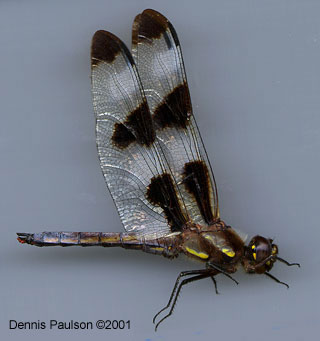
Libellula pulchella
(Twelve-Spotted Skimmer)
Order: Odonata
Suborder: Anisoptera
Order Description: Dragonflies
Family: Libellulidae
Family Description: Skimmer
Description:
Naiad- This is a medium to large naiad with a length of 15/16 to 1 1/16 inches (24 to 27 mm). It is dark orange-brown in color, and the abdomen is rounded, giving it a short, stocky appearance known as the sprawler form. There is a small hook on the top of abdominal segments four through seven, and there is a thin, slightly curved, rear-facing spine on each side of abdominal segment eight and nine.
Adult- This is a fairly large dragonfly with a length of 2 to 2 ¼ inches (50 to 57 mm). Each wing is marked with three dark spots: one near the base where it attaches to the body, one in the center than nearly spans the width of the wing, and one at the tip. Females and immature males are brownish black. The side of the thorax is marked with two diagonal yellow stripes, and each side of the abdomen is lined with yellow. Mature males are brownish black, faintly marked with yellow, and become pruinose blue on the top of the abdomen. They may also develop a whitish patch on each wing to the outside of the spot next to the body.
Range:
This species is found from British Columbia east to Nova Scotia, extending south through most of the U.S., from California east to Florida. It is absent from very dry areas. In Idaho, it occurs throughout most of the state except for the driest portions of the southwest.
Habitat:
This dragonfly occurs near lakes, ponds and marshes, particularly those with exposed shorelines.
Adult Flight Season:
Early June to late August
Diet:
Naiad- Naiads feed on a wide variety of aquatic insects, such as mosquito larvae, other aquatic fly larvae, mayfly larvae, and freshwater shrimp. They will also eat small fish and tadpoles.
Adult- The dragonfly will eat almost any soft-bodied flying insect including mosquitoes, flies, butterflies, moths, mayflies, and flying ants or termites.
Ecology:
Naiads live in the debris on the bottom of lakes, ponds, and marshes. They do not actively pursue prey but wait for it to pass by, a strategy which affords them protection from other predators. Naiads emerge as adults at night. Adults generally fly from early June through August. Hunting occurs from perches on twigs or rocks.
Reproduction:
Males establish and defend territories, and are very aggressive towards members of their own species as well as other dragonflies. After males and females mate, the female flies singly, without the male attached, to lay her eggs. She does this by dipping the tip of her abdomen in the shallows of the body of water while hovering just above the water's surface.
Conservation:
Populations are widespread, abundant, and secure.
| Global Rank: | G5 |
| State Rank: | S? |
References:
Corbet, P. S. 1999. Dragonflies: Behavior and Ecology of Odonata. Cornell University Press, Ithaca, New York, USA, 829pp.
Logan, E. R. 1967. The Odonata of Idaho. Unpublished M. S. thesis. University of Idaho, Moscow, Idaho, USA, 105 pp.
Needham, J. G. and M. J. Westfall. 1955. Dragonflies of North America. University of California Press, Berkely, California, USA, 615 pp.
Paulson, D. R. 1999. Dragonflies of Washington. Seattle Audubon Society, Seattle, Washington, USA, 32 pp.
Walker, E. M. and P. S. Corbet. 1975. The Odonata of Canada and Alaska, Vol. III. University of Toronto Press, Toronto, Ontario, Canada, 307 pp.
Written by Mark Lung and Stefan Sommer, 2001
Photos by Dennis Paulson, 2001
Design by Ean Harker, 2001.
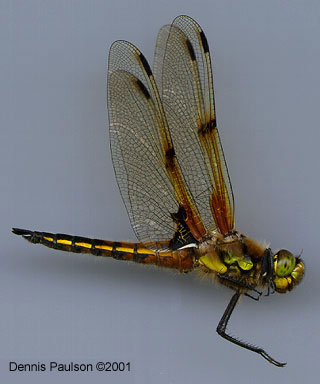
Libellula quadrimaculata
(Four-Spotted Skimmer)
Order: Odonata
Suborder: Anisoptera
Order Description: Dragonflies
Family: Libellulidae
Family Description: Skimmer
Description:
Naiad- This is a medium to large naiad, with a length of 7/8 to 1 1/16 inches (22 to 26 mm). It is orange-brown in color, and the abdomen is rounded, giving it a short, stocky appearance known as the sprawler form. There is a small hook on the top of abdominal segments three through eight, while the hooks on segments five through seven are noticeably larger. There is a small, rear-facing spine on each side of abdominal segment eight and nine.
Adult- This is a medium-sized dragonfly with a length of 1 5/8 to 1 13/16 inches (40 to 45 mm). Each wing is clear except for along the leading edge, which is clouded with a transparent yellowish brown. The center of each wing is marked with a small dark spot, also on the leading edge. Additionally, each hindwing is marked with a dark patch near the base. Males and females look alike, generally dark brown. The face and each side of the thorax are marked with patches of greenish yellow, and the sides of the abdomen lined with yellowish orange dashes.
Range:
This species is found around the world from Alaska east to Labrador and south to northern California and Texas, and from northern Europe east to Siberia. In Idaho, it is found near lakes, ponds, and marshes throughout the state.
Habitat:
This dragonfly can be found near lakes, ponds, bogs, and marshes.
Adult Flight Season:
Early April to mid-August
Diet:
Naiad- Naiads feed on a variety of aquatic insects as well as on small fish and tadpoles.
Adult- The dragonfly feeds on small flying insects.
Ecology:
The naiad does particularly well in acidic bogs, and lives in the debris on the bottom of lakes, ponds, bogs, and marshes. They do not actively pursue prey but wait for it to pass by, a strategy which affords them protection from other predators. Naiads emerge as adults at night. Adults generally fly from early April to mid-August. Hunting occurs from perches on twigs or rocks. This is the only Libellula species in our area in which the males do not become pruinose. Although it does not regularly migrate in North America, this species has been known to migrate in Europe, generally in 10 to 15-year cycles. The direction of the migration varies, and the migrations are thought to be triggered by a trematode parasite (it is known that several types of parasites can cause unusual behaviors in their hosts that promote the dispersal of the parasite). This species has also been known to form large swarms in Europe, often covering 100 square miles (roughly 300 square km).
Reproduction:
After males and females mate, the female flies singly, without the male attached, to lay her eggs. She does this by dipping the tip of her abdomen in the water while hovering just above its surface.
Conservation:
Populations are widespread, abundant, and secure.
| Global Rank: | G5 |
| State Rank: | S? |
References:
Corbet, P. S. 1999. Dragonflies: Behavior and Ecology of Odonata. Cornell University Press, Ithaca, New York, USA, 829pp.
Logan, E. R. 1967. The Odonata of Idaho. Unpublished M. S. thesis. University of Idaho, Moscow, Idaho, USA, 105 pp.
Needham, J. G. and M. J. Westfall. 1955. Dragonflies of North America. University of California Press, Berkely, California, USA, 615 pp.
Paulson, D. R. 1999. Dragonflies of Washington. Seattle Audubon Society, Seattle, Washington, USA, 32 pp.
Walker, E. M. and P. S. Corbet. 1975. The Odonata of Canada and Alaska, Vol. III. University of Toronto Press, Toronto, Ontario, Canada, 307 pp.
Written by Mark Lung and Stefan Sommer, 2001
Photos by Dennis Paulson, 2001
Design by Ean Harker, 2001.
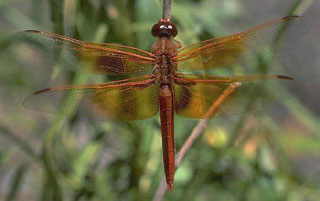
Libellula saturata
(Flame Skimmer)
Order: Odonata
Suborder: Anisoptera
Order Description: Dragonflies
Family: Libellulidae
Family Description: Skimmer
Description:
Naiad- This is a fairly large naiad, with a maximum length of 1 1/8 inches (28 mm). The abdomen is rounded, giving it a short, stocky appearance known as the sprawler form. It is covered with hairs, but has no hooks or spines as do many other naiads.
Adult- This is a large dragonfly with a length of 2 1/16 to 2 7/16 inches (52 to 61 mm). It is entirely red, including the legs and wing veins.
Range:
This species is found from southwestern Idaho west and south to southern California, throughout the southwestern U.S., and east to Wyoming. In Idaho, it is found in the southwestern part of the state.
Habitat:
This dragonfly occurs near warm water ponds, warm, slow streams, and hot springs. In the northern part of its range, it almost always occurs near hot springs. Specifically in Idaho, it occurs in low elevation desert in the southwest, and at hot springs in the central and southeast portions of the state.
Adult Flight Season:
Mid-May to early September
Diet:
Naiad- Naiads feed on a wide variety of aquatic insects, such as mosquito larvae, other aquatic fly larvae, mayfly larvae, and freshwater shrimp. They will also eat small fish and tadpoles.
Adult- The dragonfly will eat almost any soft-bodied flying insect including mosquitoes, flies, butterflies, moths, mayflies, and flying ants or termites.
Ecology:
The naiads live in mud on the bottom of warm ponds, streams, and springs. They do not actively pursue prey but wait for it to pass by, a strategy which affords them protection from other predators. Naiads emerge as adults at night. Adults generally fly from mid-May to early September. Hunting occurs from perches on twigs and rocks. This dragonfly is very common in the southwestern U.S., and around the Firehole River in Yellowstone National Park because of the hot springs.
Reproduction:
Males establish and defend territories at prime breeding locations. After males and females mate, the female flies singly, without the male attached, to lay her eggs. She does this by dipping the tip of her abdomen in the shallows of springs and ponds while hovering just above the water's surface.
Conservation:
Populations are widespread, abundant, and secure.
| Global Rank: | G5 |
| State Rank: | S? |
References:
Corbet, P. S. 1999. Dragonflies: Behavior and Ecology of Odonata. Cornell University Press, Ithaca, New York, USA, 829pp.
Logan, E. R. 1967. The Odonata of Idaho. Unpublished M. S. thesis. University of Idaho, Moscow, Idaho, USA, 105 pp.
Needham, J. G. and M. J. Westfall. 1955. Dragonflies of North America. University of California Press, Berkely, California, USA, 615 pp.
Paulson, D. R. 1999. Dragonflies of Washington. Seattle Audubon Society, Seattle, Washington, USA, 32 pp.
Walker, E. M. and P. S. Corbet. 1975. The Odonata of Canada and Alaska, Vol. III. University of Toronto Press, Toronto, Ontario, Canada, 307 pp.
Written by Mark Lung and Stefan Sommer, 2001
Photos by Forrest Mitchell, © 1999.
Design by Ean Harker, 2001.
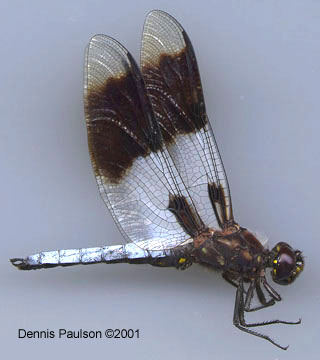
Libellula (Plathemis) subornata
(Desert Whitetail)
Order: Odonata
Suborder: Anisoptera
Order Description: Dragonflies
Family: Libellulidae
Family Description: Whitetail
Description:
Naiad- This is a medium-sized naiad with a length of 7/8 to 1 inch (21 to 24 mm). The abdomen is rounded, giving it a short, stocky appearance known as the sprawler form. There is a single, blunt hook on the tops of abdominal segments two through six, the tallest of which occurs on segment four. Additionally, there is a single, rear-facing spine on each side of abdominal segments eight and nine.
Adult- This is a medium-sized dragonfly, with a length of 1 5/8 to 2 inches (40 to 51 mm). It has a broad abdomen. Mature males, females, and immature males look differently:
- Mature male: Each wing is marked with a small, dark, elongated spot, possibly with a clear center, near the base, and with a large, dark band spanning the width of the wing, from the center to the outer fourth of the wing near the tip. The band is lighter in color down its center compared to its edges. The area between the base of the wing and this band may be clouded with white. The thorax and underside of the abdomen are brownish black, while the top of the abdomen is pruinose whitish blue.
- Female: Each wing is marked with a small, dark, elongated spot with a clear center, near the base, and with a pair of thick, wavy, brownish bands spanning the width of the wing. The wingtip may be clouded with yellow. The thorax and abdomen are grayish brown. Each side of the thorax is marked with a pair of yellowish stripes, and the top of the abdomen is marked with two parallel lines of thick yellow dashes.
- Immature male: The wings of theses males appear much like those of the mature males, while their bodies are marked like the females.
Range:
From southeastern Oregon east to southern Wyoming and south to Mexico. In Idaho, this dragonfly occurs in the southwestern portion of the state.
Habitat:
This dragonfly can be found near ponds and seepage pools in desert areas.
Adult Flight Season:
Early June to early September
Diet:
Naiad- Naiads feed on a wide variety of aquatic insects, such as mosquito larvae, other aquatic fly larvae, mayfly larvae, and freshwater shrimp. They will also eat small fish and tadpoles.
Adult- The dragonfly will eat almost any soft-bodied flying insect including mosquitoes, flies, butterflies, moths, mayflies, and flying ants or termites.
Ecology:
The naiads live in submerged aquatic grasses and sedges. They do not actively pursue prey but wait for it to pass by, a strategy which affords them protection from other predators. Naiads emerge as adults at night. Adults generally fly from early July to early September. Hunting occurs from perches on twigs and rocks.
Reproduction:
Males establish and defend territories at choice breeding locations. After males and females mate, the female flies singly, without the male attached, to lay her eggs. She does this by dipping the tip of her abdomen in the shallows of desert seeps and ponds while hovering above the water's surface.
Conservation:
Populations are widespread, abundant, and secure.
| Global Rank: | G5 |
| State Rank: | S? |
References:
Corbet, P. S. 1999. Dragonflies: Behavior and Ecology of Odonata. Cornell University Press, Ithaca, New York, USA, 829pp.
Logan, E. R. 1967. The Odonata of Idaho. Unpublished M. S. thesis. University of Idaho, Moscow, Idaho, USA, 105 pp.
Needham, J. G. and M. J. Westfall. 1955. Dragonflies of North America. University of California Press, Berkely, California, USA, 615 pp.
Paulson, D. R. 1999. Dragonflies of Washington. Seattle Audubon Society, Seattle, Washington, USA, 32 pp.
Walker, E. M. and P. S. Corbet. 1975. The Odonata of Canada and Alaska, Vol. III. University of Toronto Press, Toronto, Ontario, Canada, 307 pp.
Written by Mark Lung and Stefan Sommer, 2001
Photos by Dennis Paulson, 2001
Design by Ean Harker, 2001.
HTML by Marty Peck, 2001.
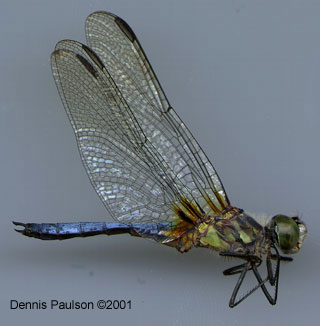
Pachydiplax longipennis
(Blue Dasher)
Order: Odonata
Suborder: Anisoptera
Order Description: Dragonflies
Family: Libellulidae
Family Description: Dasher
Description:
Naiad- This is a relatively small naiad with a length of 3/4 to 7/8 inch (18 to 21 mm). It is brownish above and bright green underneath. There is a single, rear-facing spine on each side of abdominal segments eight and nine, with those on segment nine being noticeably longer. There are no hooks on the back, as some naiads have.
Adult- This dragonfly is small to medium in size, with a length of 1 3/8 to 1 13/16 inches (35 to 45 mm), and has a fairly broad abdomen. Females and immature males are greenish on the face and thorax, with a brownish black abdomen marked along the top with two parallel lines of pale yellow to yellowish green dashes. Mature males are greenish on the face and thorax but the abdomen is pruinose blue. The wings are mostly clear but may be clouded with brownish yellow at the bases, especially on the hindwings.
Range:
This species is found from southern British Columbia east to Ontario, extending south through the U.S. from southern California east to Florida. It also occurs in the Bahamas. In Idaho, it can be found throughout the state at lower elevations, usually below 3000 feet (914 meters).
Habitat:
This dragonfly can be found near lakes, ponds and slow streams at low elevations.
Adult Flight Season:
Late June to October
Diet:
Naiad- Naiads feed on a wide variety of aquatic insects, such as mosquito larvae, other aquatic fly larvae, mayfly larvae, and freshwater shrimp. They will also eat small fish and tadpoles.
Adult- The dragonfly will eat almost any soft-bodied flying insect including mosquitoes, flies, butterflies, moths, mayflies, and flying ants or termites.
Ecology:
The naiads live in submerged vegetation. They do not actively pursue prey but wait for it to pass by, a strategy which affords them protection from other predators. The naiads of this species can tolerate water with low oxygen content. This is used by biologists in Florida who interpret their presence as a possible indicator of low water quality. Naiads emerge as adults at night. Adults generally fly from late June to October. Hunting occurs from perches on twigs and rocks. This is the only member of this genus.
Reproduction:
After males and females mate, the female flies singly, without the male attached, to lay her eggs by dipping the tip of her abdomen in the water while hovering above its surface.
Conservation:
Populations are widespread, abundant, and secure.
| Global Rank: | G5 |
| State Rank: | S? |
References:
Corbet, P. S. 1999. Dragonflies: Behavior and Ecology of Odonata. Cornell University Press, Ithaca, New York, USA, 829pp.
Logan, E. R. 1967. The Odonata of Idaho. Unpublished M. S. thesis. University of Idaho, Moscow, Idaho, USA, 105 pp.
Needham, J. G. and M. J. Westfall. 1955. Dragonflies of North America. University of California Press, Berkely, California, USA, 615 pp.
Paulson, D. R. 1999. Dragonflies of Washington. Seattle Audubon Society, Seattle, Washington, USA, 32 pp.
Walker, E. M. and P. S. Corbet. 1975. The Odonata of Canada and Alaska, Vol. III. University of Toronto Press, Toronto, Ontario, Canada, 307 pp.
Written by Mark Lung and Stefan Sommer, 2001
Photos by Dennis Paulson, 2001
Design by Ean Harker, 2001.
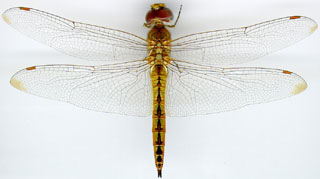
Pantala flavescens
(Wandering Glider)
Order: Odonata
Suborder: Anisoptera
Order Description: Dragonflies
Family: Libellulidae
Family Description: Glider
Description:
Naiad- This is a medium to large naiad with a length of 15/16 to 1 1/16 inches (24 to 26 mm). It is pale green with light brown markings. There is a large, rear-facing spine on each side of the last abdominal segments, but there are no hooks on the back, as some naiads have.
Adult- This is a medium to large dragonfly with a length of 1 3/4 to 2 inches (44 to 50 mm), with a fairly wide abdomen. The thorax and abdomen are orange to brown, and there are no markings. Each hindwing is almost triangular in shape, with the broadest part at the base where it attaches to the body.
Range:
This is the world's most widely distributed dragonfly. It occurs worldwide between 400 N and 400 S latitude, and is the only dragonfly with such a large distribution. It is most common in tropical and subtropical regions with highly seasonal rainfall. In Idaho, it occurs at seasonal ponds on the Snake River Plain.
Habitat:
This dragonfly can be found near seasonal ponds.
Adult Flight Season:
It has only been observed to fly in August in Idaho, but it most likely flies over a longer season.
Diet:
Naiad- The naiads feed on a wide variety of aquatic insects, such as mosquito larvae, other aquatic fly larvae, mayfly larvae, and freshwater shrimp. They will also eat small fish and tadpoles.
Adult- The dragonfly eats small flying insects, especially mosquitoes which also use seasonal ponds. They also gather in swarms to feed on flying ants and termites.
Ecology:
The naiad swims actively about in pursuit of prey, an unusual trait for naiads of this family. Because they make little effort to conceal themselves when foraging, the naiads are very vulnerable to predators such as fish. Luckily, the seasonal ponds in which they live rarely contain many fish and the naiads do well. They have voracious appetites and this results in quick maturation (40 to 60 days, depending on water temperature and availability of prey). They emerge as adults synchronously, and the adults migrate using thermals in the atmosphere. In Idaho, the naiads have been observed to emerge in early August, indicating that the migratory adults arrived to breed in June. The adults migrate around the world in search of seasonal ponds to reproduce, traveling hundreds or even thousands of miles. The abdomen of the adult can store large amounts of fat that is used as energy for long-distance travel. Adults have even been seen perching on ships far out at sea. The adult Wandering Glider often forages in large swarms, and one of the most remarkable reports of such a swarm was of a cloud of Wandering Gliders that covered 13 square miles (34 square kilometers)! This is one of the few dragonflies that will remain on the wing during heavy rain, and in India, its arrival is said to herald the coming of the monsoons.
Reproduction:
After males and females mate, the female flies with the male attached (in tandem), to lay her eggs, generally in seasonal ponds. However, this dragonfly often mistakes the finishes on shiny new cars for water and lays eggs on them as well, a most unfortunate choice for the hatching naiads.
Conservation:
Populations are widespread, abundant, and secure.
| Global Rank: | G5 |
| State Rank: | S? |
References:
Corbet, P. S. 1999. Dragonflies: Behavior and Ecology of Odonata. Cornell University Press, Ithaca, New York, USA, 829pp.
Logan, E. R. 1967. The Odonata of Idaho. Unpublished M. S. thesis. University of Idaho, Moscow, Idaho, USA, 105 pp.
Needham, J. G. and M. J. Westfall. 1955. Dragonflies of North America. University of California Press, Berkely, California, USA, 615 pp.
Paulson, D. R. 1999. Dragonflies of Washington. Seattle Audubon Society, Seattle, Washington, USA, 32 pp.
Walker, E. M. and P. S. Corbet. 1975. The Odonata of Canada and Alaska, Vol. III. University of Toronto Press, Toronto, Ontario, Canada, 307 pp.
Written by Mark Lung and Stefan Sommer, 2001
Photos by Dennis Paulson, 2001
Design by Ean Harker, 2001.
HTML by Marty Peck, 2001.
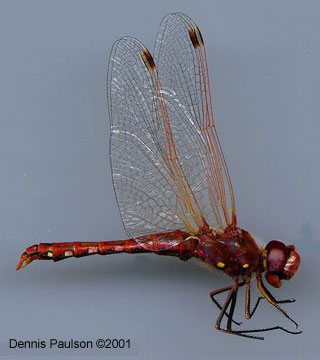
Sympetrum (Tarnetrum) corruptum
(Variegated Meadowhawk)
Order: Odonata
Suborder: Anisoptera
Order Description: Dragonflies
Family: Libellulidae
Family Description: Meadowhawk
Description:
Naiad- This is a small naiad with a maximum length of 3/4 inch (19 mm). It is mottled green and brown in color, and the abdomen is marked along the top with a pair of stripes. While the naiads of many dragonfly species are equipped with hooks and/or spines on the abdominal segments, the naiads of this species may have only one tiny, rear-facing spine on each side of abdominal segment eight or else no hooks or spines at all.
Adult- This is a small to medium-sized dragonfly (but large for this genus) with a length of 1 5/8 to 1 11/16 inches (39 to 42 mm). The abdomen is quite slender. Mature males have a base color of dark brownish black. Each side of the thorax may be marked with a pair of yellow spots. The abdomen is marked with an eye-catching pattern of red, pink, and golden brown. The leading edges of the wings have pinkish wing veins. Mature females are marked similarly but with less red. Immature males and females are much paler in color and are mottled with pale green, pale yellow, golden brown, and orange. The leading edges of the wings have brownish or "regular" (non-colored) veins.
Range:
This species is found from British Columbia east to Ontario, extending south through much of the U.S. to southern California east to Florida. It migrates as far south as Honduras in Central America, and also occurs in eastern Asia. It occurs throughout Idaho except at the highest elevations.
Habitat:
This dragonfly can be found near ponds and lakes.
Adult Flight Season:
Early May to mid-September
Diet:
Naiad- Naiads feed on a wide variety of aquatic insects, such as mosquito larvae, other aquatic fly larvae, mayfly larvae, and freshwater shrimp. They will also eat very small fish and tadpoles.
Adult- The dragonfly will eat almost any soft-bodied flying insect including mosquitoes, flies, small moths, mayflies, and flying ants or termites.
Ecology:
The naiads are found in debris on the bottom of lakes or ponds. They do not actively pursue prey but wait for it to pass by, a strategy which affords them protection from other predators. Naiads emerge as adults at night. Adults generally fly from early May to mid-September. Hunting occurs from perches on rocks or bare branches. The Latin name for this genus, Sympetrum, means "with rock" and refers to their habit of basking on rocks to absorb heat early in the day. This species is often seen in migratory swarms traveling south in the fall, along with the Common Green Darner (Anax junius) and the Black Saddlebags (Tramea lacerata). Those traveling south in the fall are usually immature, while those that appear in Idaho in the spring are usually mature. It was previously believed that the mature Variegated Meadowhawks appearing in the northern states in the spring had over-wintered there, but it is now believed that they emerged further south and migrated north. It is not known if there are resident, non-migratory populations in Idaho. This species is not seen in October in Idaho, as are many other members of this genus. Those observed in August and September are almost always immature, which suggests that they leave the area soon after emerging.
Reproduction:
The female flies with the male still attached after mating (a position called "in tandem") and lays her eggs in lakes and ponds by dipping the tip her abdomen on the surface of the water.
Conservation:
Populations are widespread, abundant, and secure.
| Global Rank: | G5 |
| State Rank: | S? |
References:
Corbet, P. S. 1999. Dragonflies: Behavior and Ecology of Odonata. Cornell University Press, Ithaca, New York, USA, 829pp.
Logan, E. R. 1967. The Odonata of Idaho. Unpublished M. S. thesis. University of Idaho, Moscow, Idaho, USA, 105 pp.
Needham, J. G. and M. J. Westfall. 1955. Dragonflies of North America. University of California Press, Berkely, California, USA, 615 pp.
Paulson, D. R. 1999. Dragonflies of Washington. Seattle Audubon Society, Seattle, Washington, USA, 32 pp.
Walker, E. M. and P. S. Corbet. 1975. The Odonata of Canada and Alaska, Vol. III. University of Toronto Press, Toronto, Ontario, Canada, 307 pp.
Written by Mark Lung and Stefan Sommer, 2001
Photos by Dennis Paulson, 2001
Design by Ean Harker, 2001.
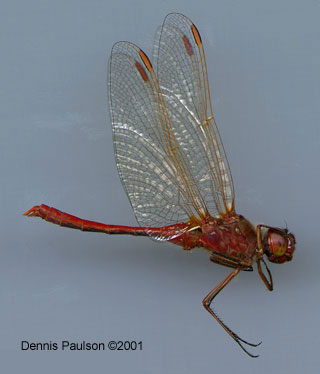
Sympetrum costiferum
(Saffron-Winged Meadowhawk)
Order: Odonata
Suborder: Anisoptera
Order Description: Dragonflies
Family: Libellulidae
Family Description: Meadowhawk
Description:
Naiad- This is a small naiad with a maximum length of 3/4 inch (18 mm). It is mottled green and brown in color. There are slender, slightly curved hooks along the top of the abdomen, and the last two abdominal segments have a single, rear-facing spine on each side.
Adult- This is a small dragonfly with a length of 1 1/4 to 1 1/2 inches (31 to 37 mm). The abdomen is quite slender. Mature males are brownish red. The wings are translucent golden yellow. Mature females are golden yellow. Immature males and females are a combination of golden yellow and light brown, and only the leading edges of the wings are yellow.
Range:
This species is found from southern British Columbia east to the Atlantic, extending south in the U.S. from California east to New York. In Idaho, it is found throughout the state at lower elevations.
Habitat:
This dragonfly can be found near bogs, marshy ponds and lakes.
Adult Flight Season:
Early June to late August
Diet:
Naiad- Naiads feed on a wide variety of aquatic insects, such as mosquito larvae, other aquatic fly larvae, mayfly larvae, and freshwater shrimp. They will also eat very small fish and tadpoles.
Adult- The dragonfly will eat almost any soft-bodied flying insect including mosquitoes, flies, small moths, mayflies, and flying ants or termites.
Ecology:
The naiads live in submerged vegetation. They do not actively pursue prey but wait for it to pass by, a strategy which affords them protection from other predators. Naiads emerge as adults at night. Adults generally fly from early June to the end of August, and possibly into October. The adults of this species hunt flying insects from perches on rocks or bare branches. The Latin name for this genus, Sympetrum, means "with rock" and refers to their habit of basking on rocks to absorb heat early in the day. This species has a high tolerance for salty or alkaline waters, thus are very abundant in southeastern Idaho where these conditions are common.
Reproduction:
The female flies with the male still attached after mating (a position called "in tandem") and lays her eggs in lakes and ponds by dipping the tip her abdomen on the surface of the water.
Conservation:
Populations are widespread, abundant, and secure.
| Global Rank: | G5 |
| State Rank: | S? |
References:
Corbet, P. S. 1999. Dragonflies: Behavior and Ecology of Odonata. Cornell University Press, Ithaca, New York, USA, 829pp.
Logan, E. R. 1967. The Odonata of Idaho. Unpublished M. S. thesis. University of Idaho, Moscow, Idaho, USA, 105 pp.
Needham, J. G. and M. J. Westfall. 1955. Dragonflies of North America. University of California Press, Berkely, California, USA, 615 pp.
Paulson, D. R. 1999. Dragonflies of Washington. Seattle Audubon Society, Seattle, Washington, USA, 32 pp.
Walker, E. M. and P. S. Corbet. 1975. The Odonata of Canada and Alaska, Vol. III. University of Toronto Press, Toronto, Ontario, Canada, 307 pp.
Written by Mark Lung and Stefan Sommer, 2001
Photos by Dennis Paulson, 2001
Design by Ean Harker, 2001.
HTML by Marty Peck, 2001.
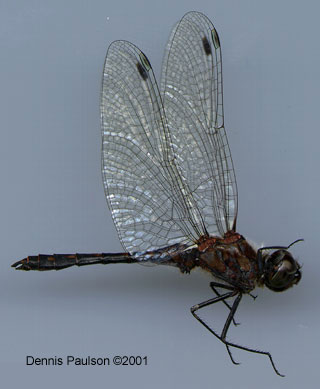
Sympetrum danae
(Black Meadowhawk)
Order: Odonata
Suborder: Anisoptera
Order Description: Dragonflies
Family: Libellulidae
Family Description: Meadowhawk
Description:
Naiad- This is a small naiad with a length of 9/16 to 5/8 inch (14 to 15.5 mm). It is mottled green and brown in color. The abdomen has several slender, slightly curved hooks along the top, and the last two abdominal segments have a single, rear-facing spine on each side. The naiads of this species and those of the Cherry-faced Meadowhawk (Sympetrum internum) are extremely difficult to tell apart.
Adult- This is a small dragonfly with a length of 1 to 1 ¼ inches (26 to 31 mm). It has no red coloration, unlike other Sympetrum species. Mature males are all black and have clear wings. Immature males are black and marked with yellow on each side of the thorax and along the top of the abdomen. Females are brown with golden brown and yellow markings, and their wings may be clouded with golden brown where they attach to the body.
Range:
The distribution of this dragonfly is circumboreal, which means it occurs throughout the Northern Hemisphere. In North America, it ranges from Alaska east to Hudson Bay, extending south into the U.S. to northern California east to Kentucky and Maine. It is also found across Siberia into northern Europe. In Idaho, it is found throughout the state.
Habitat:
This dragonfly occurs primarily near bogs, but also near marshy ponds and lakes.
Adult Flight Season:
Early June to Late August
Diet:
Naiad- Naiads feed on a wide variety of aquatic insects, such as mosquito larvae, other aquatic fly larvae, mayfly larvae, and freshwater shrimp. They will also eat very small fish and tadpoles.
Adult- The dragonfly will eat almost any soft-bodied flying insect including mosquitoes, flies, small moths, mayflies, and flying ants or termites.
Ecology:
The naiads live in submerged vegetation. They do not actively pursue prey but wait for it to pass by, a strategy which affords them protection from other predators. Naiads emerge as adults at night. Adults generally fly from early June through August. They hunt flying insects from perches on rocks or bare branches. The Latin name for this genus, Sympetrum, means "with rock" and refers to their habit of basking on rocks to absorb heat early in the day. Throughout its range, this species is associated with acidic waters, especially peat bogs. However, it is quite common in southeastern Idaho, where most groundwater is alkaline.
Reproduction:
The female flies with the male still attached after mating (a position called "in tandem") and lays her eggs in lakes and ponds by dipping the tip her abdomen on the surface of the water.
Conservation:
Populations are widespread, abundant, and secure.
| Global Rank: | G5 |
| State Rank: | S? |
References:
Corbet, P. S. 1999. Dragonflies: Behavior and Ecology of Odonata. Cornell University Press, Ithaca, New York, USA, 829pp.
Logan, E. R. 1967. The Odonata of Idaho. Unpublished M. S. thesis. University of Idaho, Moscow, Idaho, USA, 105 pp.
Needham, J. G. and M. J. Westfall. 1955. Dragonflies of North America. University of California Press, Berkely, California, USA, 615 pp.
Paulson, D. R. 1999. Dragonflies of Washington. Seattle Audubon Society, Seattle, Washington, USA, 32 pp.
Walker, E. M. and P. S. Corbet. 1975. The Odonata of Canada and Alaska, Vol. III. University of Toronto Press, Toronto, Ontario, Canada, 307 pp.
Written by Mark Lung and Stefan Sommer, 2001
Photos by Dennis Paulson, 2001
Design by Ean Harker, 2001.
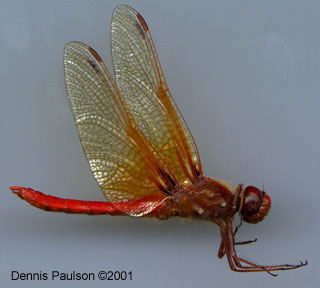
Sympetrum (Tarnetrum) illotum
(Cardinal Meadowhawk)
Order: Odonata
Suborder: Anisoptera
Order Description: Dragonflies
Family: Libellulidae
Family Description: Meadowhawk
Description:
Naiad- This is a small naiad with a length of 3/4 inch (18 mm). It is mottled green and brown in color, and the abdomen is marked along the top with a pair of stripes. While the naiads of many dragonfly species are equipped with hooks and/or spines on the abdominal segments, the naiads of this species may have only one tiny, rear-facing spine on each side of abdominal segment eight or else no hooks or spines at all.
Adult- This is a small dragonfly (but large for a Sympetrum) with a length of 1 1/2 to 1 5/8 inches (38 to 40 mm). The abdomen is broad and has the same width along its length, in contrast to the other members of its genus. Mature males are bright red on the face, thorax, and abdomen. Each side of the thorax may be marked with a pair of yellow spots. The wings have some red veins along the leading edge and are clouded with brown near the body. Females are brownish red and the wings may appear translucent golden brown. Immature males are brown instead of red and the spots on the thorax are white rather than yellow.
Range:
This species is found from southern British Columbia down the west coast of the U.S. all the way to Chile and Argentina in South America. In Idaho, it occurs in the northern half of the state.
Habitat:
This dragonfly can be found near ponds and lakes.
Adult Flight Season:
Mid-May to mid-August
Diet:
Naiad- Naiads feed on a wide variety of aquatic insects, such as mosquito larvae, other aquatic fly larvae, mayfly larvae, and freshwater shrimp. They will also eat very small fish and tadpoles.
Adult- The dragonfly will eat almost any soft-bodied flying insect including mosquitoes, flies, small moths, mayflies, and flying ants or termites.
Ecology:
The naiads live in debris on the bottom of ponds and lakes. They do not actively pursue prey but wait for it to pass by, a strategy which affords them protection from other predators. Naiads emerge as adults at night. Although records for Idaho are sparse, the adults are believed to fly from mid-May to mid-August. Hunting occurs from perches on rocks or bare branches. This species has a characteristic perching posture, allowing their wings to droop below their thorax. The Latin name for this genus, Sympetrum, means "with rock" and refers to their habit of basking on rocks to absorb heat early in the day. This species is one of the first dragonflies to emerge each year.
Reproduction:
After males females mate, the female typically flies alone, without the male attached, to lay her eggs in lakes and ponds. She does this by dipping the tip her abdomen on the surface of the water. Occasionally the female flies with the male still attached after mating (a position called "in tandem").
Conservation:
Populations are widespread, abundant, and secure.
| Global Rank: | G5 |
| State Rank: | S? |
References:
Corbet, P. S. 1999. Dragonflies: Behavior and Ecology of Odonata. Cornell University Press, Ithaca, New York, USA, 829pp.
Logan, E. R. 1967. The Odonata of Idaho. Unpublished M. S. thesis. University of Idaho, Moscow, Idaho, USA, 105 pp.
Needham, J. G. and M. J. Westfall. 1955. Dragonflies of North America. University of California Press, Berkely, California, USA, 615 pp.
Paulson, D. R. 1999. Dragonflies of Washington. Seattle Audubon Society, Seattle, Washington, USA, 32 pp.
Walker, E. M. and P. S. Corbet. 1975. The Odonata of Canada and Alaska, Vol. III. University of Toronto Press, Toronto, Ontario, Canada, 307 pp.
Written by Mark Lung and Stefan Sommer, 2001
Photos by Dennis Paulson, 2001
Design by Ean Harker, 2001.
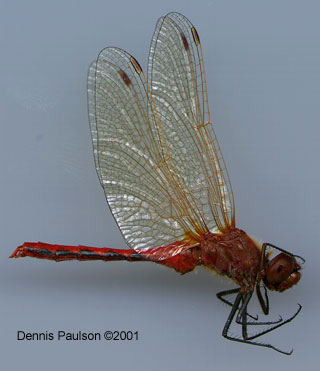
Sympetrum internum
(Cherry-faced Meadowhawk)
Order: Odonata
Suborder: Anisoptera
Order Description: Dragonflies
Family: Libellulidae
Family Description: Meadowhawk
Description:
Naiad- This is a small naiad with a length of 9/16 to 5/8 inch (14 to 15.5 mm). It is mottled green and brown in color. The abdomen has several slender, slightly curved hooks along the top, and the last two abdominal segments have a single, rear-facing spine on each side. The naiads of this species and those of the Black Meadowhawk (Sympetrum danae) are extremely difficult to tell apart.
Adult- This is a small dragonfly, with a length of 7/8 to 1 7/16 inches (21 to 36 mm). Mature males are bright red on the face and the top of the abdomen. The thorax is dark brownish black and unmarked, and the sides of the abdomen are marked with black triangles. The wings may be entirely clear or partially clouded with golden brown where they attach to the body, and the veins may appear reddish. Immature males and females are marked similarly, but the thorax is brownish or olive green.
Range:
This species is found from Alaska east to Hudson Bay, extending south through the U.S. from California east to Missouri and Pennsylvania. It occurs throughout Idaho.
Habitat:
This dragonfly can be found near marshy ponds and lakes, and near slow streams.
Adult Flight Season:
Early July to early October
Diet:
Naiad- Naiads feed on a wide variety of aquatic insects, such as mosquito larvae, other aquatic fly larvae, mayfly larvae, and freshwater shrimp. They will also eat very small fish and tadpoles.
Adult- The dragonfly will eat almost any soft-bodied flying insect including mosquitoes, flies, small moths, mayflies, and flying ants or termites.
Ecology:
The naiads live in debris on the bottom of ponds, lakes, and streams. They do not actively pursue prey but wait for it to pass by, a strategy which affords them protection from other predators. Naiads emerge as adults at night. Adults generally fly from early July to October. Hunting occurs from perches on rocks or bare branches. This species has a high tolerance for cold climates, and is found as far north as the Great Slave Lake in the Northwest Territories of Canada. The Latin name for this genus, Sympetrum, means "with rock" and refers to their habit of basking on rocks to absorb heat early in the day.
Reproduction:
The female flies with the male still attached after mating (a position called "in tandem") and lays her eggs in lakes and ponds by dipping the tip her abdomen on the surface of the water.
Conservation:
Populations are widespread, abundant, and secure.
| Global Rank: | G5 |
| State Rank: | S? |
References:
Corbet, P. S. 1999. Dragonflies: Behavior and Ecology of Odonata. Cornell University Press, Ithaca, New York, USA, 829pp.
Logan, E. R. 1967. The Odonata of Idaho. Unpublished M. S. thesis. University of Idaho, Moscow, Idaho, USA, 105 pp.
Needham, J. G. and M. J. Westfall. 1955. Dragonflies of North America. University of California Press, Berkely, California, USA, 615 pp.
Paulson, D. R. 1999. Dragonflies of Washington. Seattle Audubon Society, Seattle, Washington, USA, 32 pp.
Walker, E. M. and P. S. Corbet. 1975. The Odonata of Canada and Alaska, Vol. III. University of Toronto Press, Toronto, Ontario, Canada, 307 pp.
Written by Mark Lung and Stefan Sommer, 2001
Photos by Dennis Paulson, 2001
Design by Ean Harker, 2001.
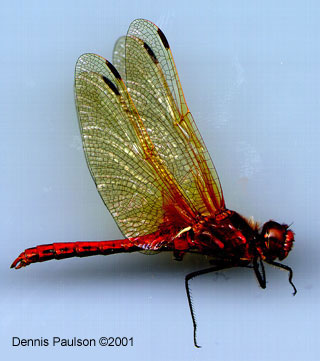
Sympetrum madidum
(Red-Veined Meadowhawk)
Order: Odonata
Suborder: Anisoptera
Order Description: Dragonflies
Family: Libellulidae
Family Description: Meadowhawk
Description:
Naiad- This is a small naiad with a length of 5/8 inch (16 mm). It is mottled green and brown in color. The abdomen has several slender, slightly curved hooks along the top, and the last two abdominal segments have a single, rear-facing spine on each side. The nymphs of this species and those of the Striped Meadowhawk (Sympetrum pallipes) are extremely difficult to tell apart.
Adult- This is a medium-sized dragonfly (but large for this genus) with a length of 1 5/8 to 1 13/16 inches (40 to 45 mm). The abdomen is quite slender. This species is distinguished from other Sympetrums by the gold to red clouding of its wings and red wing veins. Males are red on the face and abdomen, while the thorax is dark and marked with two yellow spots on each side. Females are yellowish brown. Each side of the thorax is marked with a pair of yellowish white stripes, and the top of the abdomen is marked with horizontal and vertical lines, making it appear much like a plaid pattern.
Range:
This species occurs from the Northwest Territories of Canada east to Manitoba, extending south into the U.S. to northern California, Idaho, and Montana. In Idaho, it has only been documented to occur in the southeastern part of the state.
Habitat:
This dragonfly can be found near shallow, marshy ponds and lakes.
Adult Flight Season:
Mid-June to mid-September
Diet:
Naiad- Naiads feed on a wide variety of aquatic insects, such as mosquito larvae, other aquatic fly larvae, mayfly larvae, and freshwater shrimp. They will also eat very small fish and tadpoles.
Adult- The dragonfly will eat almost any soft-bodied flying insect including mosquitoes, flies, small moths, mayflies, and flying ants or termites.
Ecology:
The naiads live in debris on the bottom of ponds and lakes. They do not actively pursue prey but wait for it to pass by, a strategy which affords them protection from other predators. Naiads emerge as adults at night. Although records are sparse, adults of this species are believed to fly from mid-June to mid-September. They hunt flying insects from perches on rocks or bare branches. The Latin name for this genus, Sympetrum, means "with rock" and refers to their habit of basking on rocks to absorb heat early in the day. This species seems to be relatively uncommon over most of its range.
Reproduction:
The female flies with the male still attached after mating (a position called "in tandem") and lays her eggs in shallow lakes and ponds by dipping the tip her abdomen on the surface of the water.
Conservation:
Populations are widespread, abundant, and secure.
| Global Rank: | G5 |
| State Rank: | S? |
References:
Corbet, P. S. 1999. Dragonflies: Behavior and Ecology of Odonata. Cornell University Press, Ithaca, New York, USA, 829pp.
Logan, E. R. 1967. The Odonata of Idaho. Unpublished M. S. thesis. University of Idaho, Moscow, Idaho, USA, 105 pp.
Needham, J. G. and M. J. Westfall. 1955. Dragonflies of North America. University of California Press, Berkely, California, USA, 615 pp.
Paulson, D. R. 1999. Dragonflies of Washington. Seattle Audubon Society, Seattle, Washington, USA, 32 pp.
Walker, E. M. and P. S. Corbet. 1975. The Odonata of Canada and Alaska, Vol. III. University of Toronto Press, Toronto, Ontario, Canada, 307 pp.
Written by Mark Lung and Stefan Sommer, 2001
Photos by Dennis Paulson, 2001
Design by Ean Harker, 2001.
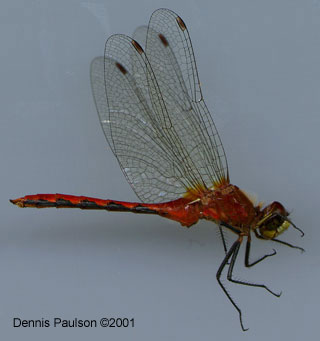
Sympetrum obtrusum
(White-Faced Meadowhawk)
Order: Odonata
Suborder: Anisoptera
Order Description: Dragonflies
Family: Libellulidae
Family Description: Meadowhawk
Description:
Naiad- This is a small naiad with a length of 5/8 inch (16 mm). It is mottled green and brown in color. The abdomen has several slender, slightly curved hooks along the top, and the last two abdominal segments have a single, rear-facing spine on each side. The naiads of this species and those of the Red-Veined Meadowhawk (Sympetrum madidum) and the Striped Meadowhawk (Sympetrum pallipes) are extremely difficult to tell apart.
Adult- This is a small dragonfly with a length of 1 1/4 to 1 9/16 inches (31 to 39 mm). Mature males have a yellowish white face, a dark thorax, and a shiny red abdomen marked with black triangles along each side. The wings are clear but may be clouded with yellowish brown where they attach to the body. The legs may appear yellowish and have black spines. Females and immature males are olive to golden brown and are marked similarly.
Range:
This species is found from the Northwest Territories of Canada east to Nova Scotia, extending south into the U.S. to Utah, Kansas, and Kentucky. In Idaho, it occurs throughout the state though less commonly in the southeast part of the state.
Habitat:
This dragonfly can be found near bogs, lakes, ponds, and ditches. They appear to prefer small, stagnant ponds.
Adult Flight Season:
Early July to mid-October
Diet:
Naiad- Naiads feed on a wide variety of aquatic insects, such as mosquito larvae, other aquatic fly larvae, mayfly larvae, and freshwater shrimp. They will also eat very small fish and tadpoles.
Adult- The dragonfly will eat almost any soft-bodied flying insect including mosquitoes, flies, small moths, mayflies, and flying ants or termites.
Ecology:
The naiads live in debris on the bottom of bogs, lakes, and ponds, and have a high tolerance for acidic waters. They do not actively pursue prey but wait for it to pass by, a strategy which affords them protection from other predators. The naiads emerge as adults at night. Adults generally fly from early July to mid-October. The adults of this species hunt flying insects from perches on rocks or bare branches. The Latin name for this genus, Sympetrum, means "with rock" and refers to their habit of basking on rocks to absorb heat early in the day.
Reproduction:
The female flies with the male still attached after mating (a position called "in tandem") and lays her eggs in bogs, lakes, and ponds by dipping the tip her abdomen on the surface of the water.
Conservation:
Populations are widespread, abundant, and secure.
| Global Rank: | G5 |
| State Rank: | S? |
References:
Corbet, P. S. 1999. Dragonflies: Behavior and Ecology of Odonata. Cornell University Press, Ithaca, New York, USA, 829pp.
Logan, E. R. 1967. The Odonata of Idaho. Unpublished M. S. thesis. University of Idaho, Moscow, Idaho, USA, 105 pp.
Needham, J. G. and M. J. Westfall. 1955. Dragonflies of North America. University of California Press, Berkely, California, USA, 615 pp.
Paulson, D. R. 1999. Dragonflies of Washington. Seattle Audubon Society, Seattle, Washington, USA, 32 pp.
Walker, E. M. and P. S. Corbet. 1975. The Odonata of Canada and Alaska, Vol. III. University of Toronto Press, Toronto, Ontario, Canada, 307 pp.
Written by Mark Lung and Stefan Sommer, 2001
Photos by Dennis Paulson, 2001
Design by Ean Harker, 2001.
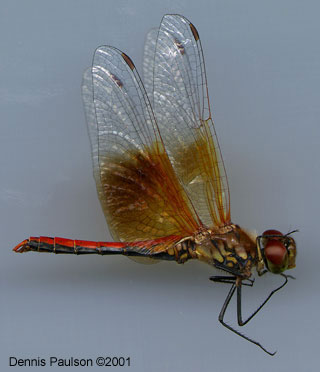
Sympetrum occidentale
(Western Meadowhawk)
Order: Odonata
Suborder: Anisoptera
Order Description: Dragonflies
Family: Libellulidae
Family Description: Meadowhawk
Description:
Naiad- This is a small naiad with a length of 5/8 inch (16 mm). It is mottled green and brown in color. The abdomen has several small hooks along the top, and the last two abdominal segments have a small, single, rear-facing spine on each side.
Adult- This is a small dragonfly with a length of 1 1/4 to 1 5/8 inches (31 to 40 mm). The key distinguishing feature is a cloudy, orange-brown band that covers the inner half of each wing. The band may appear darker towards the outside. Males have a yellowish thorax, marked with wavy black lines on each side, and a red to reddish brown abdomen, marked with black along the bottom edge of each side. Females are olive to golden brown and marked similarly.
Range:
This species is found from British Columbia east to Alberta, extending south into the U.S. to California east to Utah. It is common throughout Idaho.
Habitat:
This dragonfly can be found in most types of ponds and lakes.
Adult Flight Season:
Mid-June to mid-October
Diet:
Naiad- Naiads feed on a wide variety of aquatic insects, such as mosquito larvae, other aquatic fly larvae, mayfly larvae, and freshwater shrimp. They will also eat very small fish and tadpoles.
Adult- The dragonfly will eat almost any soft-bodied flying insect including mosquitoes, flies, small moths, mayflies, and flying ants or termites.
Ecology:
The naiads live in submerged vegetation. They do not actively pursue prey but wait for it to pass by, a strategy which affords them protection from other predators. Naiads emerge as adults at night. Adults generally fly from mid-June to mid-October, resulting in a long flight season in Idaho which lasts almost four months. The adults of this species hunt flying insects from perches on rocks or bare branches. The Latin name for this genus, Sympetrum, means "with rock" and refers to their habit of basking on rocks to absorb heat early in the day. This species has been observed being captured and eaten by larger species of dragonflies, especially the Olive Clubtail (Stylurus olivaceous) at Massacre Rocks State Park, near American Falls, Idaho.
Reproduction:
The female flies with the male still attached after mating (a position called "in tandem") and lays her eggs in lakes and ponds by dipping the tip her abdomen on the surface of the water.
Conservation:
Populations are widespread, abundant, and secure.
| Global Rank: | G5 |
| State Rank: | S? |
References:
Corbet, P. S. 1999. Dragonflies: Behavior and Ecology of Odonata. Cornell University Press, Ithaca, New York, USA, 829pp.
Logan, E. R. 1967. The Odonata of Idaho. Unpublished M. S. thesis. University of Idaho, Moscow, Idaho, USA, 105 pp.
Needham, J. G. and M. J. Westfall. 1955. Dragonflies of North America. University of California Press, Berkely, California, USA, 615 pp.
Paulson, D. R. 1999. Dragonflies of Washington. Seattle Audubon Society, Seattle, Washington, USA, 32 pp.
Walker, E. M. and P. S. Corbet. 1975. The Odonata of Canada and Alaska, Vol. III. University of Toronto Press, Toronto, Ontario, Canada, 307 pp.
Written by Mark Lung and Stefan Sommer, 2001
Photos by Dennis Paulson, 2001
Design by Ean Harker, 2001.
HTML by Marty Peck, 2001.
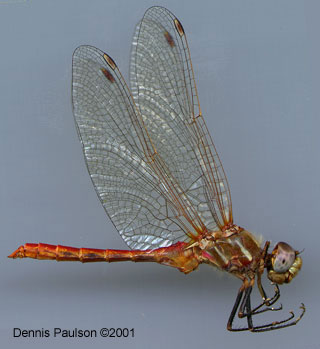
Sympetrum pallipes
(Striped Meadowhawk)
Order: Odonata
Suborder: Anisoptera
Order Description: Dragonflies
Family: Libellulidae
Family Description: Meadowhawk
Description:
Naiad- This is a small naiad with a length of 5/8 to 3/4 inch (16 to 18 mm). It is mottled green and brown in color. The abdomen has several slender, slightly curved hooks along the top, and the last two abdominal segments have a single, rear-facing spine on each side. The naiads of this species and those of the Red-Veined Meadowhawk (Sympetrum madidum) and the White-Faced Meadowhawk (Sympetrum obtrusum) are extremely difficult to tell apart.
Adult- This is a small dragonfly with a length of 1 3/8 to 1 1/2 inches (34 to 38 mm). Mature males are mostly red while immature males and females are greenish yellow to olive green. All are marked on each side of the thorax with a pair of diagonal yellowish stripes. The wings are clear but may occasionally be clouded with yellow where they attach to the body. The legs may appear yellow and have black spines.
Range:
This species is found from British Columbia east to Alberta, extending south into the U.S. to California east to Texas. It is common throughout Idaho.
Habitat:
This dragonfly can be found near small, often stagnant, semi-permanent ponds and ditches.
Adult Flight Season:
Early July to early October
Diet:
Naiad- Naiads feed on a wide variety of aquatic insects, such as mosquito larvae, other aquatic fly larvae, mayfly larvae, and freshwater shrimp. They will also eat very small fish and tadpoles.
Adult- The dragonfly will eat almost any soft-bodied flying insect including mosquitoes, flies, small moths, mayflies, and flying ants or termites.
Ecology:
The naiads live in debris of the bottom of ponds. They do not actively pursue prey but wait for it to pass by, a strategy which affords them protection from other predators. The naiads emerge as adults at night. Adults fly from early July to early October. They hunt flying insects from perches on rocks or bare branches. The Latin name for this genus, Sympetrum, means "with rock" and refers to their habit of basking on rocks to absorb heat early in the day.
Reproduction:
The female flies with the male still attached after mating (a position called "in tandem") and lays her eggs in ponds by dipping the tip her abdomen on the surface of the water.
Conservation:
Populations are widespread, abundant, and secure.
| Global Rank: | G5 |
| State Rank: | S? |
References:
Corbet, P. S. 1999. Dragonflies: Behavior and Ecology of Odonata. Cornell University Press, Ithaca, New York, USA, 829pp.
Logan, E. R. 1967. The Odonata of Idaho. Unpublished M. S. thesis. University of Idaho, Moscow, Idaho, USA, 105 pp.
Needham, J. G. and M. J. Westfall. 1955. Dragonflies of North America. University of California Press, Berkely, California, USA, 615 pp.
Paulson, D. R. 1999. Dragonflies of Washington. Seattle Audubon Society, Seattle, Washington, USA, 32 pp.
Walker, E. M. and P. S. Corbet. 1975. The Odonata of Canada and Alaska, Vol. III. University of Toronto Press, Toronto, Ontario, Canada, 307 pp.
Written by Mark Lung and Stefan Sommer, 2001
Photos by Dennis Paulson, 2001
Design by Ean Harker, 2001.
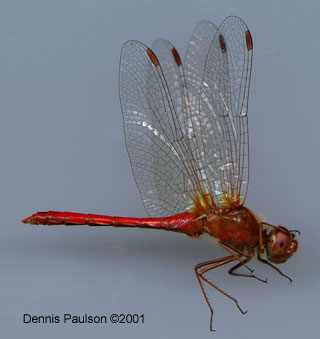
Sympetrum vicinum
(Yellow-Legged Meadowhawk)
Order: Odonata
Suborder: Anisoptera
Order Description: Dragonflies
Family: Libellulidae
Family Description: Meadowhawk
Description:
Naiad- This is a small naiad, with a length of 1/2 to 5/8 inch (12 to 15 mm). It is mottled green and brown in color. The abdomen has several large hooks along the top, and the last two abdominal segments have a single, large, rear-facing spine on each side. This species has bigger eyes than other members of this genus.
Adult- This is a small dragonfly, with a length of 1 3/16 to 1 3/8 inches (30 to 35 mm). The wings are mostly clear but have a small patch of yellowish to orange clouding at the base of each hindwing. Mature males are brownish black on the face and thorax and have a red abdomen, while immature males have a yellow thorax and a yellowish brown abdomen. Females have a brown thorax and a brownish red abdomen. As its common name implies, the legs of the adults are yellow.
Range:
This species has two separate populations in North America. One is found from Ontario east to Nova Scotia, extending south into the U.S. to Texas and Florida. The other population occurs in British Columbia, Washington, and Idaho. In Idaho, it is found in the northern half of the state.
Habitat:
This dragonfly can be found near lakes and ponds with marshy borders.
Adult Flight Season:
Early August to late October
Diet:
Naiad- Naiads feed on a wide variety of aquatic insects, such as mosquito larvae, other aquatic fly larvae, mayfly larvae, and freshwater shrimp. They will also eat very small fish and tadpoles.
Adult- The dragonfly will eat almost any soft-bodied flying insect including mosquitoes, flies, small moths, mayflies, and flying ants or termites.
Ecology:
The naiads live in the debris of the bottoms of lakes and ponds. They do not actively pursue prey but wait for it to pass by, a strategy which affords them protection from other predators. The naiads emerge, or make the transition to adult dragonflies, at night. Adults fly from early August through October. This species flies later in the fall than any other species in the Northwest, with observations as late as October 29 in Idaho, and into November in Washington. The adults of this species hunt flying insects from perches on rocks or bare branches. The Latin name for this genus, Sympetrum, means "with rock" and refers to their habit of basking on rocks to absorb heat early in the day. This dragonfly is extremely abundant where it occurs, with large numbers of pairs flying and laying eggs in tandem.
Reproduction:
The female flies with the male still attached after mating (a position called "in tandem") and lays her eggs near the shoreline of lakes and ponds by dipping the tip her abdomen on the surface of the water. Large-mouth bass (Micropterus salmoides) have been observed following mated pairs of dragonflies as they fly just above the surface, and then eating them as they touch the surface to lay eggs.
Conservation:
Populations are widespread, abundant, and secure.
| Global Rank: | G5 |
| State Rank: | S? |
References:
Corbet, P. S. 1999. Dragonflies: Behavior and Ecology of Odonata. Cornell University Press, Ithaca, New York, USA, 829pp.
Logan, E. R. 1967. The Odonata of Idaho. Unpublished M. S. thesis. University of Idaho, Moscow, Idaho, USA, 105 pp.
Needham, J. G. and M. J. Westfall. 1955. Dragonflies of North America. University of California Press, Berkely, California, USA, 615 pp.
Paulson, D. R. 1999. Dragonflies of Washington. Seattle Audubon Society, Seattle, Washington, USA, 32 pp.
Walker, E. M. and P. S. Corbet. 1975. The Odonata of Canada and Alaska, Vol. III. University of Toronto Press, Toronto, Ontario, Canada, 307 pp.
Written by Mark Lung and Stefan Sommer, 2001
Photos by Dennis Paulson, 2001
Design by Ean Harker, 2001.
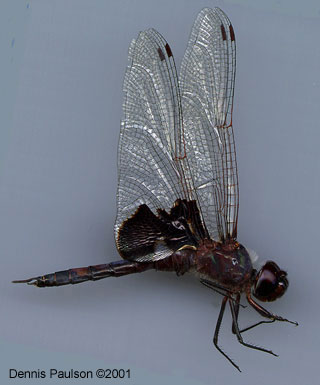
Tramea lacerata
(Black Saddlebags)
Order: Odonata
Suborder: Anisoptera
Order Description: Dragonflies
Family: Libellulidae
Family Description: Saddlebags
Description:
Naiad- This is a medium to large naiad, with a length of 15/16 to 1 inch (24 to 25 mm). It is pale green and marked with light brown. The head is large and the eyes are big. The last abdominal segments each have a single, large, flattened and slightly curved spine on either side.
Adult- This is a large dragonfly with a length of 2 to 2 3/8 inches (50 to 55 mm). It is largely black with hints of metallic royal blue. It has a distinctive wavy black band of black spanning the width of each hindwing near where it attaches to the body, which gives it a humpbacked appearance in flight. The hindwings are triangular and noticeably broad.
Range:
This species is found from southern Washington east across the U.S. to Massachusetts, extending south to California, Texas, and Florida. It also occurs in Mexico and the Hawaiian Islands. In Idaho, it occurs throughout the Snake River Plain from Twin Falls west to the Oregon border, and north along the Snake River to Lewiston.
Habitat:
This dragonfly can be found near ponds and lakes with abundant aquatic vegetation.
Adult Flight Season:
Early July to early October
Diet:
Naiad- Naiads feed on a wide variety of aquatic insects, such as mosquito larvae, other aquatic fly larvae, mayfly larvae, and freshwater shrimp. They will also eat very small fish and tadpoles.
Adult- The dragonfly will eat almost any soft-bodied flying insect including mosquitoes, flies, small moths, mayflies, and flying ants or termites.
Ecology:
The naiads live in debris and submerged vegetation on the bottom of ponds and lakes and actively pursue prey. Adults generally fly from early July to early October. This species can be observed migrating south in August and September, often with the Common Green Darner (Anax junius) and the Variegated Meadowhawk (Sympetrum corruptum). The adults that appear in Idaho in the early part of the flight season generally emerged in the southern portion of their range and have migrated north. In Idaho they produce a successive generation that emerges later in the summer to early fall and migrates south, where it again reproduces.. The adults hunt throughout the day primarily while flying. When they do perch, they generally hang vertically on the underside of branches or twigs, rather than sitting on top like most members of this family. This dragonfly appears to be deeply suspicious of humans with nets and so is often underrepresented in collections from areas where it is quite common.
Reproduction:
The female flies with the male still attached after mating (a position called "in tandem") and lays her eggs in lakes and ponds by dipping the tip her abdomen on the surface of the water. However, the male releases the female just before her abdomen touches the water, and then grabs her again with his abdominal appendages as she rises. In this way, he avoids being eaten by fish while still preventing other males from mating with his chosen female.
Conservation:
Populations are widespread, abundant, and secure.
| Global Rank: | G5 |
| State Rank: | S? |
References:
Corbet, P. S. 1999. Dragonflies: Behavior and Ecology of Odonata. Cornell University Press, Ithaca, New York, USA, 829pp.
Logan, E. R. 1967. The Odonata of Idaho. Unpublished M. S. thesis. University of Idaho, Moscow, Idaho, USA, 105 pp.
Needham, J. G. and M. J. Westfall. 1955. Dragonflies of North America. University of California Press, Berkely, California, USA, 615 pp.
Paulson, D. R. 1999. Dragonflies of Washington. Seattle Audubon Society, Seattle, Washington, USA, 32 pp.
Walker, E. M. and P. S. Corbet. 1975. The Odonata of Canada and Alaska, Vol. III. University of Toronto Press, Toronto, Ontario, Canada, 307 pp.
Written by Mark Lung and Stefan Sommer, 2001
Photos by Dennis Paulson, 2001
Design by Ean Harker, 2001.
